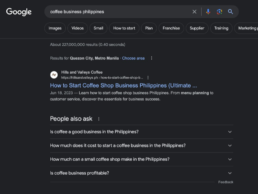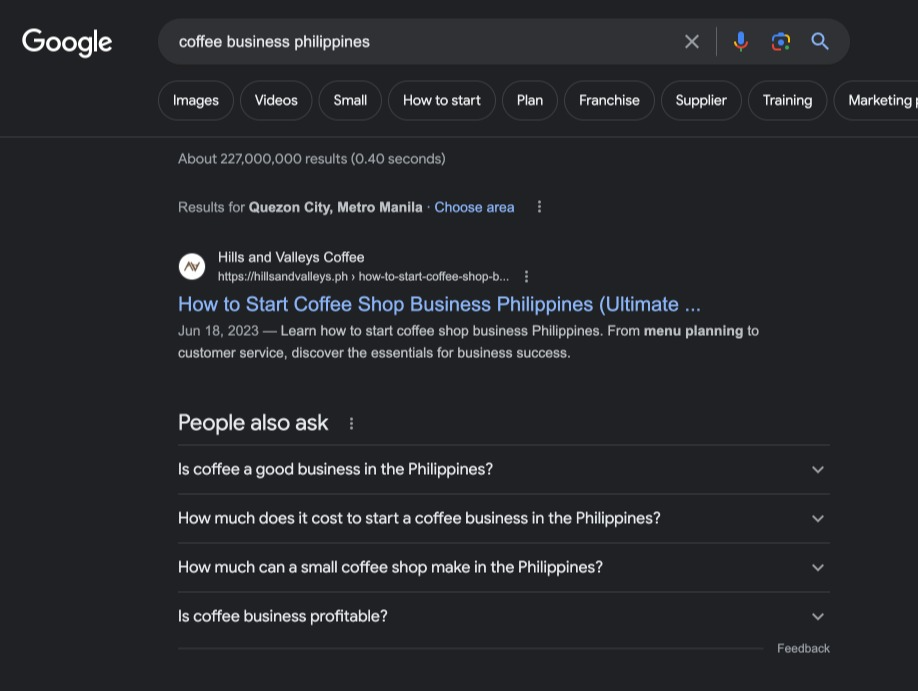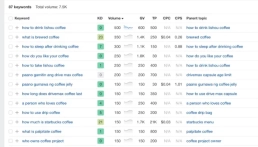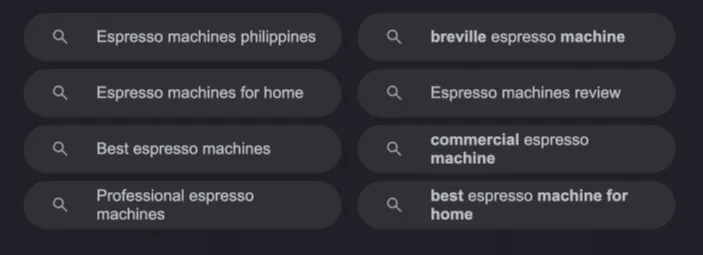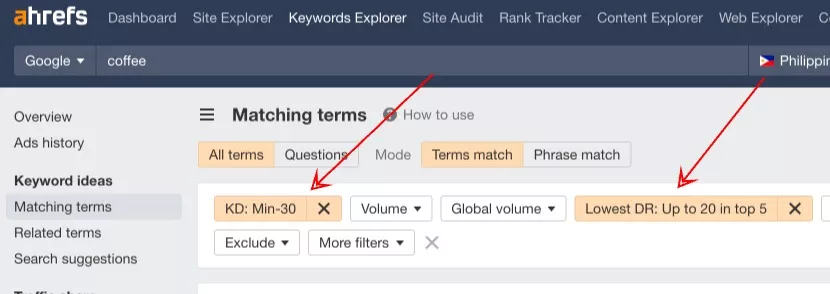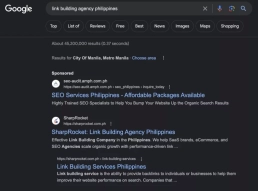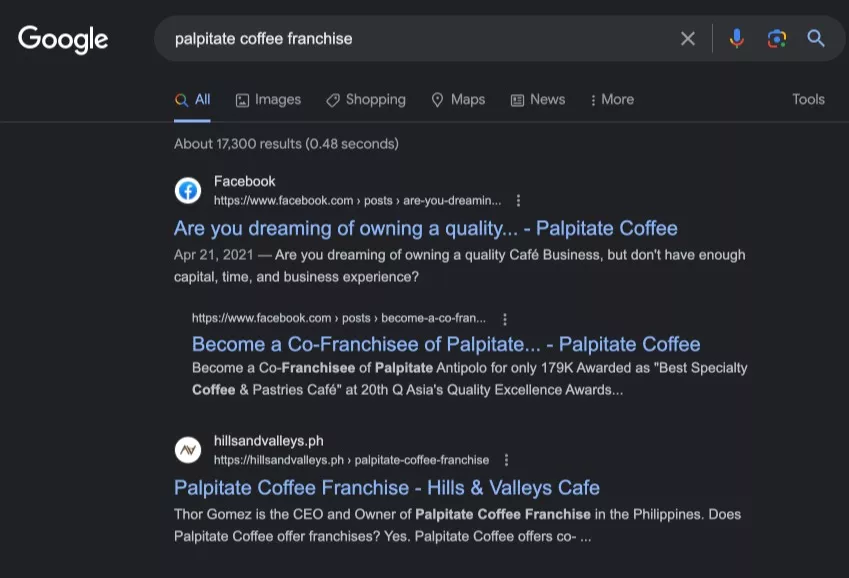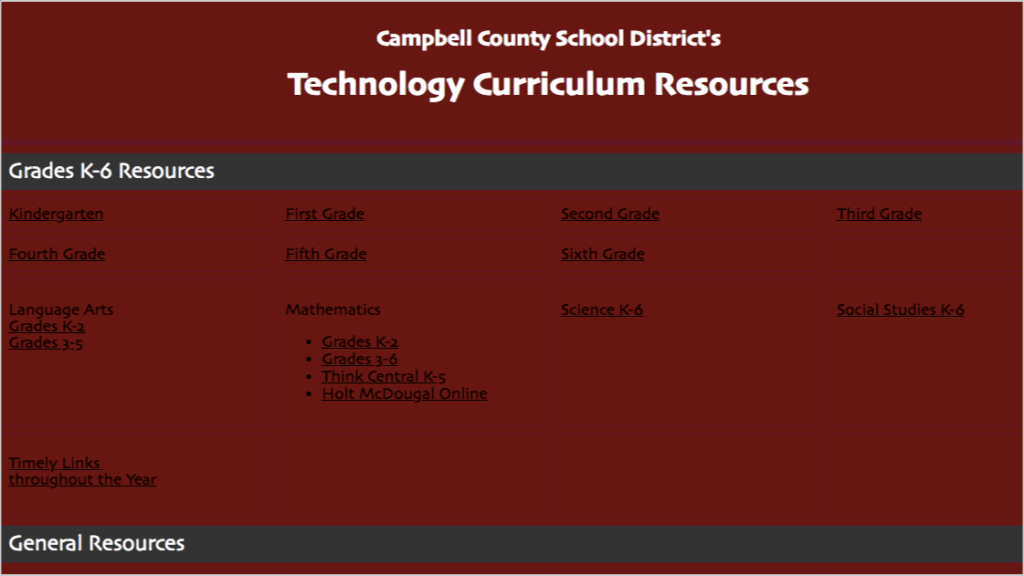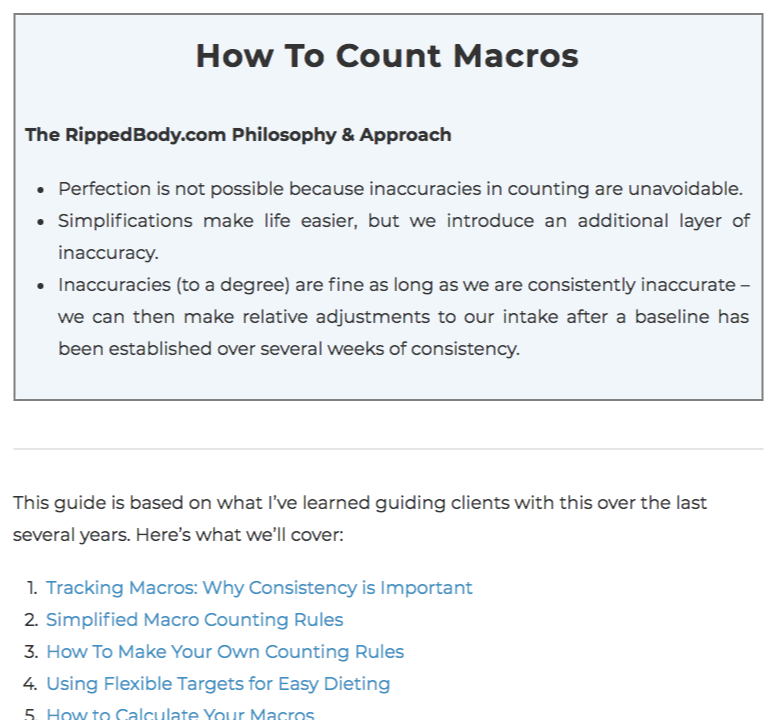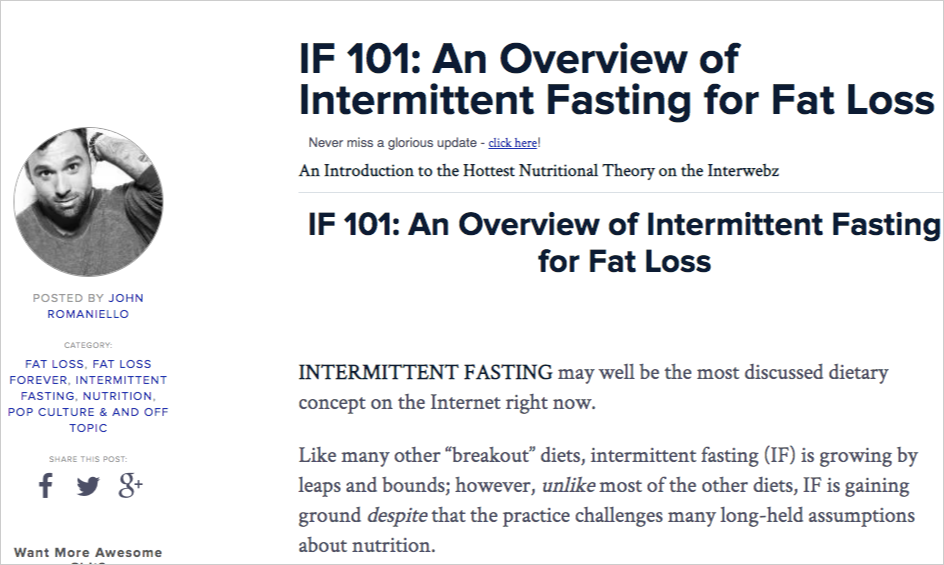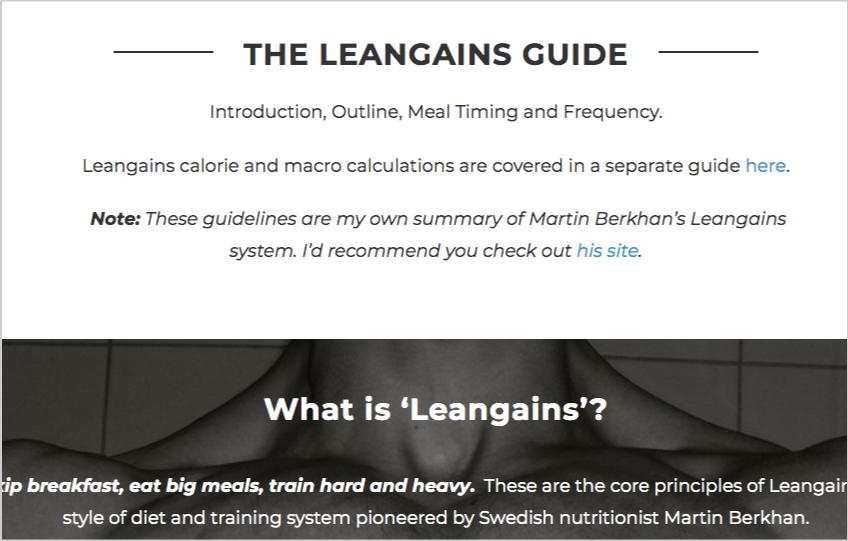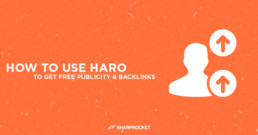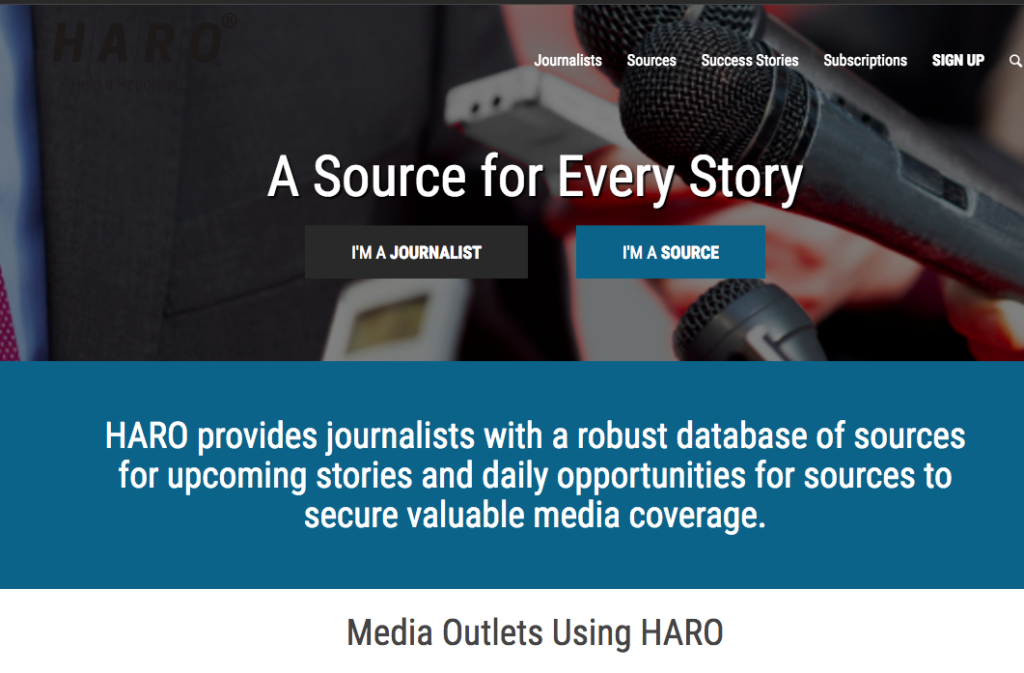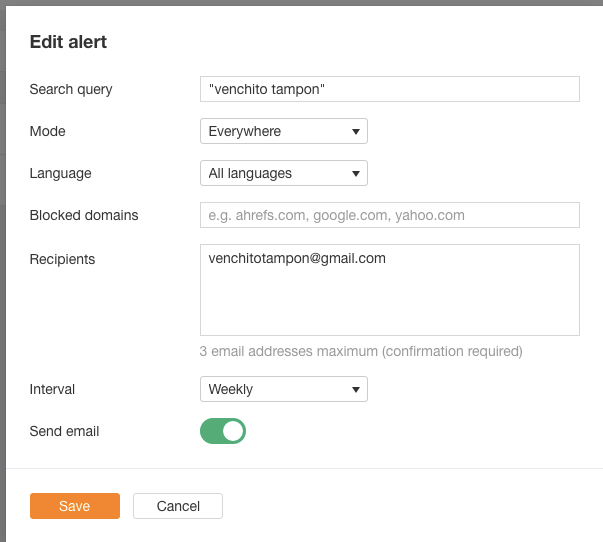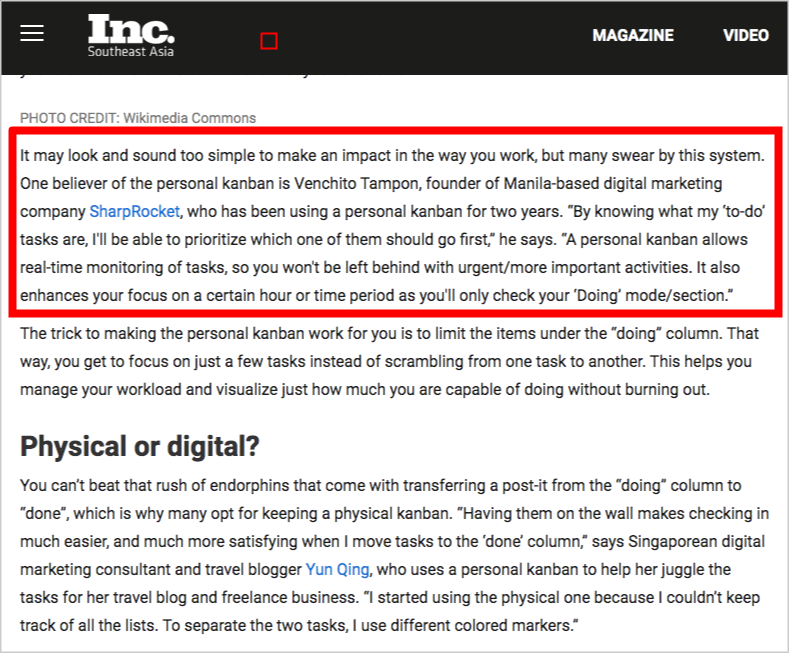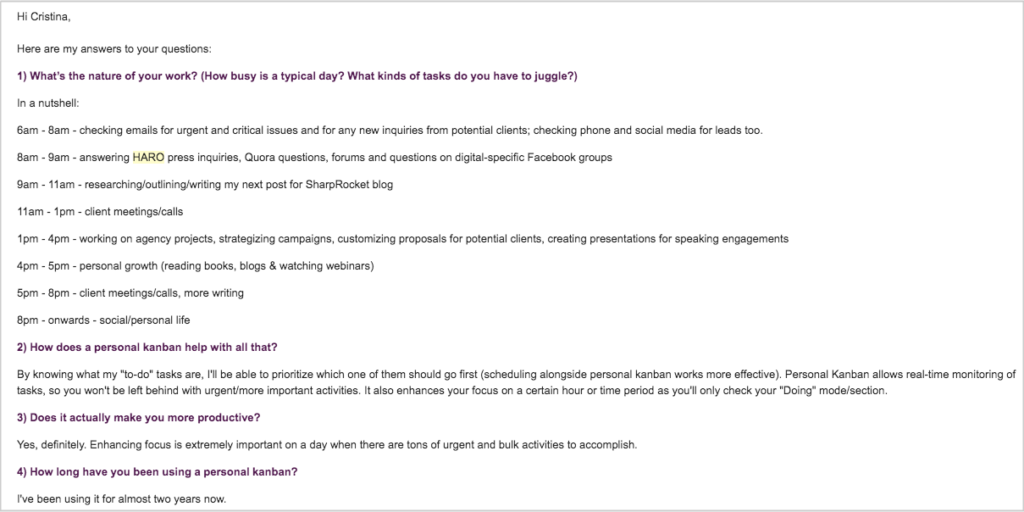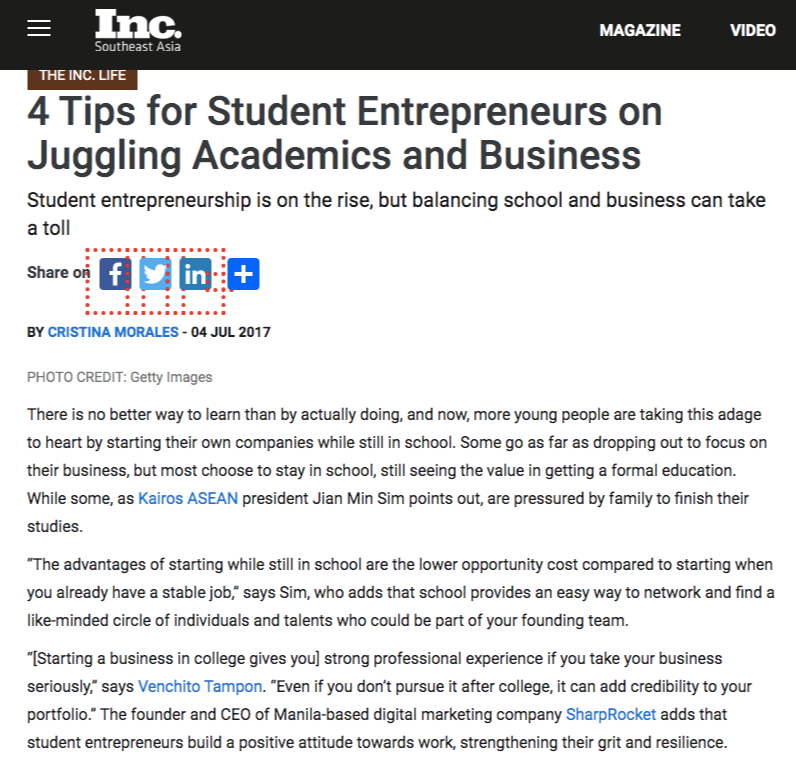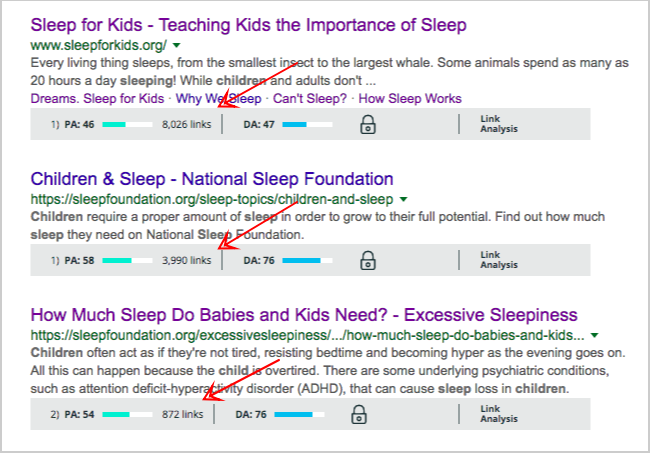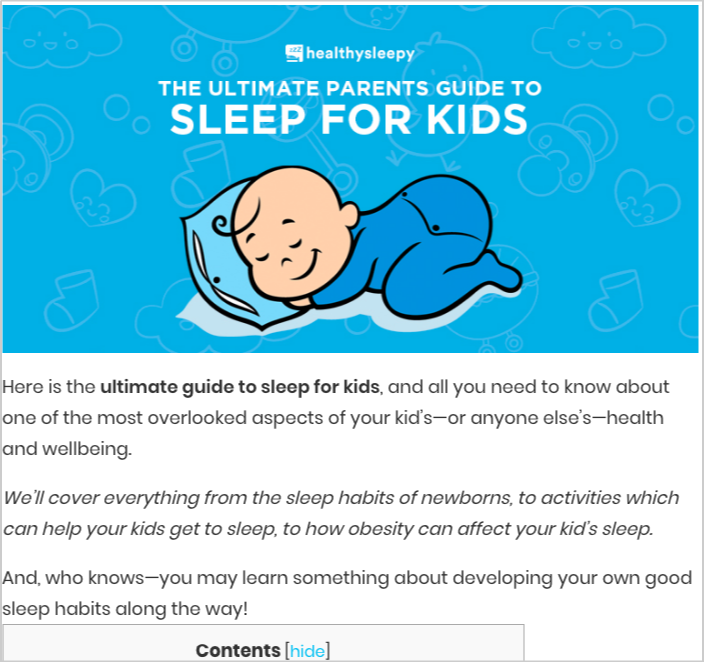How to Write Content That Ranks
Content writing has two main goals: to satisfy web users with what they are looking for and assisting businesses with their online marketing objectives.
Most online marketers hit the first one. However, we rarely see content marketing campaigns focusing on helping businesses drive results.
Learning to write content that ranks isn’t easy, which becomes leverage for high-level content marketers to differentiate their work from their contemporaries.
They are given that they don’t only write for publishing's sake but also provide value to clients by ranking content for their target keywords, which drives significant organic traffic and conversions for their website/s.
In this guide, I’ll walk you through my step-by-step process of writing content that ranks. I’ve used it for our clients, our link building blog (as a test), brick-and-mortar businesses, and eCom site.
How to Write Content That Ranks (6 Simple Steps)
1. Choose a Keyword With Weaker Competitors
Without a target keyword, you can’t rank content on Google’s search engine results pages (SERPs).
By having a keyword on the most critical places on your page, search engines can quickly determine the relevance and context of your content.
However, not all keywords are worth pursuing.
The most frustrating part of content marketing is creating comprehensive content about a specific topic. Yet, you won’t have a chance to rank, given the level of competition among its ranking pages.
I always recommend going after keywords where your site can have the best fight on Google’s SERPs.
The more authoritative the websites that rank from a Domain Rating (DR) perspective, the harder it is to rank because you need many backlinks.
You can use Ahrefs to see weaker spots on Google’s SERPs quickly.
If you start with Keyword Explorer, filter the list of keywords by a DR number to get keywords with weaker competitors.
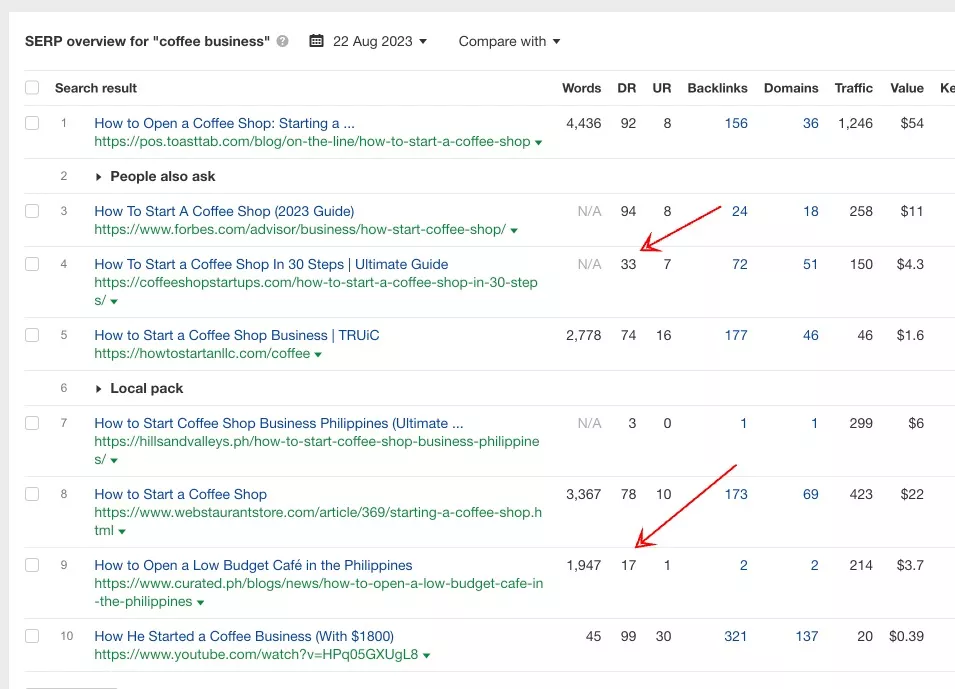
You can also use Ahrefs’ Content Explorer to generate content ideas for your blog. Use the same filter to see lower-authority pages.
Collate all these keywords and content ideas in a spreadsheet and later choose which one you’d want to write content about.
You can also populate your list by checking Google autocomplete or related keywords at the end of Google’s SERPs.
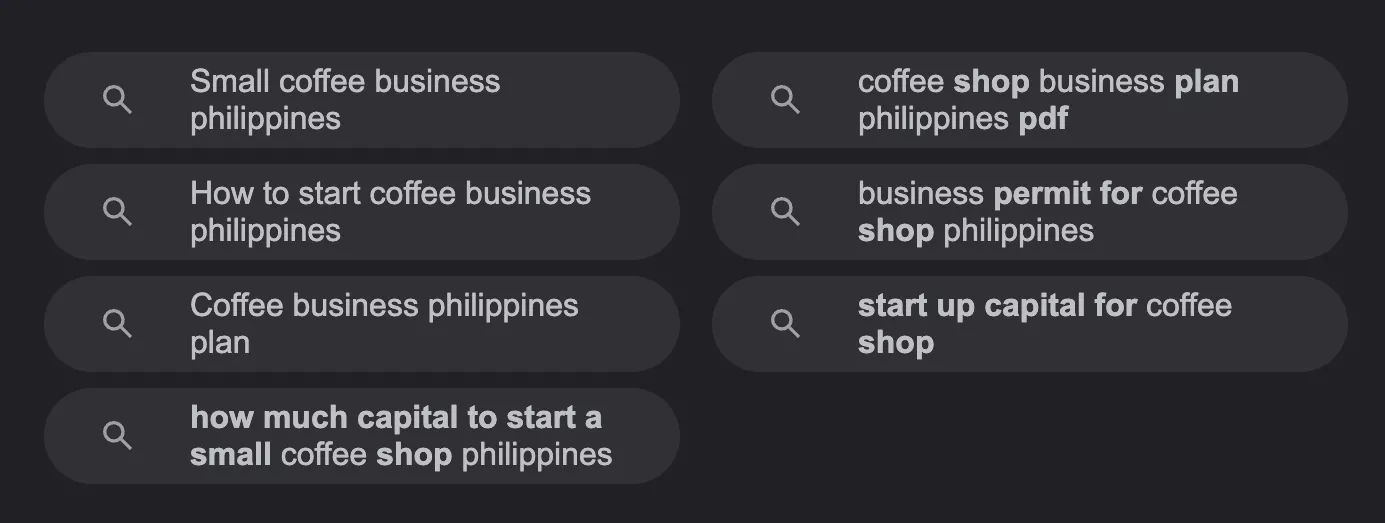
Most of the keywords you’ll find here don’t have high search volume, yet they are easier to rank with solid content.
The main objective in finding keywords with weaker competitors is to quickly rank for them with your content so you can build enough momentum for your SEO campaign. Or, if you’re servicing SEO clients, you can send initial reports of quick SEO wins via ranking for long-tail keywords instead of eyeing for head terms with no chances of winning (initially).
In my recent post on how to get your business on top of Google search, I’ve mentioned the importance of targeting long tail keywords.
The compiled constant effect of ranking for multiple keywords at the start of an SEO campaign boosts momentum to go after other keywords with a little stronger competition.
2. Do a search intent analysis for the keyword.
Most SEOs should have noticed this part of the process, going straight to writing content for the keyword.
Search intent analysis is crucial in understanding what the searchers are looking for and how you can create the best content to serve their needs (intent).
There are four main types of search intent:
- Informational (Awareness) - the search user wants to learn about a topic. (e.g., how do espresso machines work)
- Navigational (Interest) - the search user is curious about a particular brand or is looking for a specific brand/page (e.g., Ahrefs login)
- Commercial Investigation (Desire) - the search user is looking to solve a problem (e.g., best commercial espresso machines)
- Transactional (Action) - the search user wants to take an action or purchase a product/service (e.g., buy espresso machines).
Figure out the search intent type of a keyword.
Go even further. Do a Google search for the keyword. See the content format of each top-ranking page.
For instance, Google favors “how-to” guides for the key phrase, “coffee business Philippines”.
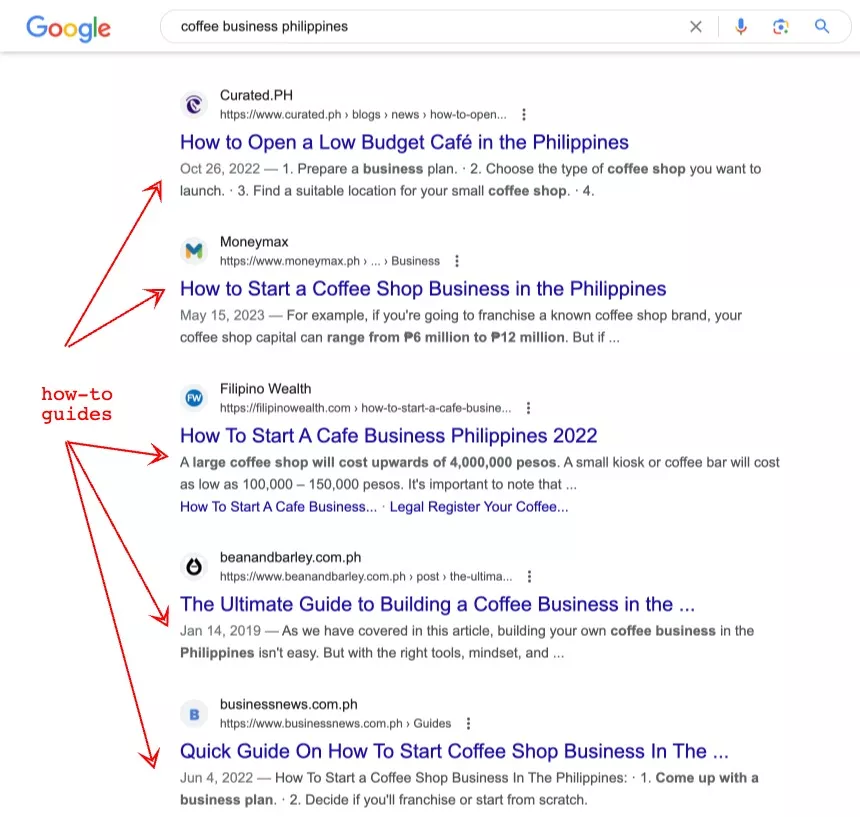
So, writing content that ranks for this keyword requires a comprehensive step-by-step process on how to start a coffee shop business.
3. Plan your content.
By planning your content, you eliminate all the unnecessary stuff and include the best points, structure, and flow that will best satisfy your readers.
You do that by first researching your top competing pages.
You want to see what makes the top-ranking pages deserving to rank for the keyword. Check and see how well-optimized the articles are.
I use the Detailed tool to see their basic outline quickly.
I’ve taken note of all headings and subheadings for the top 3 rankings articles. Then, I create a master outline combining all these headings for my content.
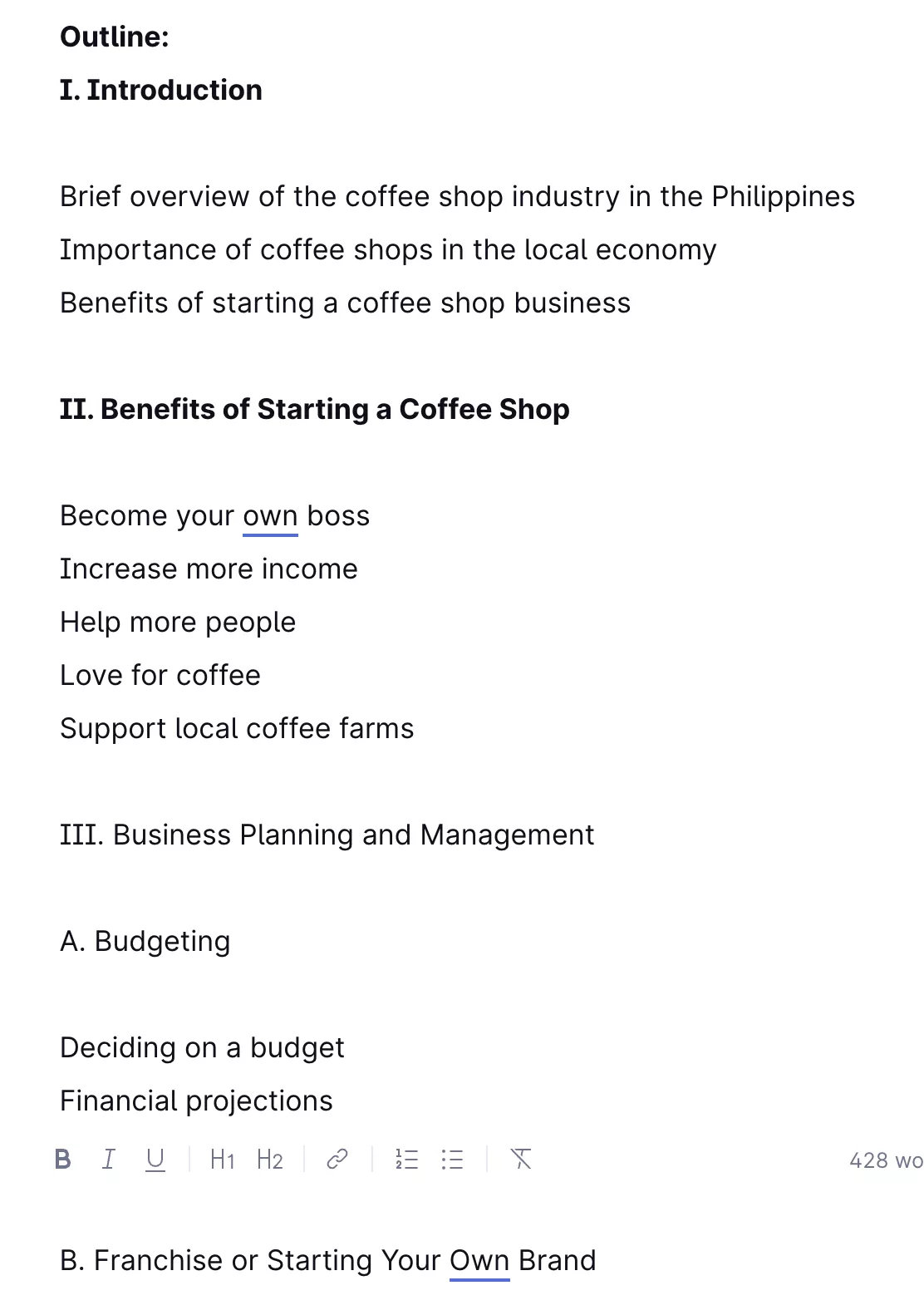
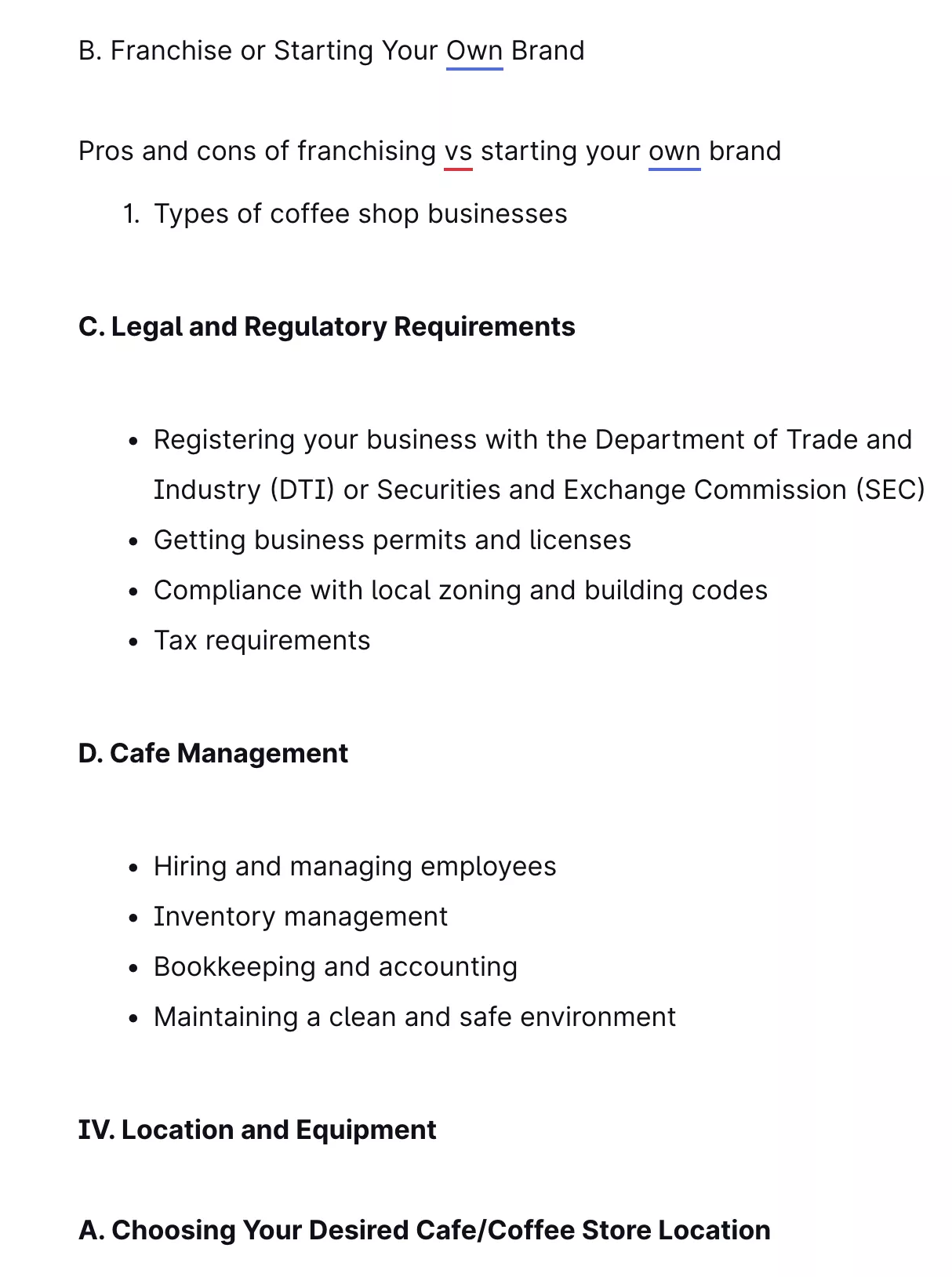
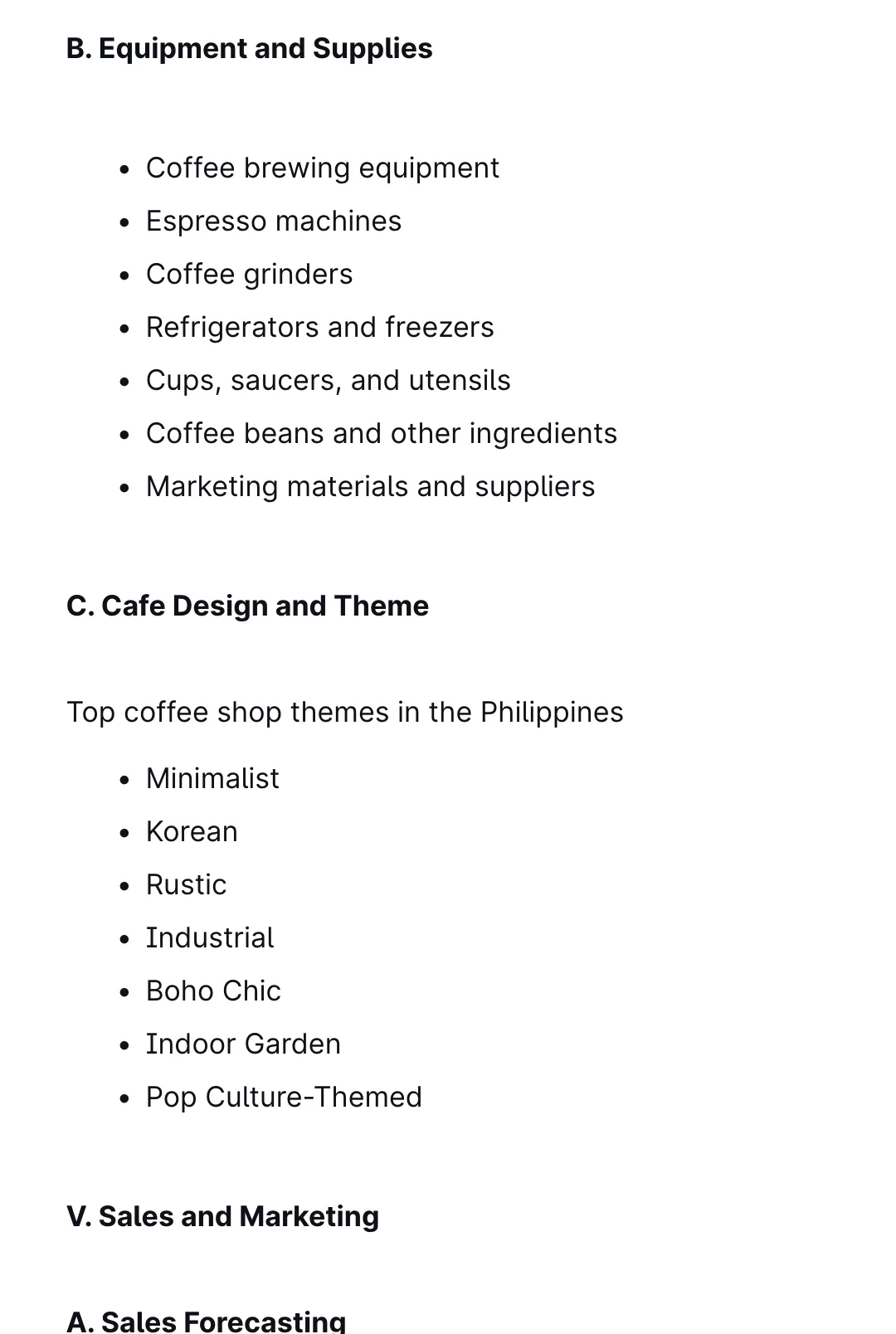
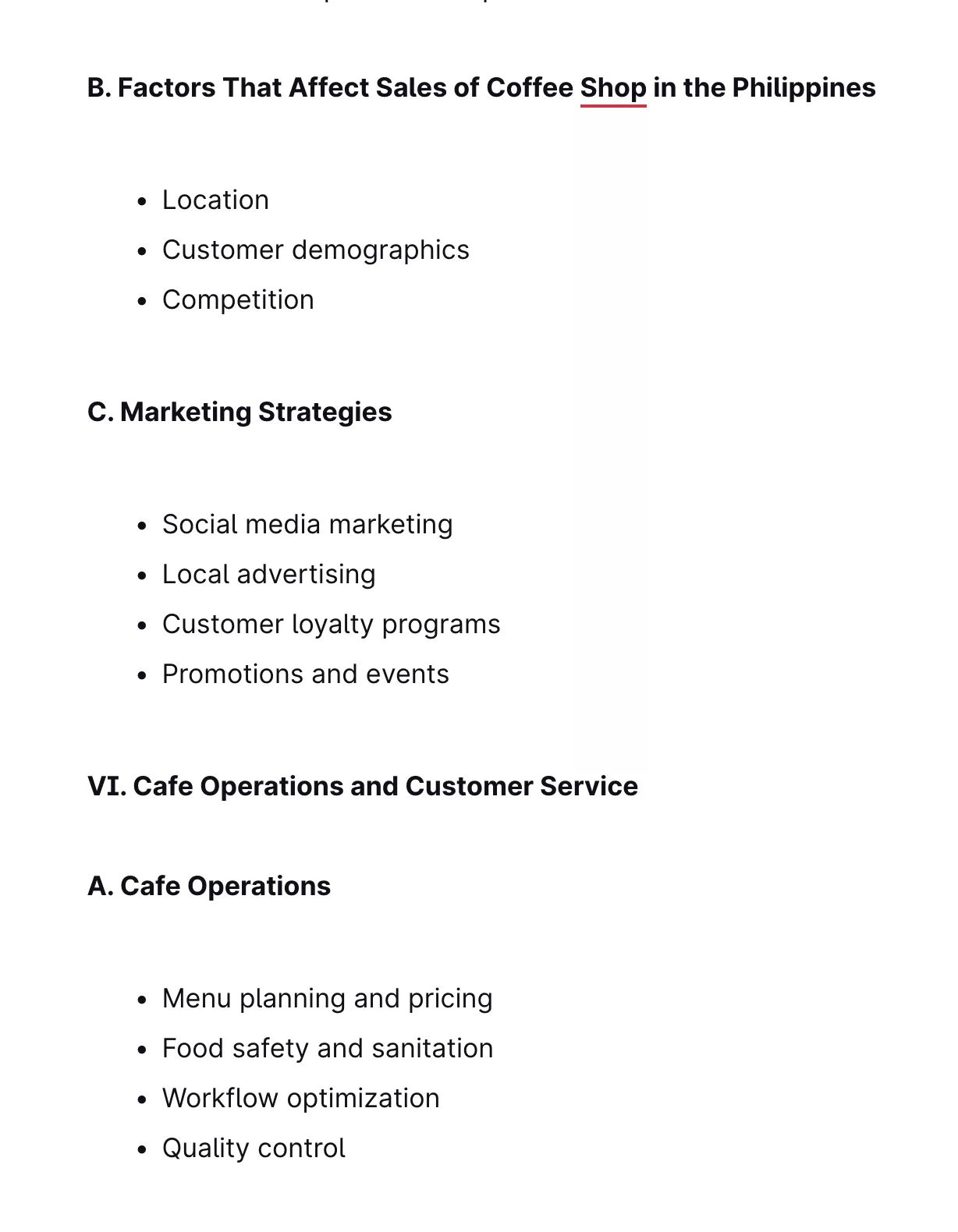
I even add unique headings missing from these articles that are useful for my readers.
You can check related searches at the bottom of the search engine results pages (SERPs) to make it more comprehensive. These are topics that Google finds relevant to the keyword you’re targeting.
Aim to achieve the average word count for the keyword by checking the top 3 ranking articles. Detailed also has an overview section for its word count.
Create a content brief with target keywords, LSI keywords, and an outline.
Recommending resources for creating content briefs:
4. Write with expertise and experience.
Establish expertise and experience in your content.
Google recognizes that users prefer to receive information from only reliable sources. In recent years, the search engine has focused on this issue with its Search Quality Evaluator Guidelines, a 150-page document used by Google’s search-qualified evaluators who are actual humans rather than an algorithm.
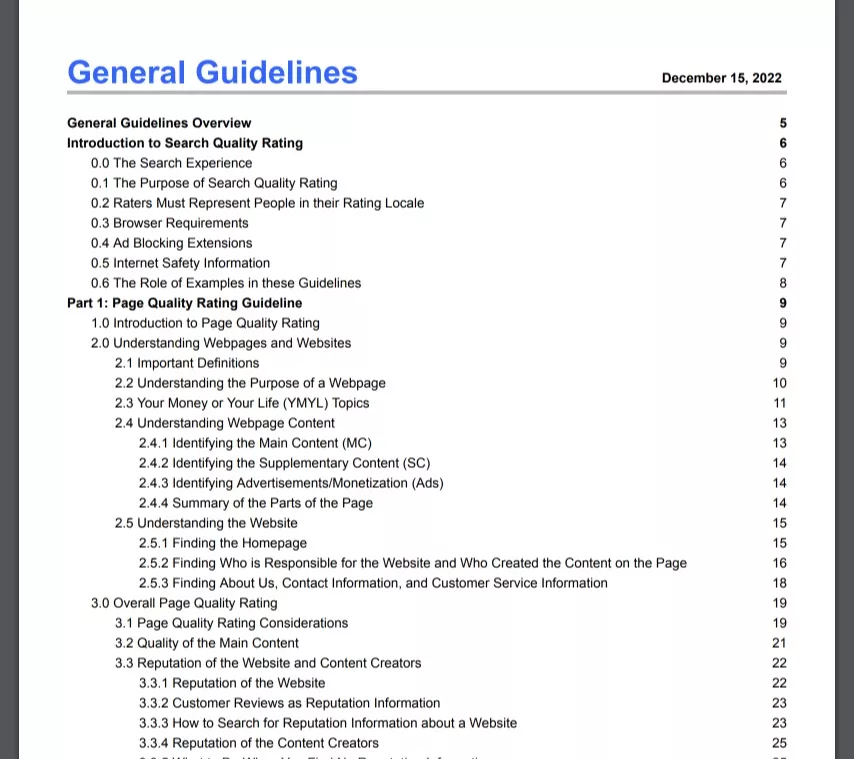
The initial step to writing content with expertise is to have a good introduction.
Hook your readers in the first lines of the page.
Give them the reason why they should be reading your content.
For instance, in my guide on how to start a coffee shop in the Philippines, I start the content with statistics proving how profitable and in-demand a coffee shop business is. This gives a primary reason for readers to read the how-to guide.
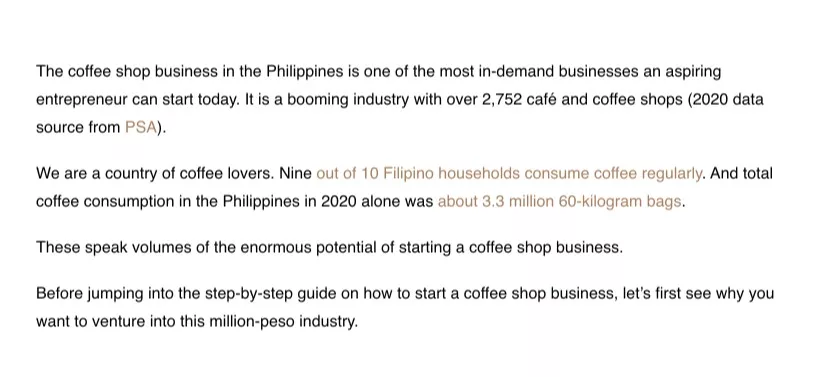
Place the value above the fold.
Here are some tips on writing introduction paragraphs from Matt Diggity:
- Match it with the searcher’s buying cycle.
- Educate with facts.
- Appeal to the emotion of fear to continue reading. (e.g., DUI cases that don’t have legal representation typically have 25% more expensive fees and license revocations of twice as long).
- Tease your article’s content about what they are about to read.
- Establish why you’re trustworthy and authority in writing about the topic.
Once you’ve written an introduction, your obvious next step is to write the meat of the content.
Essentially, we’ve included in our processes a huge percentage of the experience of the authors/writers in their SEO content, which significantly increases the credibility and ranking potential of the page.
Identify a unique differentiating angle.
See how your competitors attack their content writing. Determine a unique angle where you can bring internal expertise into your content, differentiating you from all other ranking pages.
For instance, we’ve tested products to create the “best espresso machines in the Philippines”. By testing it first-hand, we have enough information to conclude which espresso machines best fit a specific target audience (i.e., baristas, home coffee lovers, etc.).
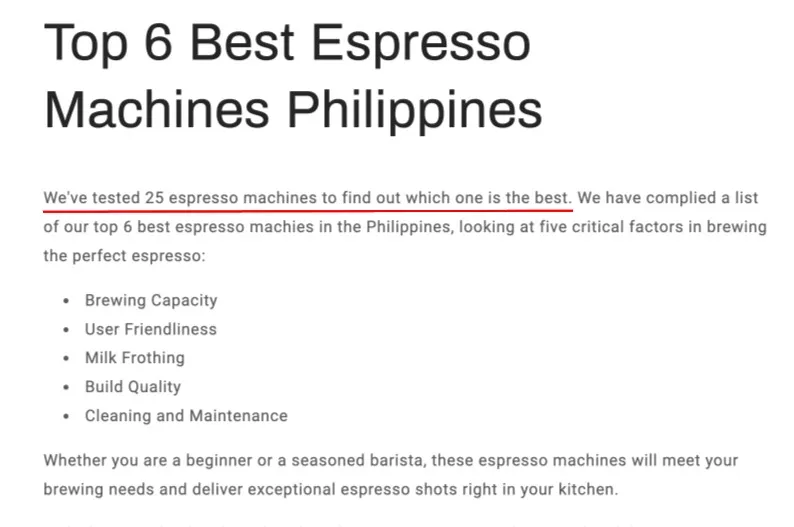
Another example is we added one recommendation of an affordable Point of Sale (POS) system for running a coffee shop business.
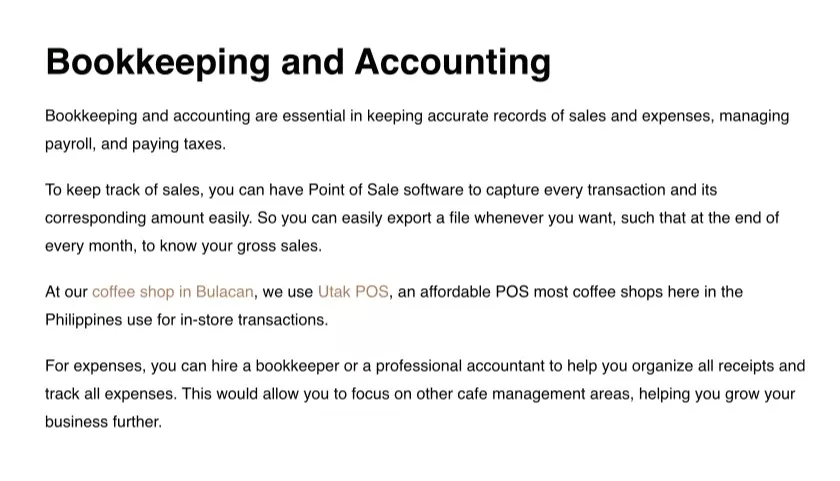
Doing it allows us to separate from all other ranking pages for the target keyword, as most have generic listings of specifications, product features, and product details. All of these can quickly be done with AI tools like ChatGPT.
Here are some more ways to input “experience” and “expertise” into your content:
- Input statistics and internal data are relevant and will highly support your topic. Make it easy for readers to understand the data by summarizing the most essential points.
- Include case studies and personal experiences as you write content—some observations, details, and actionable tips that might be helpful to your readers.
- Add offline resources that aren’t available online in your space. This gives you the unique advantage of covering important topics and points demonstrating your expertise.
Do Basic On-page SEO
You may be surprised I didn’t start with this best SEO practice. The main reason is that I don’t want you to focus much on keyword prominence.
You focus on writing the best coverage about the topic without bothering on-page SEO. After all, it is all about including the keyword in the most prominent places:
- Title tag
- Meta description
- URL slug
- H1 and H2s
- Body text
- First sentence
Add internal links and credible sources.
Internal linking is integral to SEO as it helps users navigate through your site quickly, boosting indexation and facilitating PageRank flow between pages.
Internal links can pass more link equity to destination pages, making them more capable of ranking for their target keywords.
At best, internal linking is a simple process. It links to other related web pages that are about the anchor text.
Here are some internal linking best practices:
- Include the right amount of internal links on your content, preferably one internal link for every 300 words.
- Use descriptive anchor texts to link to your destination page.
- Ensure internal links are dofollow.
- Check if you’re linking directly to a page with a 200 OK server response code. Avoid linking to 404 not found or 301/302 redirected URLs at all costs.
Aside from adding internal links, you should be linking to external resources you’ve found helpful for your readers, referencing them for a more detailed explanation of the subtopic.
Contrary to the belief that it dilutes link equity through your website when linking out to external pages, it is more advantageous to your content from an engagement perspective as you’re giving your search users as much value as possible.
Apply NLP to quick answers.
Theoretically, if you can apply natural language processing to your content, Google will be more likely to reward your content with snippets and better rankings.
Aim to optimize your content for NLP by echoing back the question, giving a direct answer, and mentioning the correct unit.
We’ve ranked our guide for featured snippets by applying NLP to every answerable question.
We review each “people also asked questions” and answer them directly in the content. We answer questions like “why is coffee shop a good business in the Philippines?” straight and with backed-up statistics.
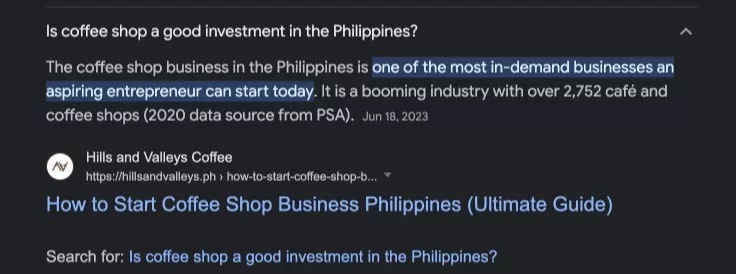
5. Fact-check and proofread everything.
After you’ve written your content, it’s time to edit and proofread everything.
Readability
Make your content easier to read and digest.
Avoid having large blocks of text. Have headings, bullet points, short paragraphs, and multimedia.
Simplify your content. Ask yourself, is your content written for an average person or someone with a technical background (i.e., a doctor)?
Most readers are average in any industry, so you need to write for them rather than for expertise unless your primary target is experts within your space.
Add images and videos to supplement your content, making it easier for readers to follow. For instance, “how-to” guides or tutorials need screenshots to show specific steps of the process.
6. Publish and promote content.
Publishing content is only 50% of SEO content writing.
Invest in getting visibility from search and social media channels to drive readers to your content.
Place in the main navigation menu
If you want to rank a newly-published product and collection page or new blog post, include it in your site’s main navigation menu. Published blog posts are best to have in a hub/learn section.
Pages in the main navigation menu are easier for Google to find and, therefore, see a boost in keyword rankings.
Add internal links from other pages.
Return to your site’s old content and include internal links to your newly published page. Do a Google search for site:[domain.com] “topic” and find any relevant blog posts you can edit to add internal links.
You can also use Ahrefs to find your best linked-to pages. These strong pages can pass robust link equity to your newly published page. Find a relevant page among them and include an internal link to your new content.
Promote via guest posts.
If you’re writing external content for other blogs (guest posts), you can build inbound links to your new content to increase its ranking power and, therefore, improve its position on Google’s search engine results pages (Google SERPs).
That’s it. Learn how to write content that ranks using the six-step process outlined above.
If you need help with writing content, see our content writing and content marketing services.
How To Find Niche Keywords For SEO
Keyword research is an integral part of SEO, as it dictates what type of content you’ll create and publish to rank in search engine results pages (SERPs).
Finding niche keywords is easy, but choosing the right ones to target for your website requires critical thinking.
In this post, we’ll cover how to find and choose the right niche keywords for SEO.
What are niche keywords?
Niche keywords are specific words that interest a small part of a market. Users search these terms to find solutions to problems or more information about the topic they’re looking for.
How to Find Niche Keywords for SEO?
The most popular approach to finding niche keywords is inputting seed terms into keyword explorer tools like Ahrefs.
1. Using Tools and Platforms
Let’s start with the basic ones. With these keyword research tools, you can instantly generate hundreds of niche keywords.
Ahrefs
By searching for head terms on Ahrefs’ Keyword Explorer, you’ll get a list of all matched words or phrases related to your inputted terms.
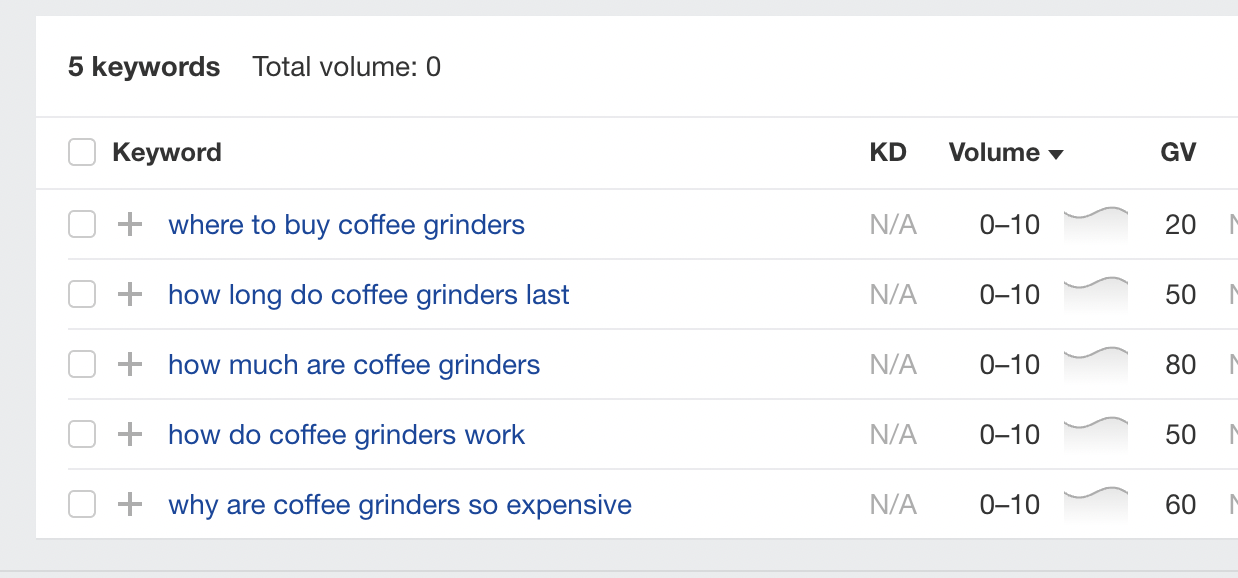
For instance, if you’re selling “coffee grinders’, you input the phrase “coffee grinder”, and you’ll see a bunch of niche keywords related to it. You can export and qualify a list based on specific criteria - which I’ll discuss later in this post.
SEMRush
SEMRush has more dynamic features and a massive dataset for keywords that can help you collect more relevant terms suited for your niche.
With its new topic cluster feature, you can easily create a topic cluster that can fit into the minds.
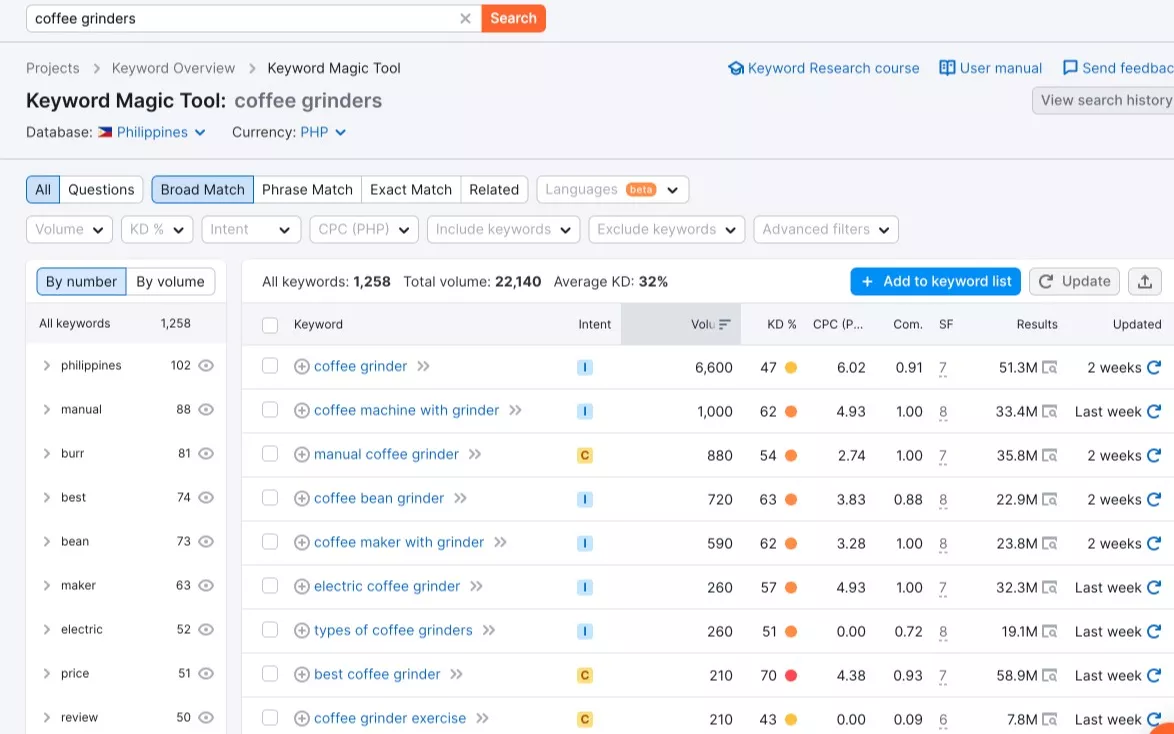
Further Resource:
Answer the Public
AnswerthePublic.com is a free browser-based topic generator tool that allows users to generate niche content ideas based on frequent search questions/queries by web searchers.
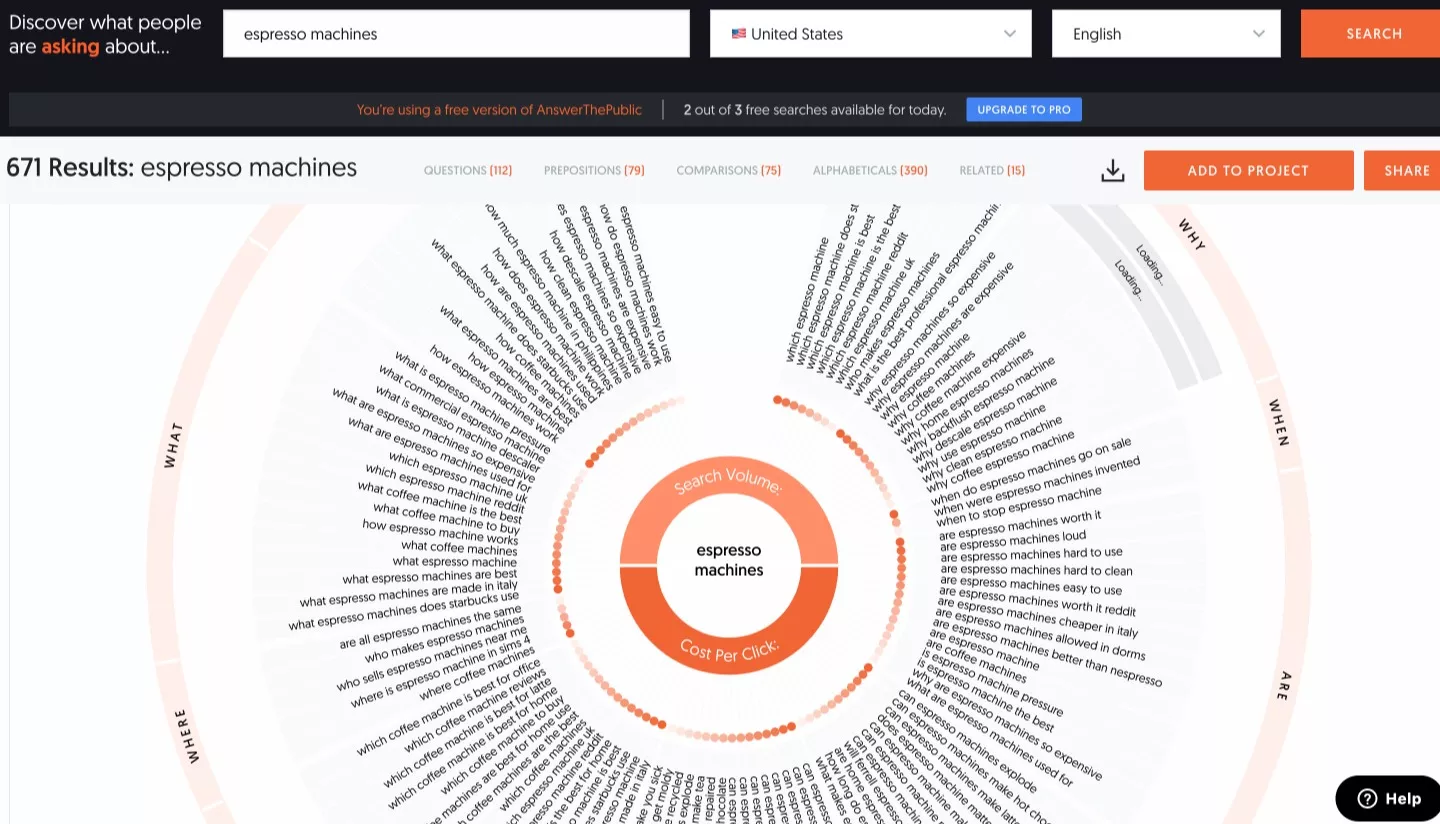
The tool displays data visualizations of interconnected topics or questions from primary keywords and topics you’ve inputted on their site.
Pro tip: Export the list of questions and paste them into Ahrefs’ Keyword Explorer to see which ones have substantial search volume you can target for your niche content.
Quora
Quora is the web’s most popular community-based Q&A platform today.
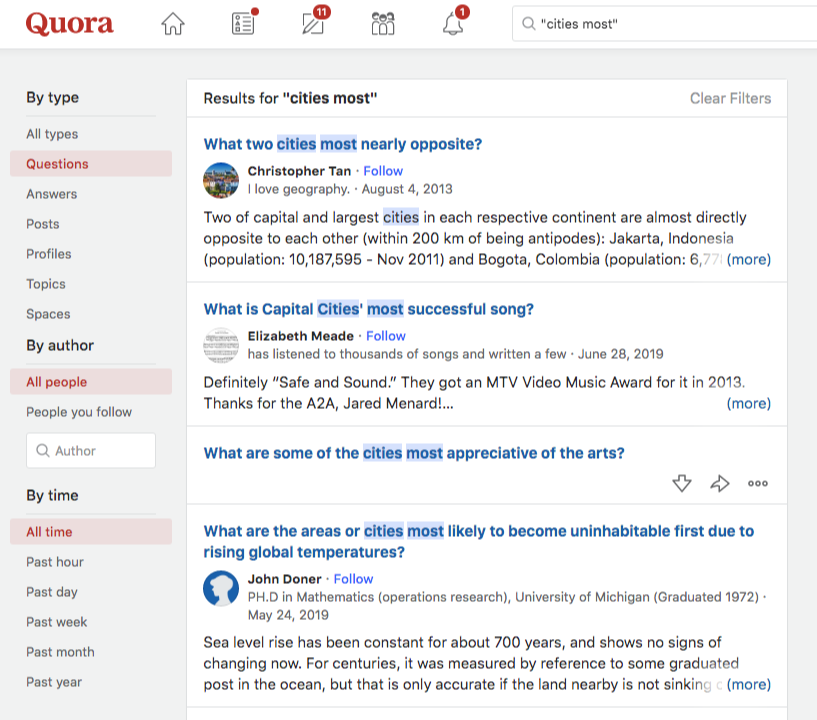
You can generate niche content ideas by skimming through all the questions related to your website/industry. Do a quick search on Quora. Check those with high activity engagement, as these questions are more likely to be searched.
Pro tip: Plug in Quora[com] to Ahrefs and input your topic to see what keywords Quora currently ranks for. It’s a pretty good sign that your content has the potential to rank for these keywords if Quora is part of the top 5/10 spots.
Google Autocomplete
Google has been so effective in suggesting search queries that are based on users’ historical search activity/habit. By doing a Google search for your target topic and not hitting the enter button yet, you’ll find Google Suggest or Autocomplete feature to give you some recommended searches.
I’ve been testing and targeting these Google auto-suggested keywords for one of my niche test sites. And though they have low search volume, most don’t have search volume data for now. These niche keywords are valuable enough to optimize your new content, given they’re near commercial intent.
2. Using Reverse Keyword Research
Inputting seed keywords into SEO tools like Ahrefs to scrape a list of all matching and topically-relate keywords and select the ones with high search volume is doing keyword research the conventional way.
However, checking the keywords’ search volume isn’t the only way to find niche keywords.
Doing it reversely without checking if a keyword has a significant search volume will be a better approach.
Reverse keyword research is the process of checking your site’s ability to rank based on the experience and expertise of the author before assessing if the topic has a significant search volume (or is pretty decent to rank with your website).
By first checking your authors’ expertise, you can gain much more advantage in assessing the content's E-E-A-T (Experience, Expertise, Authoritativeness, and Trustworthiness).
For instance, I’m starting to frequently publish new industry guides on this link building blog with new SEO experiments I’ve been learning from my niche sites that I find helpful to you (as my reader).
From there, I would ask keyword research tools like Ahrefs’ Keyword Explorer to give me matching or related keywords based on the inputted topic.
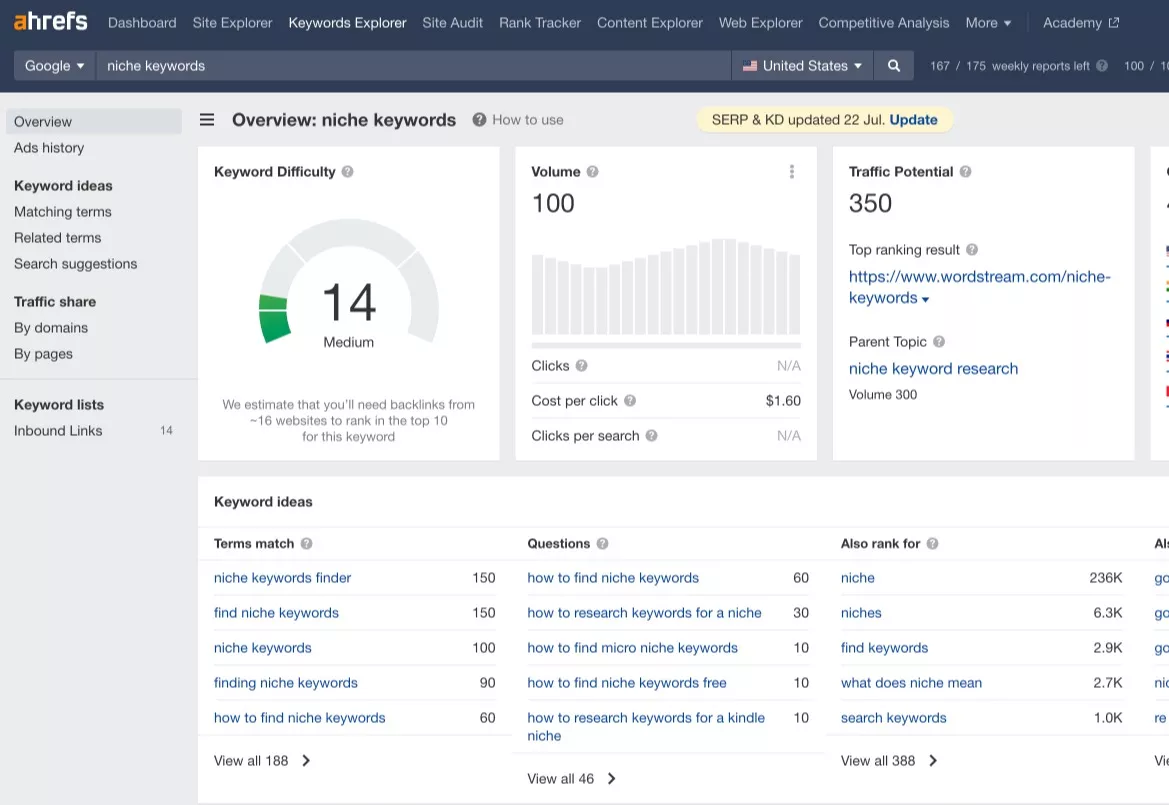
Instead of assessing if I have enough experience or expertise to write about the subject, given it has a good search volume I don’t want to miss with my new content, I’d have much better confidence in crafting the content in a way that’s rankable given its quality and comprehensiveness.
More reasons why reverse keyword research is robust in ranking niche keywords for SEO:
- Expertise and experience are brought to life in a content asset (E-E-A-T signals matter). You are more likely to cover many topics your competitors haven’t written - an excellent way to differentiate yourself from them uniquely.
- You establish topical authority when you’ve published content assets from topics you know are essential in your industry, even if these topics have zero to low search volume.
The best way to start reverse keyword research is to list all topics you know about your industry. Then rate them based on how well you know the topic (“1” being the lowest, “10” being the highest).
Rank these keywords from the topics you’re very knowledgeable about and publish content about them.
Then go to Ahrefs to see if they have an existing search volume. You can restructure words to find if there are existing data the tool has for the keyword.
3. Emerging Topics
Emerging topics are industry trending terms with increasing search demand.
And having content to write about gives you an initial advantage to being one of the first few indexed pages solely written about the topic.
It’s also an excellent way to build topical authority, given you demonstrate proficiency across all facets of your niche, including the ones that haven’t seen much light.
Increasing the topical authority of your website as the go-to source of information for niche topics increase the keyword visibility of your blog content for informational search queries.
There are many impressive tools to generate emerging topics in your space quickly. Exploding Topics by Brian Dean gives you regular email updates for any trending topics. This allows you to jump in on the topic and write about it, even before it hits its peak rate.
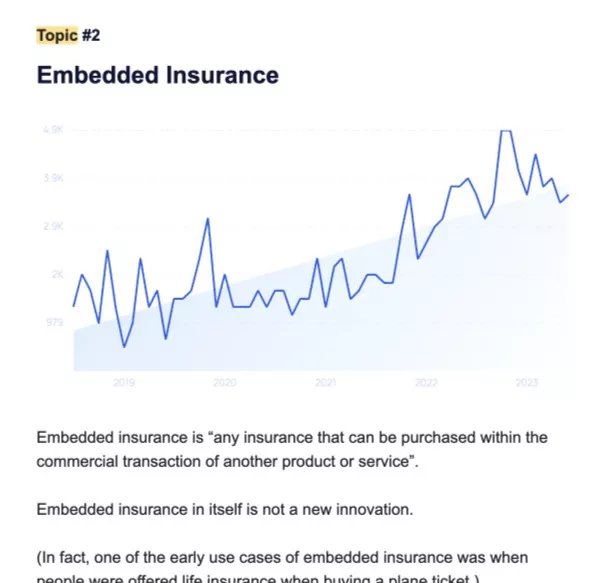
One of the latest videos of Authority Hacker is sharing a strategy on how they’ve tapped into the emerging topics on Tiktok to create content for one of their niche sites in the home DIY space.
As it turned out, Ahrefs have captured more search volume (for its data) and is now revealing a good search volume for the topic.
This is a great way to take advantage of new emerging topics with high potential to get search demand.
4. New Keyword Opportunities
One of the best places to start finding niche keywords is from existing ranking pages.
Your content ranks not only for its main keyword but for other industry-related terms that are potential keyword opportunities.
Google may see your page as relevant enough to rank for page 2, as it gets some impressions and few clicks, but with a thorough investigation, you’ll find it is best to create new content to target those topics.
How to find these new keyword opportunities?
Using Google Search Console
Go to Google Search Console.
Performance - Search Results - Queries/Pages.
Find pages with many impressions but getting fewer clicks. This means you may be sitting somewhere on page 1 or 2 (even lower) but aren’t relevant enough to rank highly on search engine results pages).
You can start with your best-ranking page. For this example, my how-to guide on starting a coffee shop has ranked well for dozens of keywords. So I start with this page.
Go to Queries - Rows per page (100 or 250).
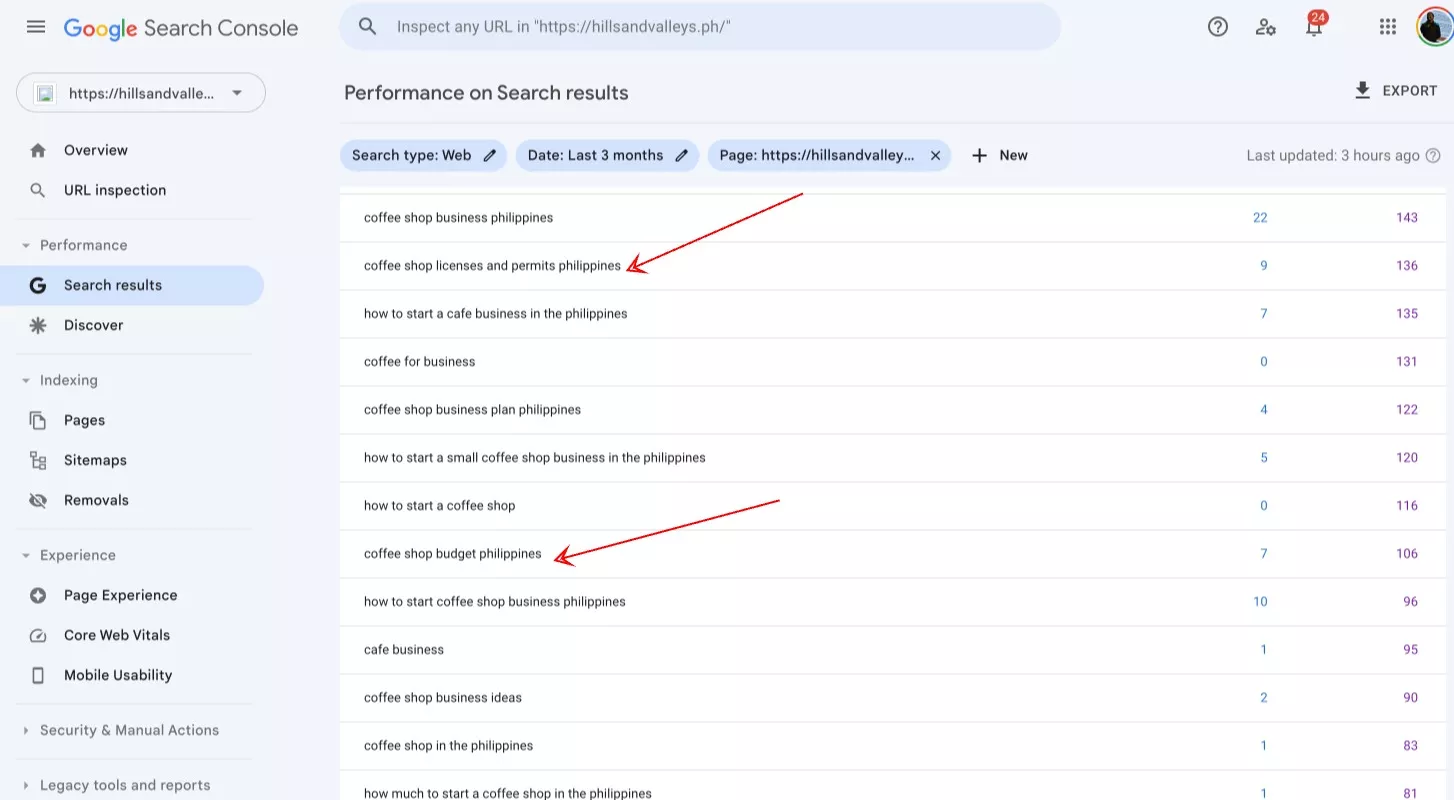
Here, I’ll spot niche topics that:
- I haven’t covered much in my content (I don’t have a section for it or a solid discussion about the topic).
- Broader and would require new content to provide more comprehensive information.
- Useful to add to my topic cluster.
Using Ahrefs’ Organic Keywords
Plug in one of your top pages on Site Explorer (if you don’t think of any, go to Top Pages, and there you’ll find your best-ranking pages).
Organic Search - Organic Keywords - Filter (11 to 100).
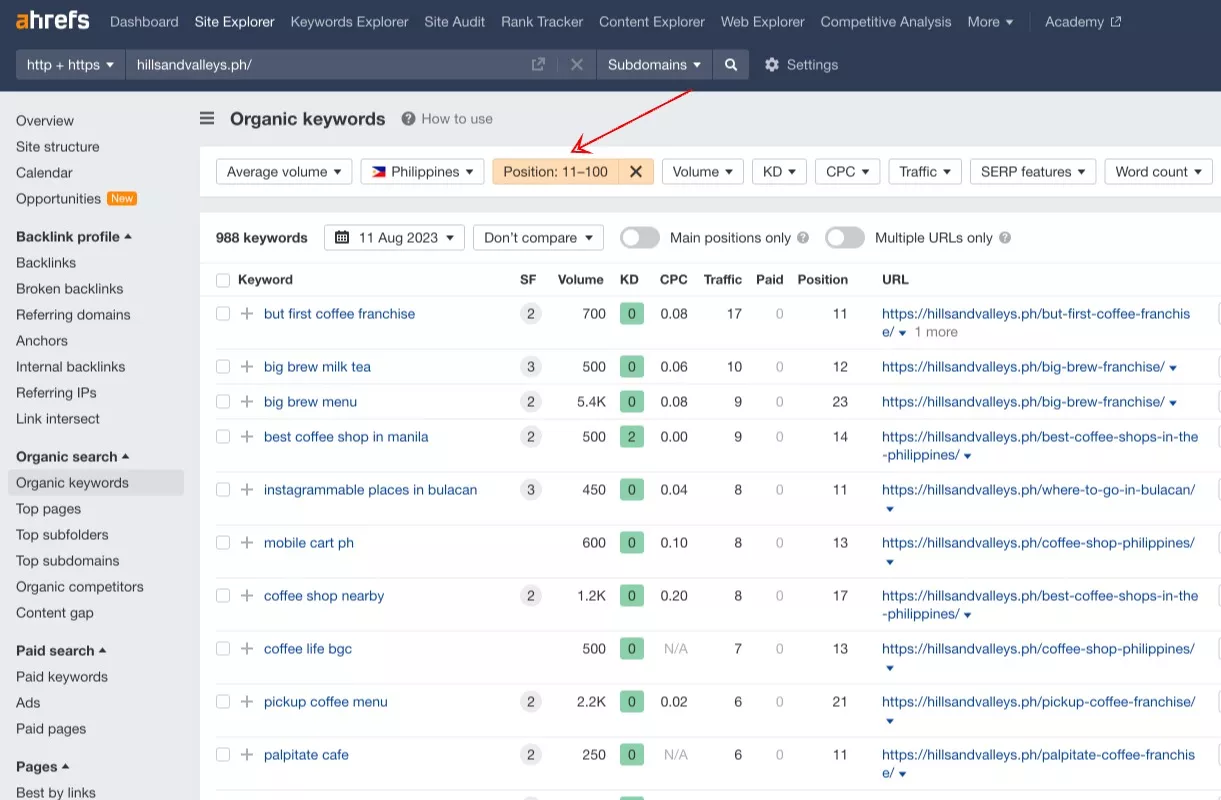
If you can’t move up the rankings from position 11 to page 1, there might be a search intent mismatch, so you must create new content about the topic (more on this below).
How to Choose A Keyword To Write About
After you’ve collected a list of niche keywords, there are things to consider to assess if a niche keyword is worth the time to create content (and optimize pages for).
This isn’t an exhaustive list, but my fundamental metrics/criteria when choosing a keyword to write about.
1. Search Volume
You need to know that people are searching for it.
- This means that it must fit at least one or two of these criteria:
- 100 or more monthly searches according to a keyword research tool (e.g., Ahrefs).
- Visible in Google autocomplete
- Appears in People Also Ask (you can use SearchResponse.io for free).
- Has a good number of impressions, according to Google Search Console (it only works if you have a similar article).
- Your personal experience or expertise tells you people are searching for it.
The last one is quite underrated. If you have enough expertise, you know emerging topics and specific subjects that people are currently or have been searching for.
One keyword does not equal one page. You can rank one article for 100s of keywords.
2. Competition
See if you can compete with the top-ranking pages for the keyword.
Here, people usually start with metrics like keyword difficulty (KD). At most, filter keywords with DR 30 or less, assuming you’ve got a new or lower authority domain to compete with.
Keyword difficulty doesn’t tell the entire story. You can choose a keyword with KD25, but ranking on the first page is challenging.
Instead, you manually type the keywords on Google and check the search engine results pages (SERPs).
- Here, I look for at least one or two of these in the top 5 or 10 spots:
- Websites with a DR lower than mine
- Forums or community-based sites (e.g., Quora
- Articles not updated in the past 3 years
- Low-quality AI scraped or spun sites
- Pages with thin content or very short articles (e.g., 500 words)
I recommend going after keywords if a ranking page with DR is lower than your site.
In theory, the lower the DR on top-ranking pages, the easier it is for you to compete with higher DR.
If every website on page one has a DR 80 or higher, that would be a red flag unless you’ve got DR 70 or higher to break through.
You can use Ahrefs to filter keywords with lower DR sites quickly.
Ahrefs Keyword Explorer - Filter - DR 30
3. Relevance
If a keyword is irrelevant to your site, don’t bother with it.
If you’re blogging about espresso machines and see a keyword about milk teas, don’t try to target it unless you want to expand on covering those topics.
Google ranks websites, not only pages.
The more comprehensive you blog about keywords within topic clusters, the more quickly you can gain topical authority, which makes it easy to rank for more niche keywords.
If you have set up a topical map, you can check it and see if a keyword you saw is included in it. I’ll discuss more about topical maps in my next blog posts.
But relevance is of top priority. Ignore it if it doesn’t have high relevance to your niche site.
4. Search Intent
You could have written 3,000 words on a topic yet couldn’t rank for the keyword because of an intent mismatch.
Search intent mismatches happen when the content you’re trying to rank doesn’t satisfy the search intent of the keyword.
There are four main types of search intent:
- Informational (e.g., “how long do espresso machines last?”)
- Navigational (e.g. “Breville login”)
- Transactional (e.g., “buy espresso machines Philippines”)
- Commercial (e.g., “best commercial espresso machines”)
Most niche site owners should be targeting informational and commercial investigations. These informational keywords are usually monetized with ads, although you can suggest affiliate keywords within the article (which serves as a solution to the problem).
Commercial investigational keywords work best with affiliates as you can insert individual product affiliates within the content.
For eCommerce SEO, you must target all four search intent types.
Categorize all your keywords based on their search intent. Then manually check on Google to see what types of pages are ranking for the keyword.
Next, to search intent, you’ve got to see the exact type of content Google favors on SERPs.
For instance, in one of my target keywords, “coffee business permits”, I could rank well on position #5 or #6 but probably won’t make it to top #1 given an intent mismatch.
Either I create new content that solely talks lists down business permits and licenses for coffee shops or have a new section on my coffee business guide.
This is where most of your time should be invested in. Investigate the entire SERPS, see what types of pages get ranked, what kind of information and format they use, and what specific entities you should include in your content.
5. User Satisfaction
Think about how long it will take you to answer a query.
If you’re targeting a “what is” keyword that can be quickly answered in one paragraph, don’t write an entire article about it. You can include it as part of a long-form guide about the parent topic.
One of the best keywords to target is when it is not answerable by short definitions but will require an entire article to explain the topic.
For instance, a keyword like “What is a good espresso machine for business?” would require an experienced and expert writer to showcase the best products with features to help aspiring coffee shop owners choose the best machines.
Bounce rate has nothing to do with the long a visitor stays on your website or how long they are engaged with your content before clicking back to the search results.
They could have been fully satisfied with your content - and it is the last click for the keyword. Your content has higher engagement signals than others, as it fully satisfies users’ search intent.
6. Audience Location
If you have an affiliate niche site, consider targeting a US audience, particularly if you monetize with ads. For affiliates, it can be best to target your own country to get products shipped for you for testing more quickly.
If you have an eCom website or a B2B site, you know your target audience, and best to include it when filtering your keywords on keyword research tools like Ahrefs.
Investigate Before Writing
The first half of the battle is won if you investigate a keyword before deciding whether to write about a keyword o not.
Being sure you can rank for a keyword with your content (quickly) helps you get some quick SEO wins early on for your website.
Niche Keywords for SEO FAQs
What is a good keyword niche score?
A good keyword niche score has many variables that come into play. There is no absolute niche score to see if a keyword is a good target for your content. Instead of relying on one niche score, check keyword difficulty, asses the top ranking pages, see if it’s part of your topic cluster, and look at the search volume - all these, you assess if a keyword is worth targeting.
How do I find searchable keywords?
To find searchable keywords, you can apply any of the following tips:
- Input seed keywords into Ahrefs or SEMRush and collect a list of matching and relevant keywords.
- See Google Autocomplete and related keywords below search engine results pages (SERPs). Tip: Don’t hit enter button.
- Find emerging keywords using Exploding Topics. See if there are any relevant topics in your space.
Why are niche keywords important?
Niche keywords are important because these are topics to target with your content. When creating new content for a blog, it is best to have a target keyword to optimize for. Include the niche keyword in the URL slug, meta title, meta description, and H1 and H2 tags, and sprinkle it across your content. I don’t care about keyword density.
How do I choose good keywords?
To choose suitable keywords, consider the following:
- Search volume
- Keyword difficulty (and manually checking lower authority domains for your target keyword)
- Relevance
- Audience location
- Search intent
- User satisfaction (types and formats of ranking pages)
It’s subjective in every industry and context, so consider choosing good keywords manually.
What keywords are trending?
The trending keywords are different for every industry and business. An excellent tool to help you out is Exploding Topics by Brian Dean. They have a free newsletter where you can see emerging topics every week.
How to Get My Business on Top of Google Search
One of the best ways to acquire new customers is to get your business on top of Google search.
By hitting the top search spot for specific commercial and informational keywords, you bring visitors who would potentially convert into customers of your brand. You also help your site be perceived as a trusted solution for products or services.
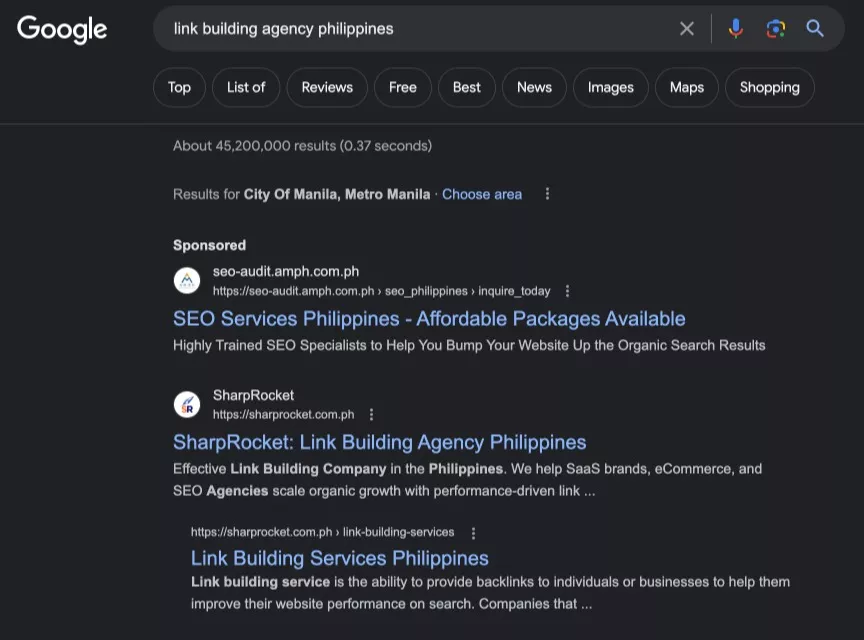
Here are some initial steps you can take to optimize your website for online rankings. Either you do it yourself or hire an SEO agency to do it for you.
How to Get My Business on Top of Google Search
Create Landing Pages For Target Keywords
The absence of a target keyword on a webpage is why some websites can’t rank for competitive search terms.
Having a target keyword on a specific page allows Google to understand the topic of your webpage and tells them how relevant it is to a target search query.
Let’s say you want to rank for “espresso machines in the Philippines”. You need to target the keyword “espresso machines Philippines” on your webpage.
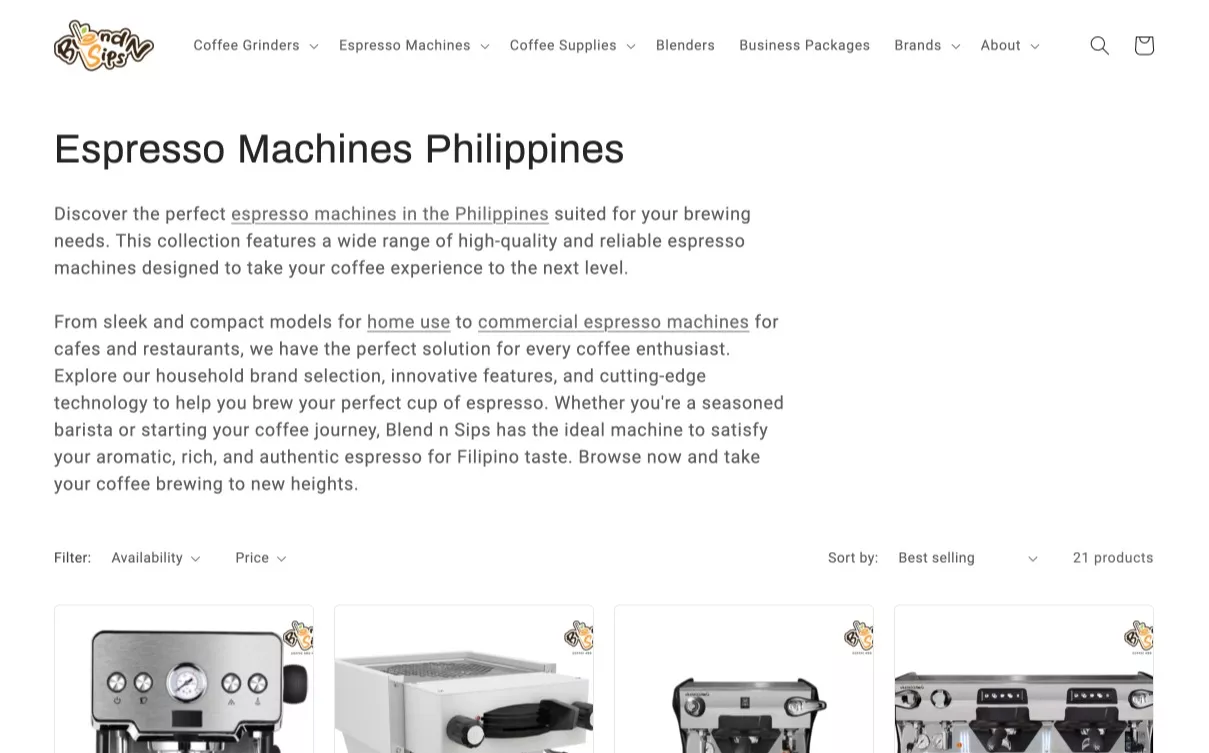
Choose one keyword for each dedicated landing page.
For instance, if you have 10 product categories, you select 10 keywords dedicated to each category. The same is true with service-type businesses. Pick one keyword suitable for your service page.
So list all services or products you want to appear on your website. And conduct a keyword research process to identify the keywords you want to target for each webpage.
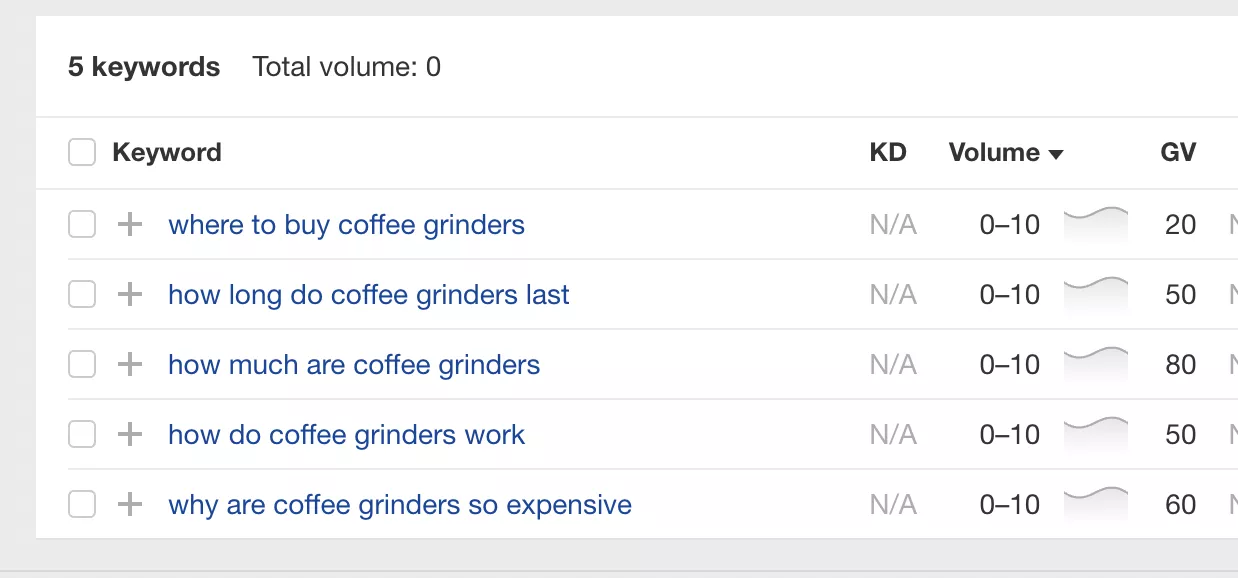
At most, you want to have dedicated pages for the homepage, product page, product category page, service page, opt-in page, about page, etc.
Make Rich Content For the Bottom of the Funnel Pages
The bottom of the funnel pages are your bread and butter pages, mainly product, product categories, or service pages. These assets bring constant money to your business (“money pages”).
With my eCommerce consulting experience, I’ve seen eCommerce sites wanting to rank for their commercial keywords yet having thin content on their product categories, even worse, duplicate product details from their manufacturers’ copy.
I recommend adding at least 500 words to your product categories.
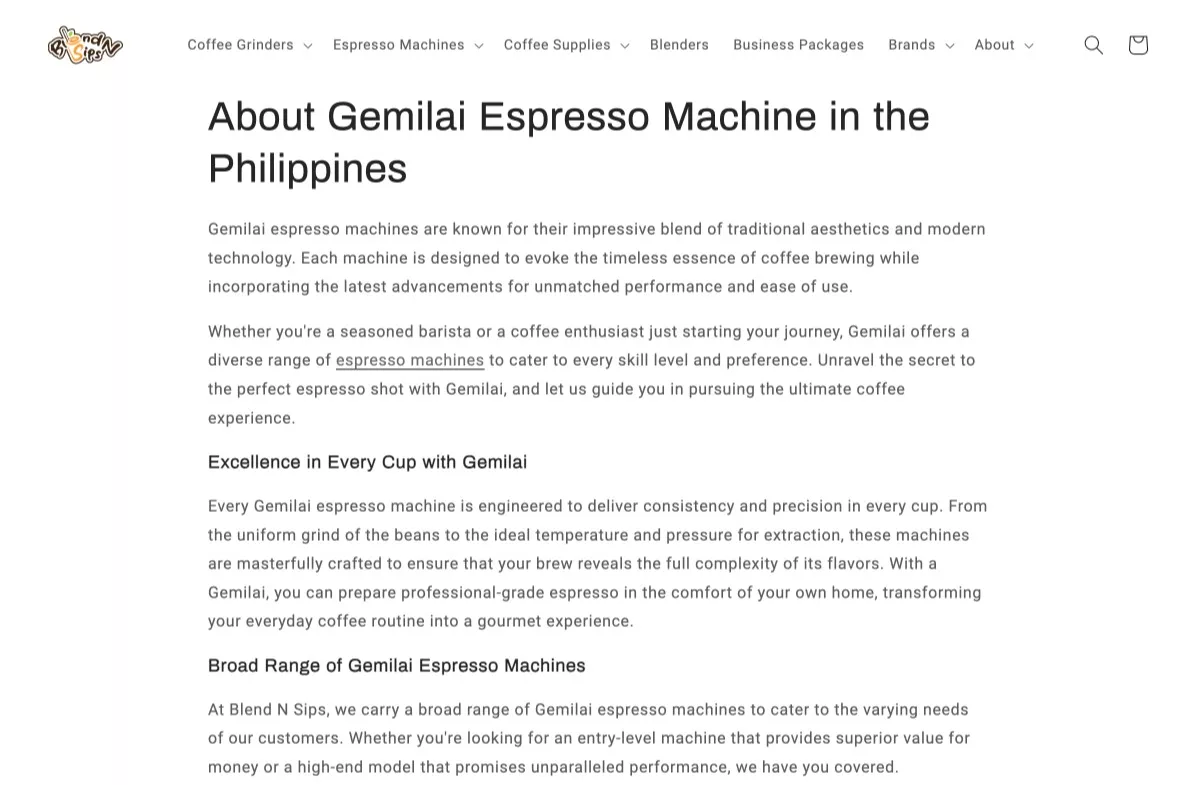
You can address your target customers' objections to purchasing products to increase engagement and conversions.
It could be sections about the following:
- Benefits of your product category (collection page).
- Unique value position (UVP) of your brand against its competitors
- A quick history of your product
- FAQs (Frequently Asked Questions) when purchasing a product type
All this rich content could provide context and more relevant signals to your site’s content theme.
You get an advantage over competitors with thin or duplicate product/product category pages by writing rich content for product pages.
Optimize Pages for Low Time to Value
Time to value is a concept coined by Ross Hudgens that refers to how fast a visitor gets value from specific content.
A longer time on a page doesn’t tell the entire story. Most low visitor time on page means that a searcher has satisfied with the information he has seen on the webpage.
This means that the search user doesn’t have to stay for 10 minutes if he can get the correct information from your webpage and be satisfied with it in seconds.

How to optimize pages for lower time to value:
- Place important information on top of your content. Make it easy for users to consume it without scrolling down until the bottom of the page.
- Add tools, visuals, and other interactive content types to increase user engagement and make your content easy to understand.
- Add TL;DR placed on top of blog posts to provide a quick summary of your post.
You aim to make your content the last click. Since you satisfy a user query, they’re less likely to return to Google search results for another result. Being the “last click” can be a good sign of satisfying content.
Publish Blog Content To Build Topical Authority
Not all blog content can best serve your website. You need the correct type of informational content that helps build the topical authority your site needs to rank quickly for its target keywords.
It starts with finding the informational content that can push visitors down to your business's sales funnel.
For instance, if you’re selling “coffee grinders”, think of the keywords your customers are searching for when they are interested in buying or are simply looking for information related to “coffee grinders.”
As an example, here are some informational topics you can target for “coffee grinders”:
- How long do coffee grinders last
- How much are coffee grinders
- How do coffee grinders work
- Why are coffee grinders work so expensive
One SEO misconception today is that lower search volume won’t help drive search traffic to your website.
It may be valid from individual pages targeting the search query. But in the grand scheme of your domain, you’re enhancing the topical authority of your website, giving signals to Google of the quality of content, expertise, and experience of your website.
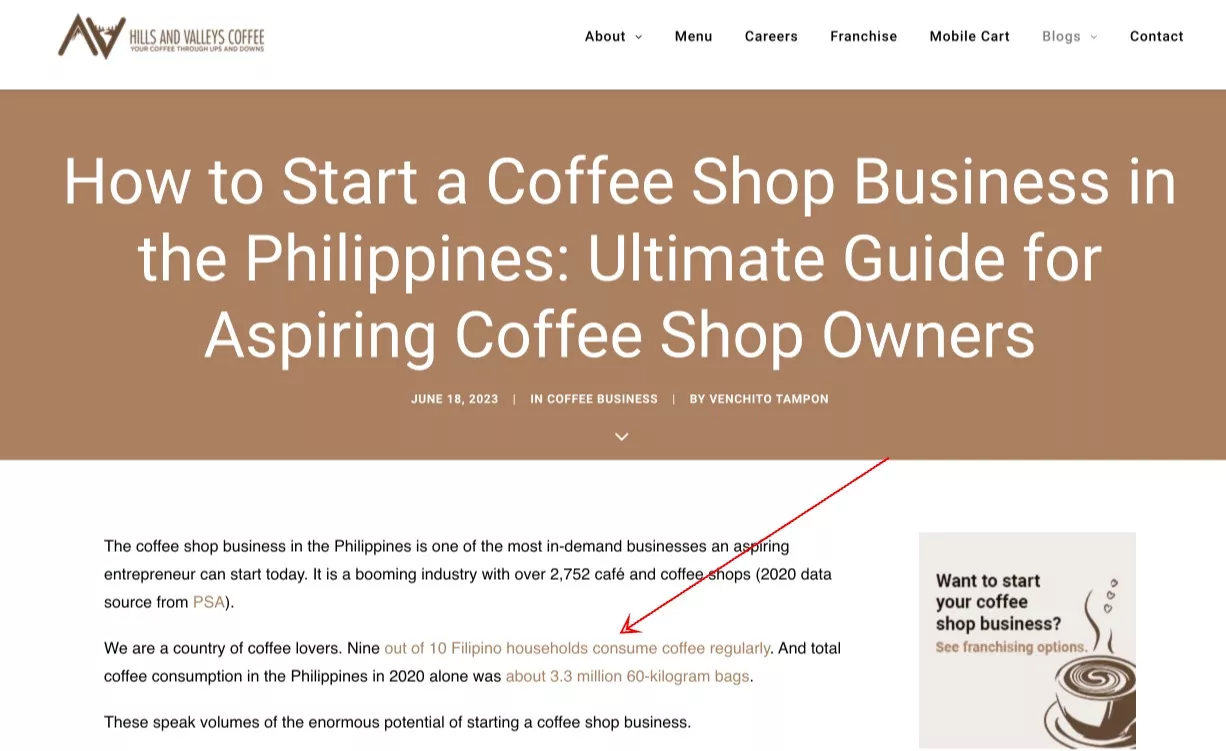 '
'
Doing so helps you quickly rank even better for other related keywords.
Target one topic cluster at a time, preferably the ones your business would want to be on top of Google search.
In my given example, I would first create a topic cluster for all keywords related to coffee grinders. Then, publish all relevant informational content on “coffee grinders.”
Then, once I’ve finished shelling out “coffee grinders” content, I can move to other topical clusters, such as “espresso machines.”
You want your business to be seen as a topical authority in a niche. And even with a low authority site, you could drive organic traffic and online revenue to your website by building a robust topical authority.
You can check out this guide on the importance of topical authority and semantic SEO.
Hire Human Expert Writers
In the age of AI-driven content, you could publish 50 to 100 articles monthly using tools like ChatGPT, Frase, and other AI tools to help you scale content marketing for your blog.
While that’s an advantage to lower operational costs and increase efficiency.
In industries where Google strictly assesses the quality of content, in the case of Your Money, Your Life content, you’re more likely to get higher returns if you hire human expert writers.
Human expert writers, especially the creative ones, can use their expertise and experience to craft more rankable content than AI content.
The recent experiment from Reboot Online clearly showed that AI-generated content ranked less strongly (on average) than human-generated content.
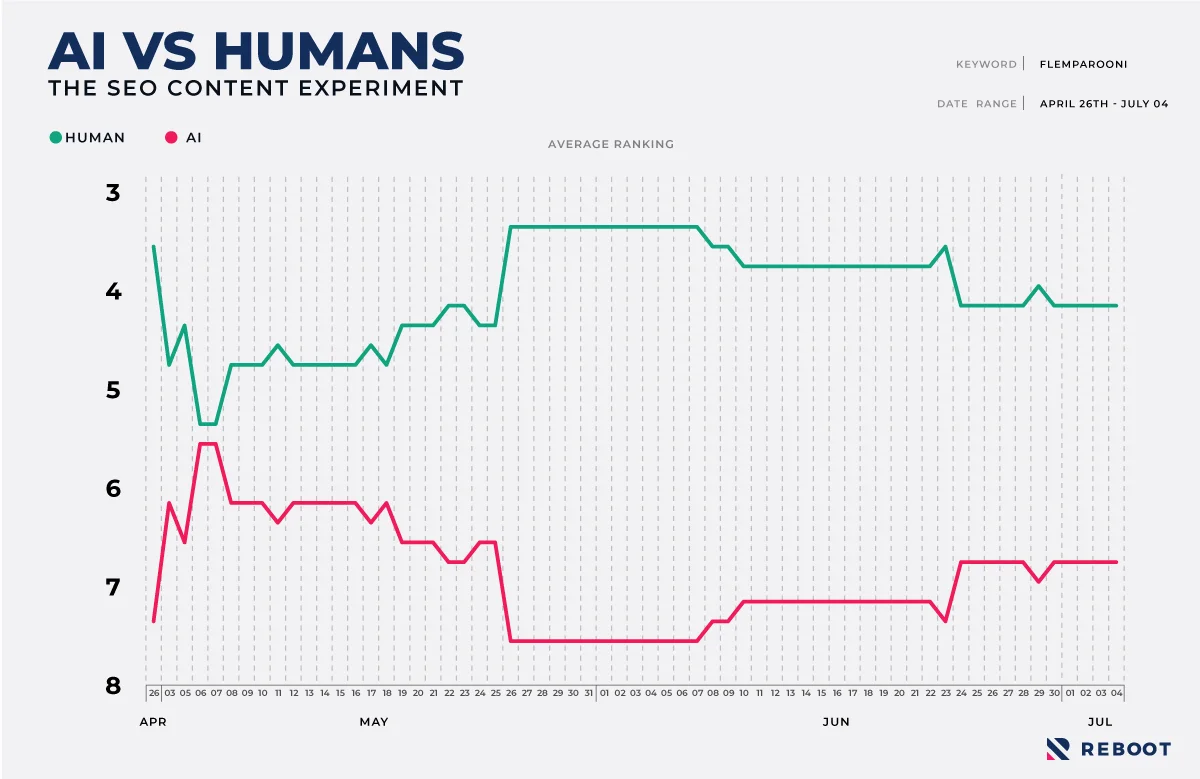
It may only apply to some industries, but with niches where high specialization is required, you should hire human expert writers for your blog search engine optimization needs.
Here are more tips when creating content with human expert writers:
- Bring your writer’s experience into the content. With E-E-A-T, you could get higher organic visibility by pushing out content with the author's unique experiences, making it different from all other high-ranking pages.
- Search for active authors in your space, and incentivize them to write for your blog. Either hire them, give premium access to a product, online store vouchers, or any incentivization methods to get them to contribute content for your blog.
- Through these authors’ reputations in the industry, you can leverage these entities’ associations with your site, making your brand more recognizable.
- Invest in hiring specialized experts that are also good writers. It would be much easier for content to fly its performance when the quality of information is solid and comprehensive enough than content written by general SEO writers.
Hiring human expert writers provides better opportunities for quality content and building your brand as a thought leader and subject matter expert in your niche.
Effective On-Page SEO
While the quality of content helps in driving user engagement, you can’t ignore the best on-page SEO practices to put into play. If you want to climb Google’s rankings, you need to ensure you’re putting your keyword in the following fields:
- Title tags
- Meta description
- Body text (i.e., opening sentence)
- H1, H2 text
- Image alt text
Here are some on-page guides to help you get started:
Manage Technical Health
Technical SEO is laying the groundwork to build the foundation for your SEO success. Without it, there will be limitations to skyrocketing your site’s organic traffic in Google’s search engine results pages (SERPs).
Taking care of it as you start your website or as part of your preliminary SEO process is a game-changer. This includes having the proper technical knowledge of crawlability and performance security.
Here are some guides to give you a more breadth discussion on technical SEO:
Build The Right Type of Backlinks
Backlinks are still king. If you’ve done an excellent job with your technical SEO, on-page SEO, and content, you need backlinks to climb Google’s SERPs.
Link building helps improve the crawlability of your site. It adds more semantic SEO signals to your website through external web assets (i.e., guest posts, profile pages, and brand mentions, which not only help you get the desired rankings but increases your brand awareness.
Contextual links are the correct type of links to pursue, as it allows you to choose specific anchor texts that will give weight to the value of the link you acquire from the website.
As a business owner, you can pursue many link opportunities using the link building strategies that fit your website, industry, size, and resources.
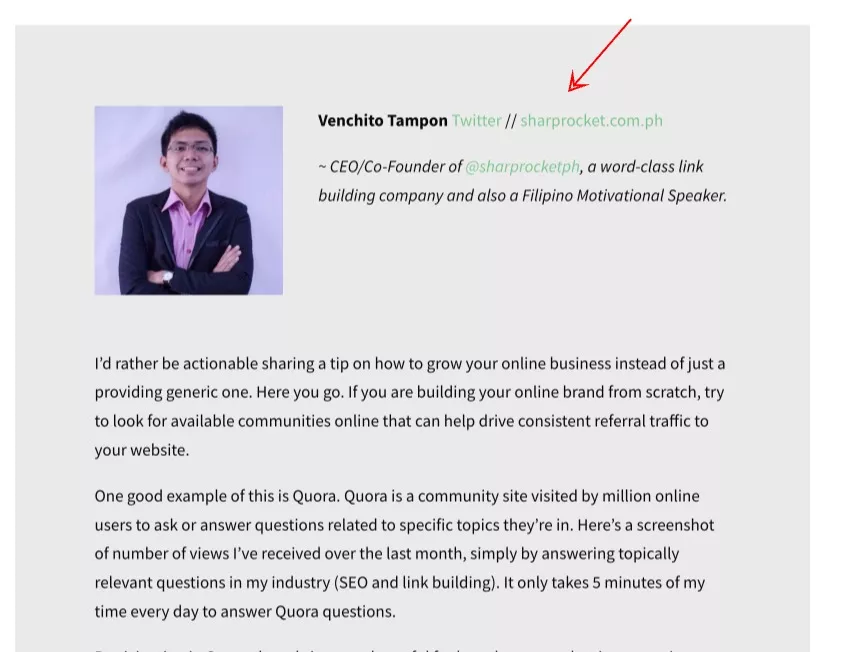
Here are some actionable guides from years of experience to give you a headstart in building the correct type of backlinks:
Aim For Freshness of Content
Publishing new content and updating the old ones to satisfy better search users is highly correlated with Google rankings.
That said, you can’t neglect the power of SEO blog writing to publish newly fresh content on your website. It helps in faster crawlability and can also assist you in getting passive links via ranking for informational keywords.
If your website constantly publishes new quality content for a particular topic cluster, you’re building your site’s topical authority on that niche content theme. And thus, it gives you more relevant signals to rank quickly for any keyword within the topic cluster.
On top of new content, you must also update your existing content. You’ve done work writing those content assets, and it only takes a few more hours to update and get ranking rewards from this initiative.
How to aim for content freshness:
- Create a content calendar to publish relevant content for your blog consistently. By having a systematized process, you can produce constant quality output from your pool of writers.
- Hire and train good writers. Through in-house training, you develop the quality and discipline of your writers, making it easier to foresee regular updates to your blog.
- For old existing content, check the freshness distance of each ranking page for your target keyword. See how many months or weeks ranking websites update their pages. If it is three months, six months, or a year, then you must account for it when you make your content fresh.
Don’t Ignore Long Tail Keywords
As a business owner or SEO client, thinking only for your primary head terms is usually one or two words (i.e., coffee machines). That’s your top traffic and potential revenue generator, as they typically have a high search volume.
However, don’t ignore targeting long-tail keywords with your pages. Especially if you’re starting to do SEO for your website, you won’t have much site authority to compete for competitive head terms where ranking websites have a DR50 and above.
That said, you can quickly get search traffic simply by ranking for long-tail keywords that most industry giants would ignore.
You can use Ahrefs to find these long tail keywords, or with Google Autocomplete and Suggestion Box at the bottom of Google’s SERPs, you’re likely to see different variations of industry terms and long tail keywords you can rank with content.

Use Authority Sites To Rank For Competitive Keywords
While you can’t easily rank for competitive head terms with a new domain, you can quickly use other authority sites to rank for competitive industry terms.
Take a look at this screenshot from Charles Floate. These pages rank for YMYL content, such as pharma, which would take hundreds of links to get to the same spot.
All these ranking pages are published and sponsored by brands to get the rewards of constant referral traffic back to their site.
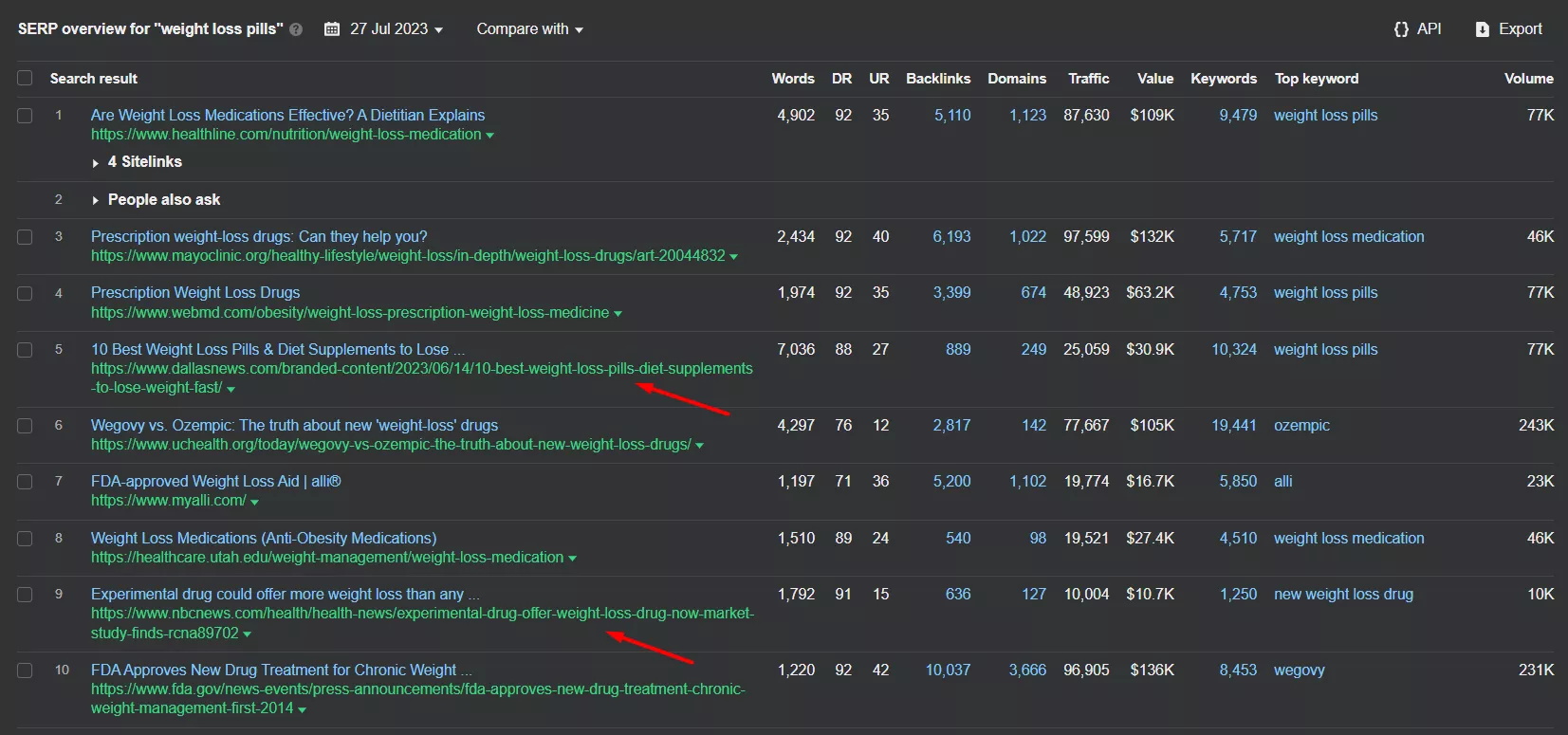
How to use authority sites for link building:
- Find industry sites trusted by Google where you can craft and publish content and quickly rank for your target keyword. Use the keyword as a URL slug in your “guest post” (i.e., best espresso machines).
- Link out to these authority sites before doing outreach. You’ll succeed more in getting content partnerships when you’ve featured them first on your website.
- Build more contextual links to your site’s other external content (guest post) from another guest post (tiered link building) to boost all external pages’ linking power, which can immensely help your domain’s online rankings.
Associate your brand with authoritative entities, as it could benefit you in many ways, especially in the age of E-E-A-T, where trust and authority sites linking to you can have a powerful impact on your site’s branding and rankings.
Dominate Local Map Packs
If your business is targeting customers within a city, region, or small country, local SEO is an integral part of your search engine optimization campaign.
You would see that a huge prime real estate for local SEO comprises local map packs with the highest clicks.
You can rank for organic search engine results pages, but with local map packs appearing on top of it, optimize your brand for local map packs and acquire more brand exposure.
Here are actionable tips to dominate local map packs:
- Create and optimize your Google Business. Ensure you have a complete profile, actual reviews of customers, and accurate business information. See this guide to optimize Google Business Profiles.
- Place NAP (Name, Address, Phone Number) across all your important pages on your website.
- Get local citations. Start from this list of best citations.
- Localize your website content by optimizing for local-centric keywords (coffee shop in New York).
- Get links from websites representing the same target local area.
- Place QR codes on your stores, incentivize customers to get reviews for your Google Business Profiles.
Acquire online real estate by being visible on organic search engine results pages (SERPs) and local map packs. Vying for both places increases organic visibility for your business.
Get Your Business On Top of Google Search
The best practices in ranking your website on top of Google searches differ from industry to industry, so better have a good context of your brand, content, and resources.
By following the actionable tips above this article, you can expect a gradual growth of progress for your site’s organic traffic and online revenue.
If you want to get your business on top of Google search, our SEO and link building services can help you.
SEO Quick Wins: Low Hanging Fruits You Can Implement Immediately
The ability to gain high-impact results from low-hanging fruits sets an excellent bar for SEO professionals when servicing clients (or their in-house brands).
With SEO quick wins, you can prove search engine optimization for your client - social proof that it is a marketing channel worth investing in.
What is SEO quick wins?
SEO quick wins are immediate results that impact rankings and online revenue by implementing quick SEO changes to the website, either on its technical health, content, or links. By focusing on 20% (high-impact SEO tasks), you can gain 80% (superb results).
Here are some high-impact SEO techniques you can implement immediately on your site.
SEO Quick Wins: Low Hanging Fruits You Can Implement Immediately
1. Add internal links to improve lower page 1 ranking pages
Internal linking is an underrated SEO tactic for most SEO professionals. Since most of the SEO world focuses on link building (getting external links from other sites), internal linking is less likely to be appreciated.
By linking internally between your pages, you pass link power from one page to another, which gives the destination page a much more capability to rank higher for its target keyword.
This is especially true if you have a big website with strong domain authority. All you need to do is to execute an internal linking strategy and see a quick ranking performance for your most important pages.
How to do it?
Step 1: Find pages sitting on lower page 1 or 2 rankings.
You can find low-hanging fruits from pages already ranking on lower page 1 or page 2.
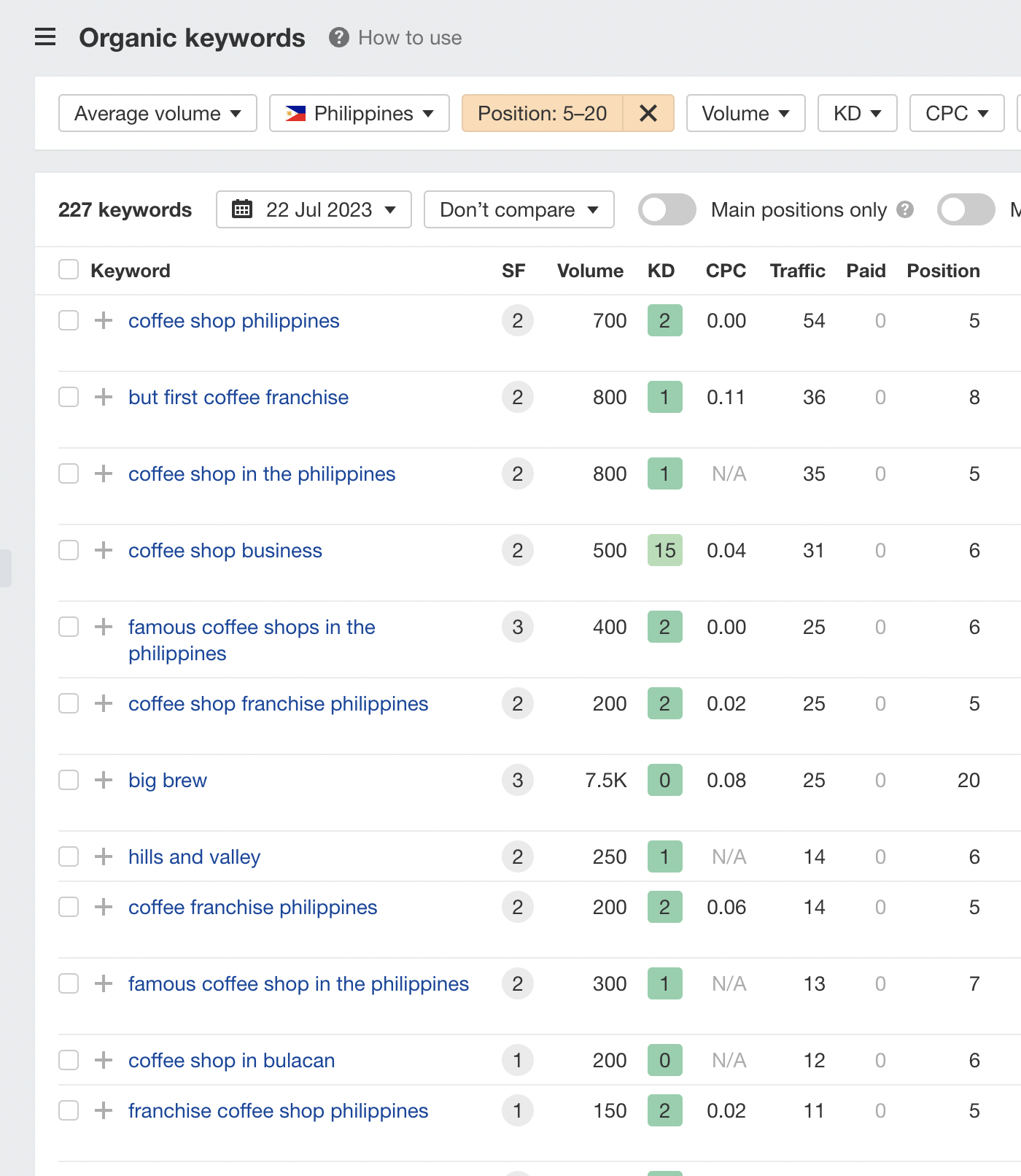
You want to boost the pages’ rankings and get the most clicks by ranking on the first three spots of search engine results pages (SERPs).
Step 2: Include internal links on your top linking pages.
Find blog content with the highest number of inbound links. You can use Ahrefs’ Best by Links to use these informational pages.
Edit those content and include internal links to your money pages.
Do more internal linking. Find other relevant content using the site search operator on Google and see which blog content you can quickly edit to add internal links.
2. Capture traffic from long tail keywords.
Long tail keywords are three or more words but have lower keyword difficulty than fat head terms.
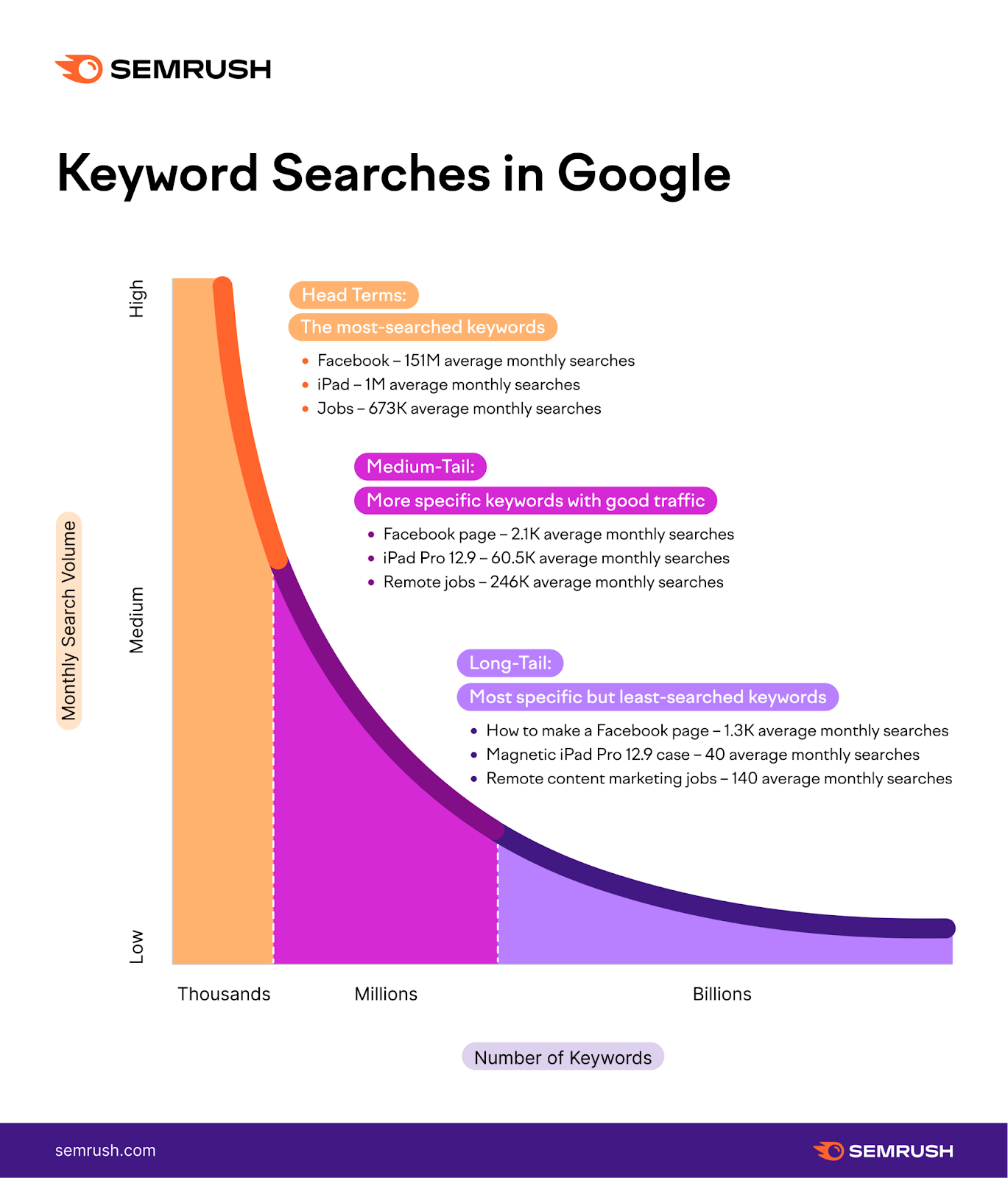
One mistake most starting SEOs make is targeting highly competitive keywords with their SEO campaigns, particularly with newly built websites.
Essentially, Google would want to reward sites with thousands of quality pages that have established trust and topical authority deserving to rank for their fat head industry terms.
It is best to find long-tail keywords that don’t have much competition but are driving specific visitors to your website.
For instance, if you’re running an eCommerce store, don’t neglect long-tail commercial keywords that can bring highly targeted ready-to-buy customers (e.g., dual boiler espresso machines). They may only have ten or fewer monthly search demands, but you could easily rank #1 for this keyword.
Compared to optimizing your website for only one head term, that would take you years of trying to dominate at least the first page on search engine results pages (SERPs).
I’ve been doing SEO for a coffee and tea supplies eCommerce brand and have successfully generated targeted website traffic weeks after its launch.
I created landing pages for different long tail keywords about our selling products' sizes, types, and layers (i.e., espresso machines).
So we’ve had different collection pages for these keywords:
- Dual boiler espresso machines
- Single group espresso machines
- 2 group espresso machines
- Commercial espresso machines
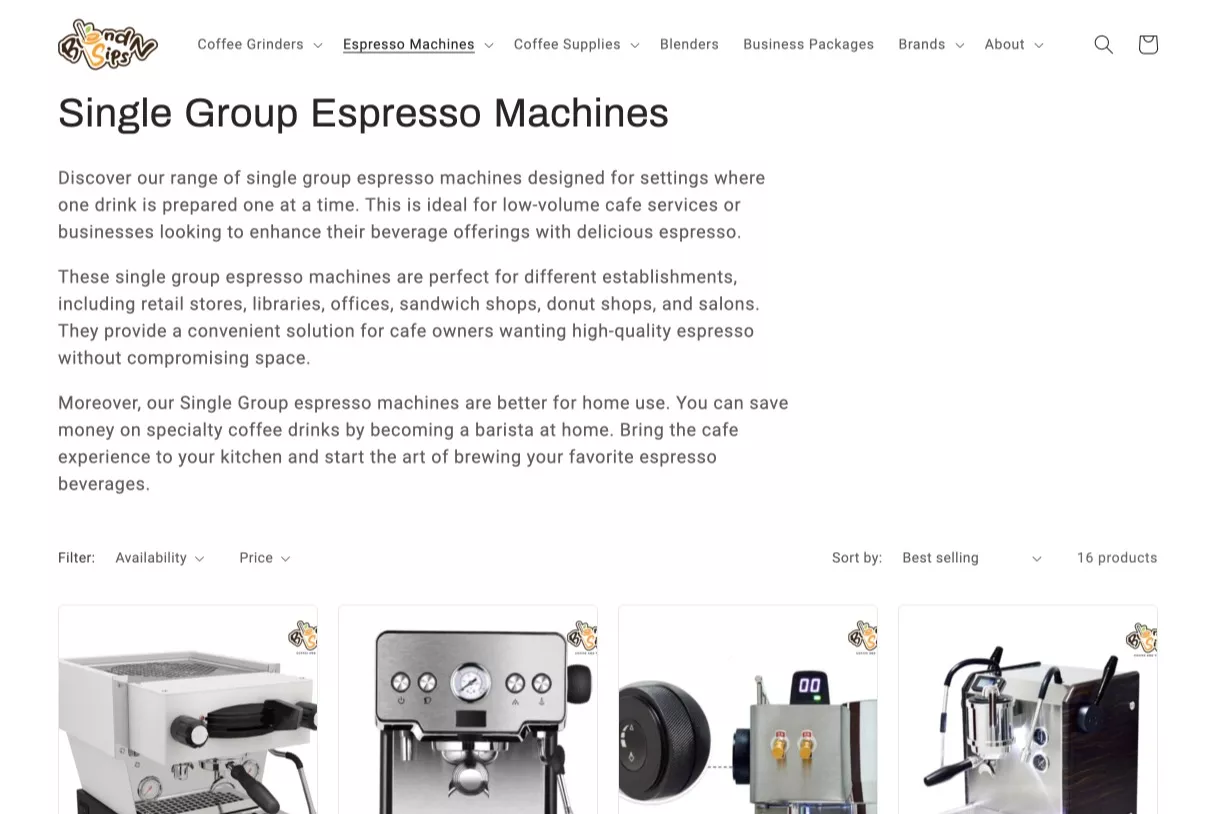
The best thing when you target long tail keywords is that it is so easy to rank with fewer or zero links, regardless if your website doesn’t have much domain authority.
3. Publish blog content to build topical authority
How content marketing is perceived as part of the entire marketing strategy hasn’t changed at its core.
Content marketing assists in driving relevant, targeted traffic to the website. You make your brand more visible to potential customers by ranking blog content for their informational keywords.
Google won’t understand your site unless you give it the proper context and content theme. Publishing more blog content on a specific topic cluster gives search engines semantic signals about your site.
More blog content could help you establish yourself as a topical authority, thus, allowing you to rank for more competitive keywords.
One of the SEO quick wins to build topical authority is answering questions about the product/s you’re selling.
For instance, if you’re selling “espresso machines”, you publish blog content about:
- can espresso machines make regular coffee?
- how long do espresso machines last
- where to buy espresso machines
By publishing these content assets with internal links to your category page (i.e.,/collections/espresso-machines/), you drive more awareness from your customers about your products while establishing the topical authority of your brand.
First, find keywords related to the specific product category you’re trying to rank for.
You can use Ahrefs’ Keyword Explorer to find questions related to your commercial keyword:
Answer The Public is a great way to source out queries related to your category page.
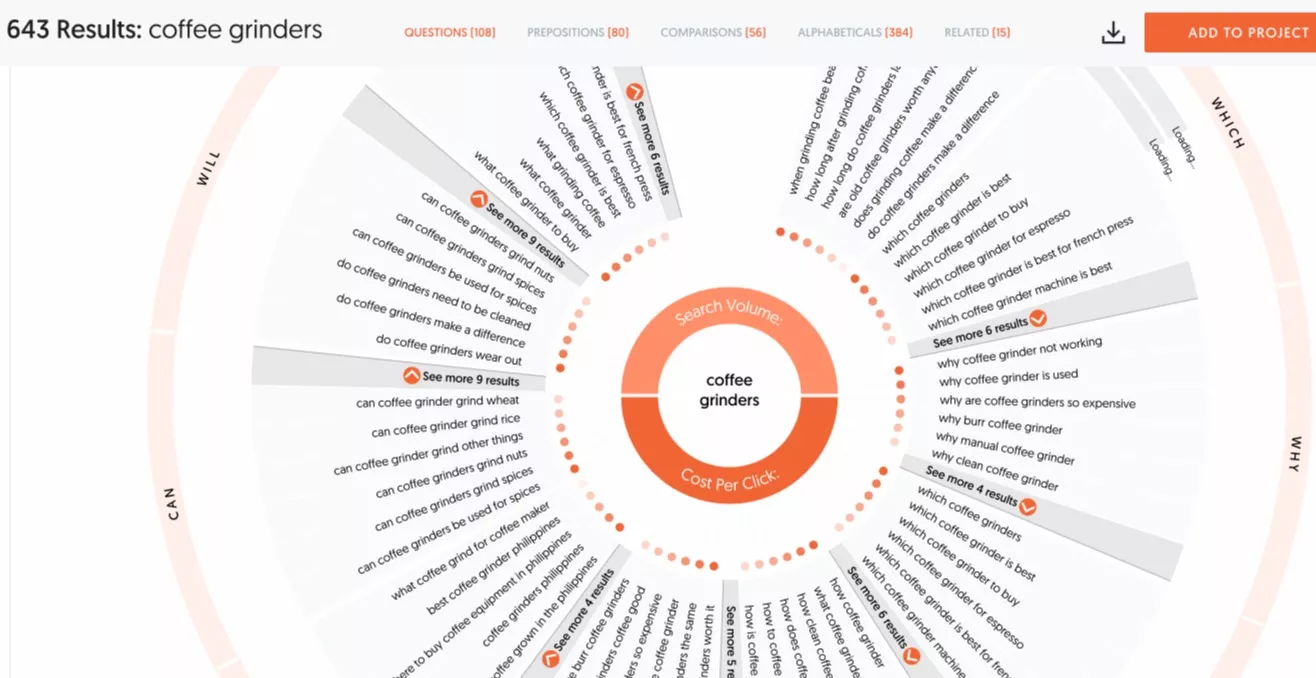
You won’t find most of these questions to have a high search volume, but they all give context to your site. Like what Koray Tuğberk said in his interview at Matt Diggity’s Youtube channel, you connect semantic points within your subject theme by writing topics even without much search volume.
4. Steal competitors’ search traffic.
If you’re doing SEO for new websites, it’s not easy to rank for your target keywords and garner traffic (Google Sandbox), as you’ll have to wait for a few months for Google to trust your site and make it deserving to rank for your target keywords.
One way to get relevant traffic is to steal visitors who’re going after your competitors’ brand names.
For instance, I’ve recently published several alternative pages for our coffee shop franchise.
Instead of solely ranking for coffee franchises, we researched specific coffee brands aspiring business owners want to franchise with.
We’ve got the list ready with Ahrefs and quickly publish “alternative pages” targeting each branded keyword.
We included enough information about our competitors’ franchises and even added FAQs to answer common questions related to the search query. Through this, we could rank better for the keyword.
The good thing with alternative pages is we can drive awareness and potential conversions by writing a section about our offer, with the angle of giving another (alternative) option for potential franchisees.
We quickly rank for competitors’ keywords (page 1) after days of publishing it.
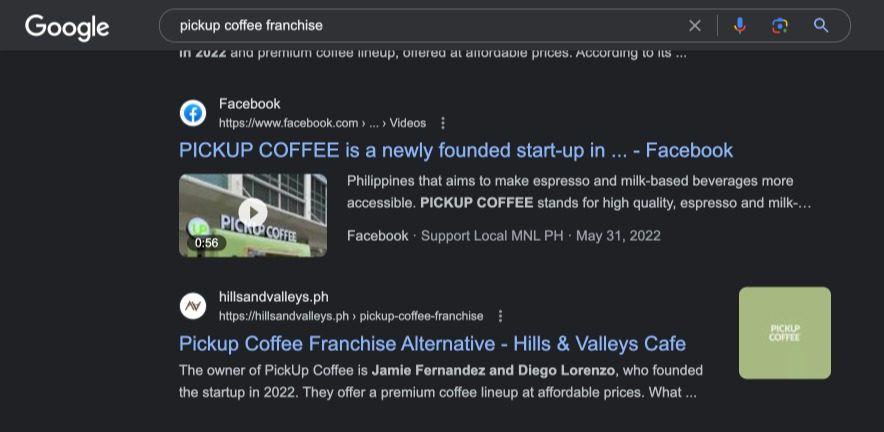
Interestingly, we have competitors that don’t have websites yet, and we’re not capturing most of the traffic they should be the ones getting in the first place.
5. Reoptimize content for newly discovered keywords.
SEO is continuously optimizing content to rank #1 (if you’re not hitting the spot) or simply sustaining your rankings by maintaining it.
One of the high-impact SEO tests you can do is discover new keywords you can target with your existing content.
How to reoptimize content for new keywords?
I use Google Search Console to identify queries for which my pages rank manually, but I need optimization.
Search Console > Search Analytics > Click on Pages’ Filter > Click a Page > Choose on Queries’ filter.
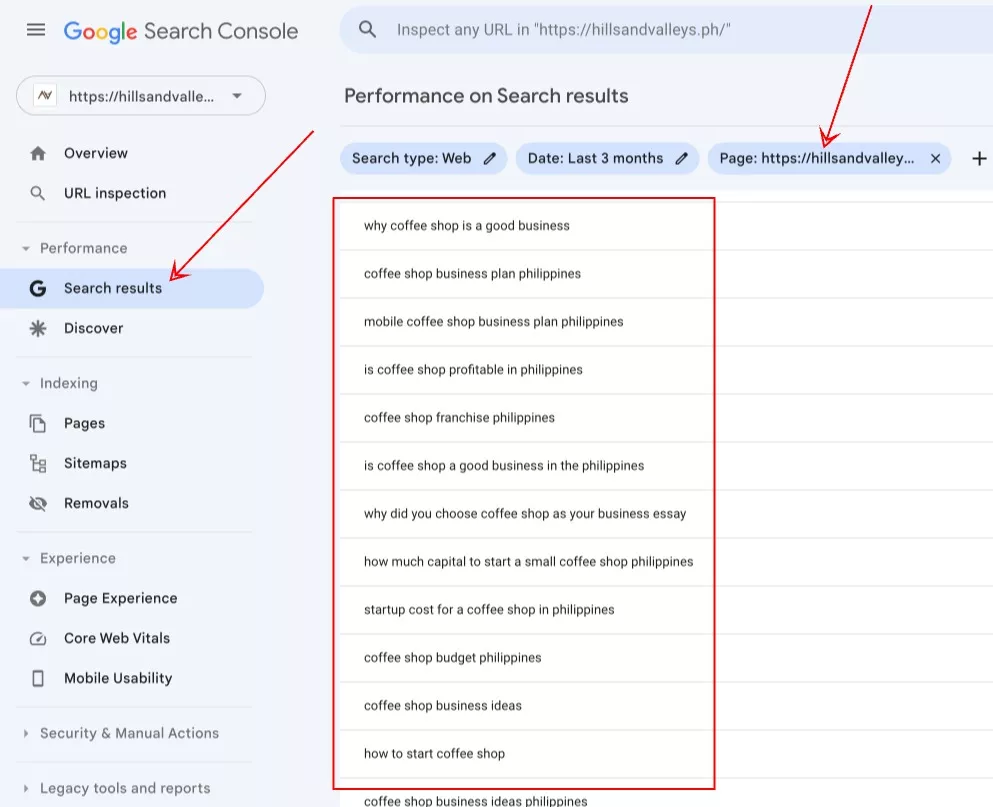
Once I’ve determined which queries deserve optimizations, I can choose from any of the following content optimization methods:
- Provide logical and accurate answers to these queries.
- Give the best definition to “what is” queries to steal paragraph snippets.
- Add LSI keywords to your title tags from newly discovered queries. For instance, words like “template”, or “guide” could help your page get more visibility for those search queries.
6. Reverse SEO outreach
Link building is a tedious task, mainly requiring manual outreach initiatives. It is a numbers game that even the most experienced SEOs need help to secure links for their clients.
While the era of sending outreach emails is still at its peak, many content publishing sites divert their attention into publishing linkable assets that are likely to attract natural links via ranking for informational keywords.
I’ve covered this in my SEO outreach guide, where the proposition isn’t just sending outreach emails to land contextual links but publishing solid content assets that can earn passive links.
Here are a few steps to do reverse SEO outreach:
Step 1: Find topics or informational queries other content publishers are searching for.
Other SEO content creators call it “referential keywords”, where bloggers, journalists, and content publishers use these queries when looking for references or additional resources for their content (i.e., news stories).
You can use Ahrefs’ Keyword Explorer to find referential topics in your space. Use terms like “template”, “statistics”, or “data” plus your topic of choice.
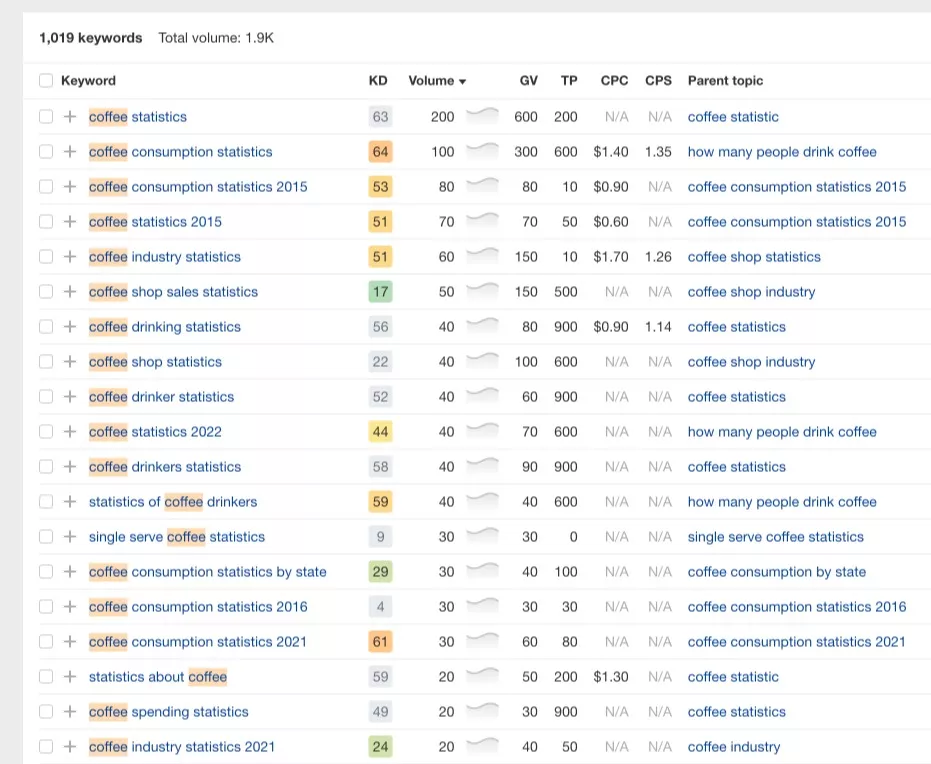
Step 2: Create a linkable asset and improve its rankings through internal linking.
If you’ve got a high-authority site, you can leverage internal links to push your linkable asset to the top spot.
Find top-linked pages on your site and include internal links to your linkable asset.
Acquiring editorial links pointing to your referential page from other external content, such as guest posts, is best.
7. Publish new pages for keywords you can’t rank 50 to 100 position.
If your blog content performs well on search engine results pages (SERPs), it ranks for multiple topically-relevant keywords.
An average SEO would assume the page tends to rank #1 or even just page 1 for all these keywords.
Reality: You won’t rank for some keywords because each search query entails a different satisfaction for its user.
There are specific keywords with ranking “list pages”, while other search queries tend to lean on specific product pages.
While you can do complete on page optimization, proper internal linking, and acquire as many inbound links for the page, it won’t rank simply because the search query is satisfied with a different intent, and it needs a whole new page that only discusses the topic.
How to maximize these new keyword opportunities?
Your initial step could be to look for all the keywords your best pages currently rank for positions #50 to #100. This means Google sees the page as relevant to the search query but won’t intend to rank it for the reasons I mentioned earlier.
You can use Ahrefs’ Site Explorer to find keywords your page is ranking from position #50 to #100.
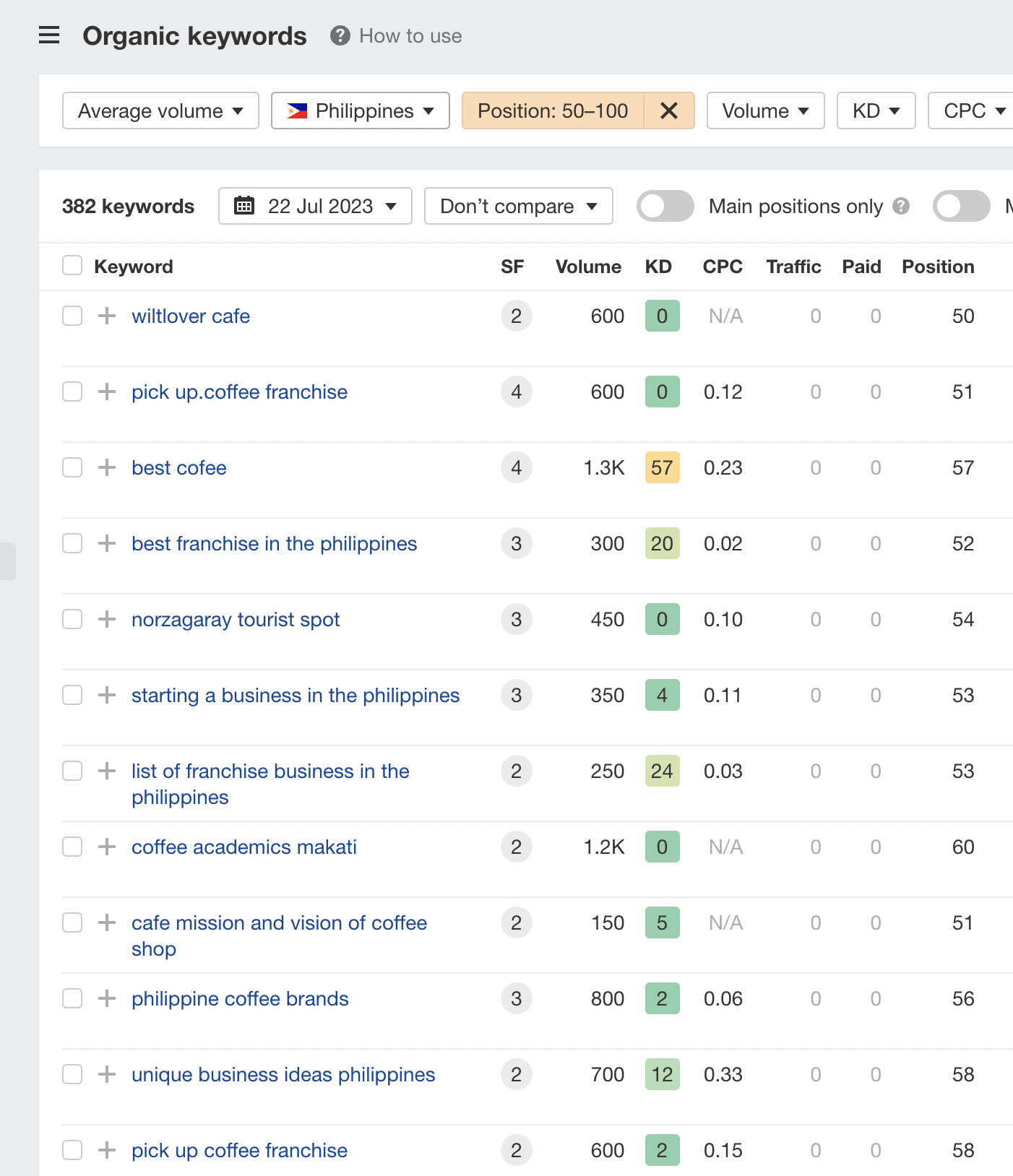
You can also use Google Search Console for this process.
Performance - Search Results - Pages - Queries - Rows per page (100)
Assess if you need to include an additional section or text to your existing page to make it deserving to also rank for this newly found keyword or if you would need an entirely new page for the topic alone.
For instance, I use this process to find keywords in my coffee shop business guide where it gets visibility (impressions) but aren’t getting many clicks from searchers.
I went to Google search, assessed the top rankings pages, and saw what pages are currently ranking for. This gave me an idea of the type of page I should create new or a specific section I could add to my existing page.
For example, “How much capital to start a coffee business” may need an entirely new article to publish, which I could use as a supporting page to my parent topic, “coffee shop business”. Build more topical authority by internally linking the supporting page to the parent page.
8. Add rich content to category pages.
Most eCommerce category pages serve only as product listing pages that don’t have much content that search engines would use as semantic signals to determine the context of those pages.
One best way to rank your category (collection pages for Shopify) is to add at least 500 words of rich content.
A short description before the product listing describes what the collection page is about. And below the product listings, sections you can use to add content that can help increase conversions.
One example is answering objections and questions your target customers constantly have about the products.
You can also include FAQs (Frequently Asked Questions) and answer them with direct answers. This would also help your category page to steal some of the featured snippets available for long-tail commercial keywords.
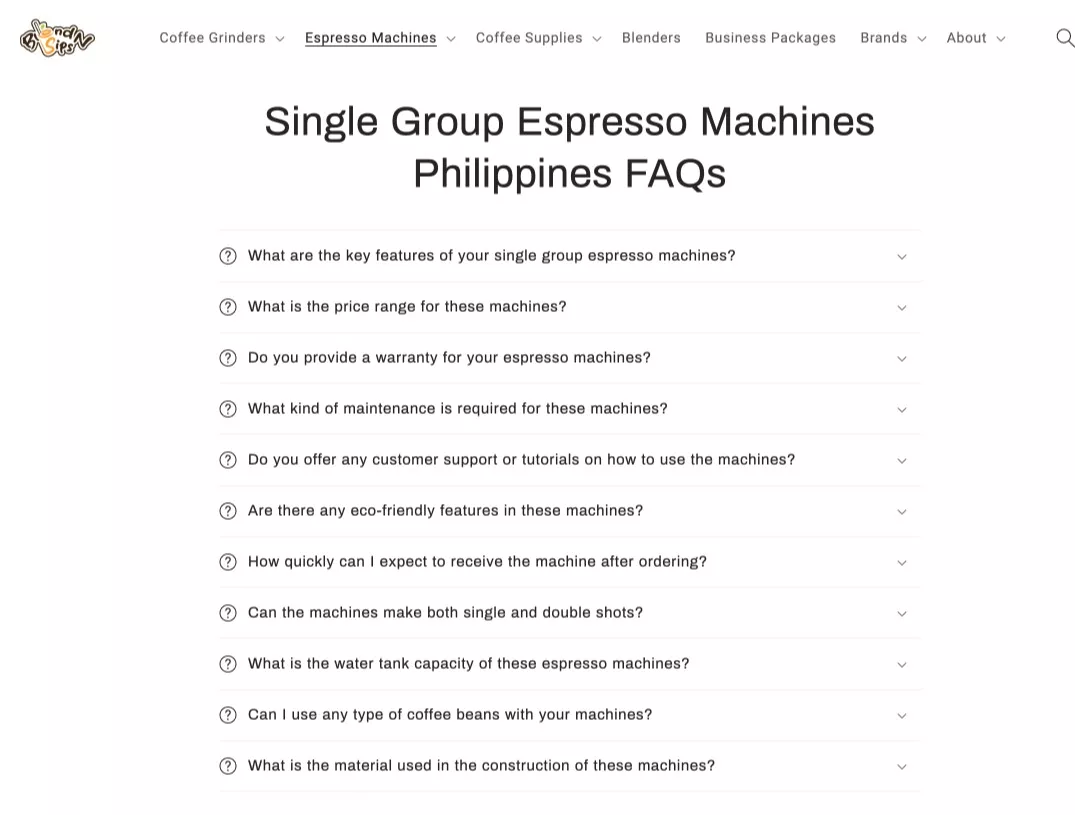
By making your page rich in content, you build the site’s topical authority and help Google better understand your content theme, thus giving you the advantage of ranking quickly for more competitive commercial keywords.
9. Scale link acquisition through active industry authors.
Relationship building is an integral part of any link building campaign. By strengthening connections with like-minded individuals, thought-leaders, and industry personalities, you can gain a cumulative advantage in acquiring brand mentions and links from higher authority sites.
Engaging with active industry authors is one of the best ways to scale up link acquisition. These are content contributors to multiple websites with established author portfolios, recognizable to the publications and audiences they served with their content.
You can find these active guest bloggers and ask if they want to collaborate with you for a mutual partnership agreement.
Offer a substantial opportunity so that both parties can get links for their websites. You include contextual links on your future guest posts and other websites, pointing to the guest blogger’s client site. While the active author would give links to your website from their future guest posts.
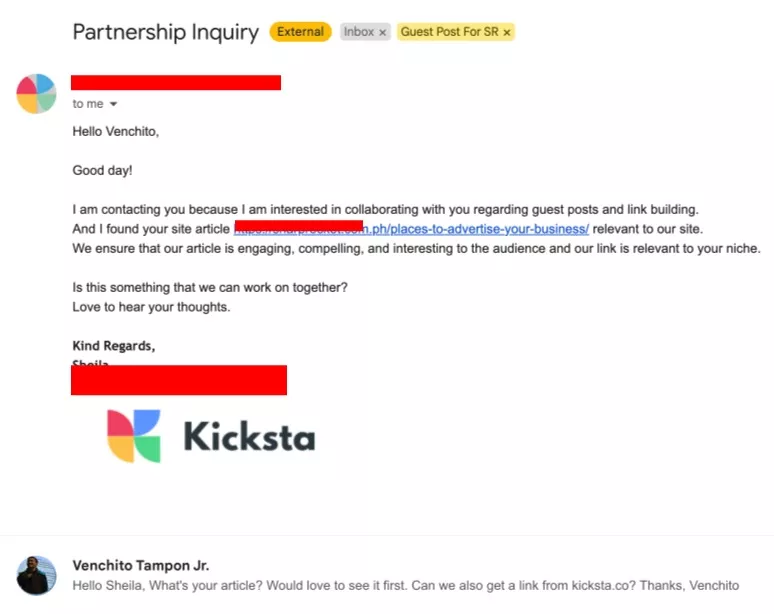
Exchanging contacts with a list of sites from which you have benefited can help leverage existing partnerships in scaling content-based link building.
10. Rank content for People Also Asked Questions
Blog posts are the easiest way to get SEO quick wins. By publishing informational content to answer commonly asked questions related to your product or service, you can initially rank for long-tail queries in your industry.
PAA (People Also Asked) questions can be found using Ahrefs’ Keyword Explorer - Questions.
You may use SearchResponse to collect questions relevant to your topic and see them ranked based on popularity.
There is also a ChatGPT-generated tool to give you the top PAA for a particular search query, along with the automated answers but on its improved version. See this StreamLit PAA tool.
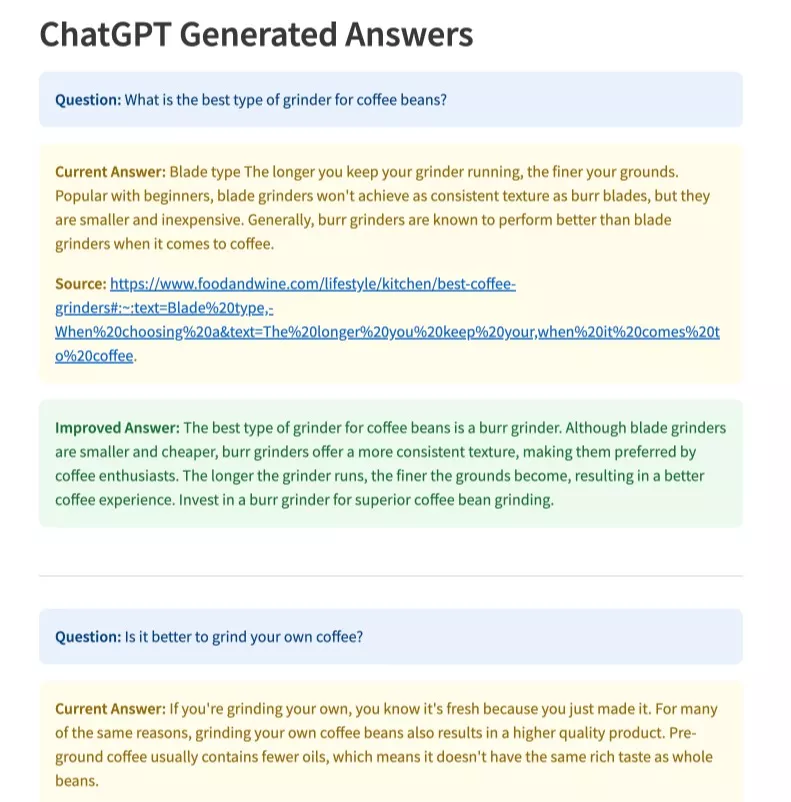
Final Thoughts
By focusing on SEO quick wins, you’ll gain initial significant results for your SEO campaign. You can make results for your clients without relying too much on substantial resources or budgets.
Do you want to scale organic traffic? Contact SharpRocket to learn more about SEO services, link building services, and content marketing services.
SEO Quick Wins FAQs
What are quick wins in SEO?
Quick wins in SEO refer to optimizing existing pages and creating new, SEO-optimized pages to achieve maximum impact. Focusing on both aspects can improve your website's visibility and rankings in search engine results pages. Implementing these strategies will help you quickly gain traction in your SEO efforts.
How can I get SEO results fast?
To get SEO results fast, you should implement these 15 quick SEO wins. By optimizing your website, improving site speed, conducting keyword research, creating high-quality content, and building quality backlinks, you can rank higher on search engines and drive more traffic to your site.
What are the top 3 SEO strategies?
The top 3 SEO strategies are keyword research, content marketing, and on-page SEO. These strategies will improve your website's visibility and organic rankings. You can enhance your website's performance and attract more organic traffic by conducting thorough keyword research, creating valuable content, and optimizing your website elements. Consider these strategies to boost your SEO efforts.
Does SEO show quick results for a business?
SEO is a long-term strategy that usually takes 3–6 months to yield noticeable results for a business. It's important to remember that SEO is a continuous process that requires ongoing effort and optimization to maintain and improve search rankings. Patience and persistence are vital to seeing the full benefits of SEO for your business.
SEO Outreach Guide
What is SEO Outreach?
SEO Outreach is the process of reaching out to content publishers and asking them to link to your content to improve your page’s visibility and rankings on search engine results pages (SERPs). Done with the intent to benefit both parties mutually, SEO outreach becomes a strong source of relationships and partnerships for the outreach specialist reaching out to potential link targets.
While anyone can send email pitches to any content publisher they’re eyeing, starting by identifying objectives for your SEO outreach campaign is much easier, more efficient, and more effective.
SEO Outreach Objectives
An effective SEO outreach campaign starts by having the right objective. Without a goal in mind, your SEO outreach will feel pointless, leading to zero to average results in link placement.
The key is to identify what specific goals you want for each of your SEO outreach campaigns.
Here are some critical key factors to consider as your main objectives for a link acquisition campaign.
Topical Authority
Topical authority refers to the credibility of your website about a given topic theme. By publishing more informative and comprehensive blog content about a niche topic, search engines, and search users see you as a subject matter expert.
This helps you to easily rank for informational and landing pages, as Google trusts you as a topical authority within the niche.
When sending SEO outreach emails, you think of establishing your topical authority. You suggest specialized topics when guest posting to build topical expertise on external websites. This sends off-site signals to Google that you’re a go-to personality in your niche through topically relevant content, author info, and other pertinent E-E-A-T factors.
Rankings
One of the main objectives of SEO outreach is to improve your website's online rankings by accumulating backlinks to your target pages. By sending valuable outreach emails, you can get a backlink that passes link authority and equity to its destination (your target page).
And through these links acquired, you increase the likelihood of your target page (informational or money page) dominating the top spot in search engine results pages (SERPs).
Having this main objective gives you the right mindset of providing value to the email recipient (your potential linker) in exchange for a backlink.
Brand Strengthening
Rankings as the primary reason for SEO specialists today when doing SEO outreach. It could also be the downfall for many who only do it for links.
Another perspective is your outreach team’s ability to strengthen your brand by getting backlinks from entities you’d like your brand to associate with.
Through brand strengthening, you make your website the top-of-mind in your industry when discussing certain topics or subject themes. This allows you to generate more branded searches, which helps in improving your site’s online rankings.
Brand strengthening also helps you earn natural links constantly from content publishers who see you as a topical authority in the niche. Most often than not, they link to your resources from their content as they trust your brand as a go-to source of information for every topic available in your industry.
By achieving that, you’re likely to earn links from sites that don’t need to do any SEO outreach.
Sales Perspective
Search engine optimization is not only to drive any traffic but to attract search traffic that has value for the business. From a business and sales perspective, SEO is one of the main drivers for online revenue.
Thinking of this mindset can change your game in SEO outreach.
You'll pick the right backlink prospects by thinking of entities, content publishers, journalists, and brands that can help drive additional conversions to your site.
You’ll see every content publisher you’re reaching out to has the potential to drive direct and online revenue to your brand.
How to Do Link Prospecting For SEO Outreach?
Link prospecting is the first initiative in SEO outreach. It is finding the right websites suited to your link building campaign. And by being the right fit, it completely depends on the situation.
For instance, some SEO professionals prefer to target high Domain Rating (or Domain Authority) websites, as these can immensely pass link authority to your site. Others want low domain rating sites for their local client, leaning towards topical local relevance, much more than authority-level metrics by link intelligence tools.
In link prospecting, you can make a manual approach or scrape outreach lists through SEO tools.
You can do a Google search for manual link prospecting, combining advanced search operators and topics on Google and other search engines.
How to Scrape SEO Outreach Targets?
The easier path to scrape SEO outreach targets is via link intelligence tools like Ahrefs.
Let’s say you want to target pages linking to your competitors. You can reverse engineer their links by plugging their domain into Ahrefs’ Site Explorer. Then quickly go Backlinks report to see all websites linking to their brand.
Filter the results based on your link metrics. For instance, choose only websites with Domain Rating 20+, in-content, and have passed do-follow links to your competitor.
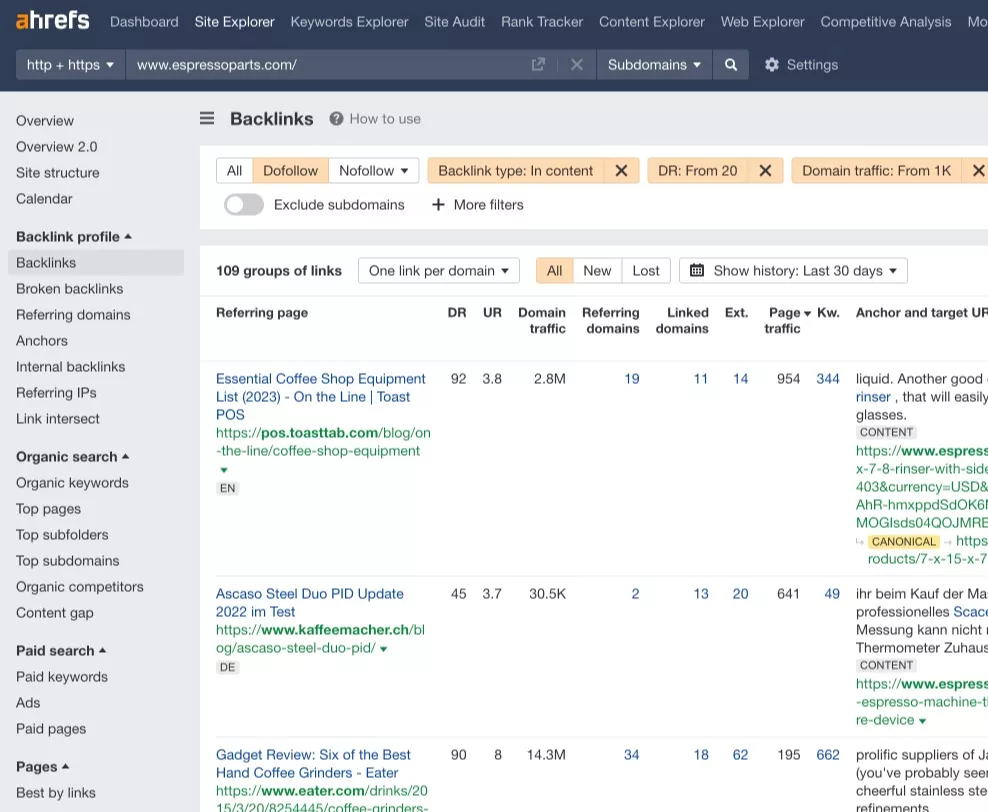
You can scrape these outreach targets by exporting the backlink report directly from Ahrefs.
How to Qualify Link Prospects?
The last result you want to see is getting your website hit by penalties stemming from aggressive link building strategies and being associated with spammy, low-quality sites.
Setting your own criteria to qualify SEO outreach prospects is integral to link prospecting.
Topical Relevance
The basic yet underscore factor of backlink qualification is knowing when a website is topically relevant to your website.
This guide by Glen Dimaandal of SearchWorks shows you the degrees of relevance, and you can incorporate them into your link acquisition campaign.
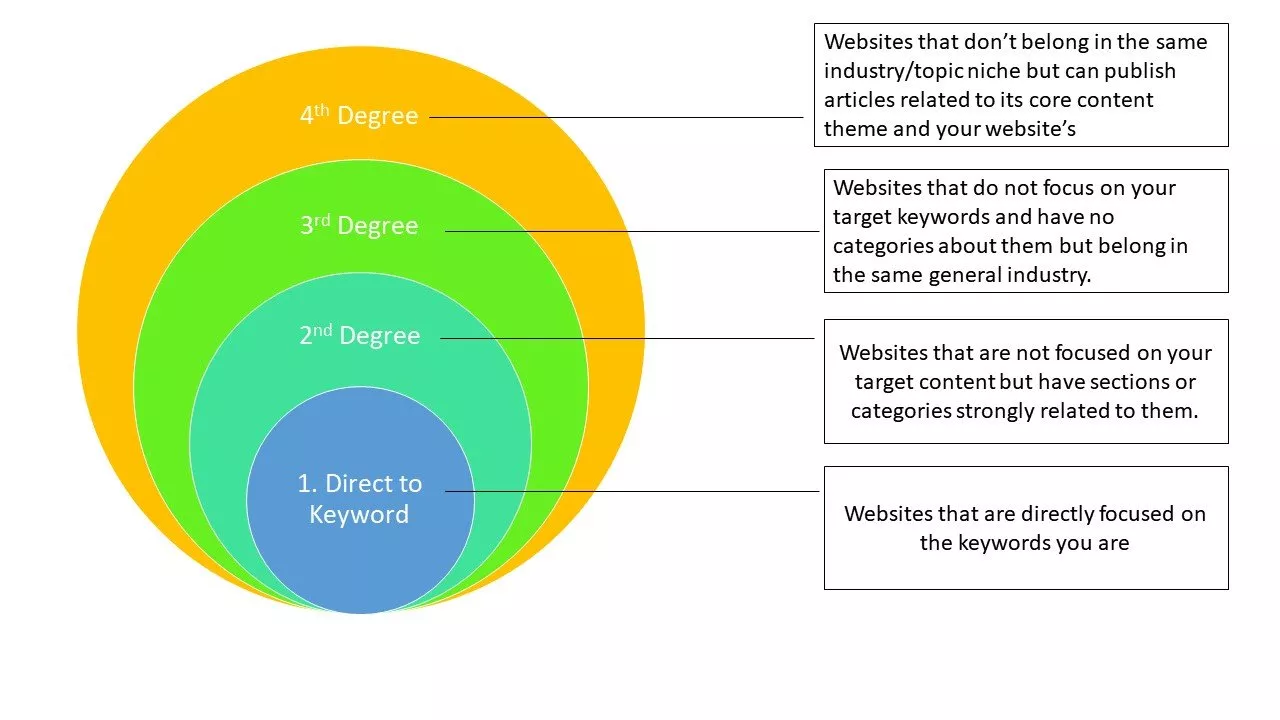
I recommend going after websites directly focused on the keywords you’re trying to rank for. Initially, try to get most of your first degree links before jumping into 2nd, 3rd, or 4th.
For instance, if you’re doing guest posting for a retailer of espresso machines, go for niche websites that especially talk about espresso (first degree) or from coffee websites with espresso or coffee articles (second degree).
As you get limited link prospects, you can find food blogs (third degree) and home and lifestyle blogs with coffee-related articles (fourth degree).
The last thing you want to do is to get high-quality links from completely irrelevant domains. You’ll be investing tons of resources, leading you to nowhere.
Authority and Trust Metrics
Link intelligence tools like Ahrefs and SEMRush give you a quick number of the site’s authority based on these tools’ metrics. With Ahrefs, there are Domain Rating (domain-level) and URL Rating (page-level) metrics to check the site’s authority from a scale of 1 to 100.
The higher the DR of the SEO outreach prospect, the more potent link authority it can pass to your website.
You can use Majestic SEO”s Trust Flow and Spam Score to check the website’s trustworthiness for trust qualifiers. Their trust metric is based on how closely related your site is to their own set of seed-trusted sites. Their team curates and manually reviews these seed-trusted sites for anyone to manipulate their ranking score.
Potential Organic Traffic
In your SEO prospecting, you can come across domains with high Domain Authority (e.g., DR50+) but with less than a thousand organic traffic.
This is a loophole for many SEO professionals not considering the site’s organic traffic.
One main factor you must consider when vetting SEO outreach prospects is the site’s ability to drive referral traffic to your pages through the links you’ll get from them.
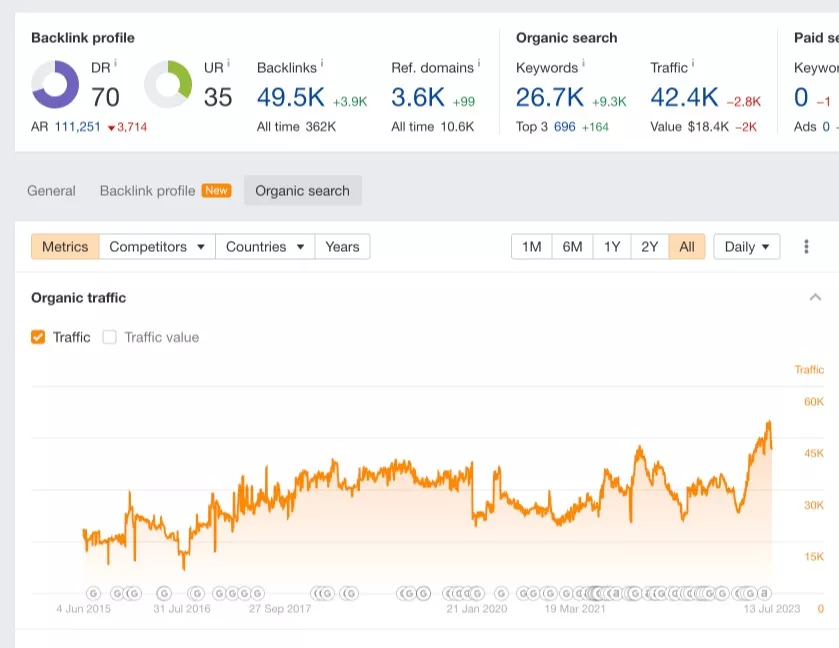
With Ahrefs, you can see how much traffic a specific page gets organically from search engines. Adding this to your metric toolbox can help maximize the value of links you’ll acquire for your site.
Link Obtainability
Can you get a link from the page/website? What types of resources are needed to acquire the link? Is there a need for new content (guest post or destination content hosted on your site)?
Most SEO professionals focus on relevance, authority, and trust-based metrics when checking if the site fits them, but not link obtainability.
Link obtainability is the ability of the website to provide a backlink to your site voluntarily.
For instance, ask yourself if you’re getting a link from your eCommerce store's “where to buy” page. “Do you have products you’re authorized to sell so you can be included in the manufacturer’s where to buy page?
If you’re writing a guest post for a high DR publisher, do you have writers in your team who have expertise on the subject and can craft high-caliber content?
All these things must be considered before doing your SEO outreach campaign, especially during the outreach stage, where you negotiate or request a link from your link prospect.
SEO Outreach Strategies
Different approaches to acquiring links from your link prospects constitute different link building strategies that fit your website.
Initially, you want to know what link acquisition strategy you can use to get inbound links.
While this list isn’t massive, you’ll find new techniques to capture an audience and get a link without being too aggressive with your SEO outreach campaign. Let’s dive into each SEO outreach strategy.
Choose highly specialized topics when guest blogging.
If you’re unfamiliar with guest blogging, guest blogging refers to writing a new piece of content on other people’s content publishing site that adds value to their readers while having a contextual link to your website.
These days, you’ll see in your inbox “crappy guest posting pitches” with a generic list of topics they have sent to multiple blogs already. Without considering the blog’s traffic, intended audience, and other pertinent success factors to ensure they’ll provide value to your readers.
You may receive one of these email pitches that starts with “I’m a big fan…” or “I’ve read your blog..”, which are awful, inauthentic outreach templates.
Choosing highly specialized topics is one of the best things to stand out in guest blogging.
If you’re targeting a high domain authority website, you’ll find they have a list of topics they want their outside authors to cover when writing a guest post. This means they have strict guidelines for the editorial piece regarding word count, content theme, and links you can only use as references.
All these correspond well whether or not you’ll have the opportunity to land a guest post on their blogs.
By choosing highly specialized topics, you’re writing about topics they don’t normally publish on their blogs, as they haven’t incurred enough expertise on the subject. Thus, most of their topics only cover ones they know about.
By being different with your chosen topics, your SEO outreach campaign stands out, leading to a more positive response and, eventually, a guest post you wish to have.
For instance, in the SEO space, most digital marketing agencies and bloggers pitch topics about link building and content marketing. However, only sometimes do you see guest posts on analytics and UX.
By going after these highly specialized topics that require extensive experience to develop actionable content that provides value to readers, you stand the chance of being a few of the authors these high authority sites accept in your industry.
Reverse SEO outreach
Reverse SEO outreach is building content assets that other content publishers want to get links from (not only building links to).
Instead of requesting linkers for backlinks to your content, you let them come to you and ask if they can be included in your content.
How’s that possible?
You use link roundups to get outreach emails from brands wanting to be included in your post. Brands want to be on your “list posts” where there’s likely an opportunity to get referral links and sales through clicks.

So, instead of using link roundup as a value proposition to approve link requests from other content publishers, you use it to bait brands and content creators to send you outreach emails. This way, you got more leverage than when you reach out to these people for link requests.
The best way to initiate this is to come up with a solid idea of what entities, brands, and content publishers you want to curate that are relevant to your site and has the potential to attract outreach emails after it ranked for their keyword.
Establish Thought Leadership in Outreach Emails
The missing values in most SEO outreach emails are authenticity and credibility. When people see you as an authentic person, writer, or expert, you increase the trustworthiness of your email.
One way to increase response and link placement rates in your SEO outreach emails is to position yourself as an authority in your industry.
Include a corporate signature if you’re sending from a digital agency or in-house SEO team.
Mention authority sites you’ve written for, especially ones that have been top-of-mind in your space. Entities you’ve been associated with that can be useful as social proof to be perceived as a thought leader.
You may also choose topics their site is missing to write about that can help increase their site’s organic traffic via ranking. Use Ahrefs to plug in the domain and see what topics could be useful for the site to bring additional organic traffic. Tap into Ahrefs' Content Gap Analysis and see what their competitors are currently ranking that your content publisher isn't yet.
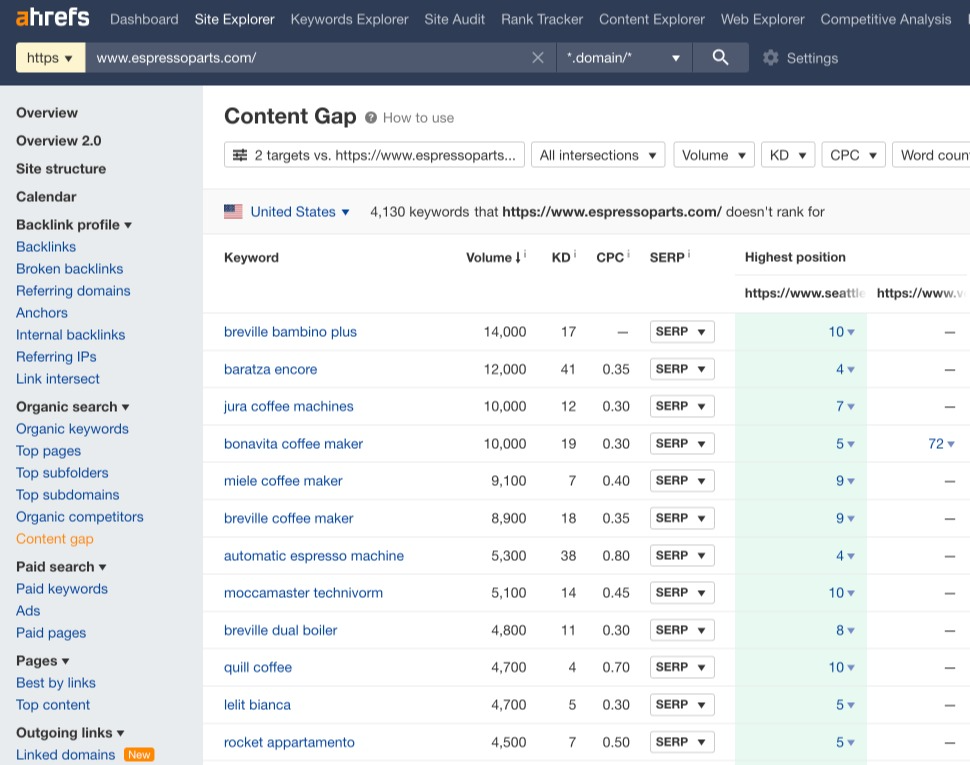
Relationship Building
Sustainable link acquisition requires building stronger relationships with other content creators.
By focusing on a few yet highly valued content publishing sites, you leverage resources, which include creating new regular content pieces - allowing for a steady number of links for your site.
Build relationships with active guest bloggers in your industry. You can use Ahrefs’ Content Explorer to find these authors quickly.
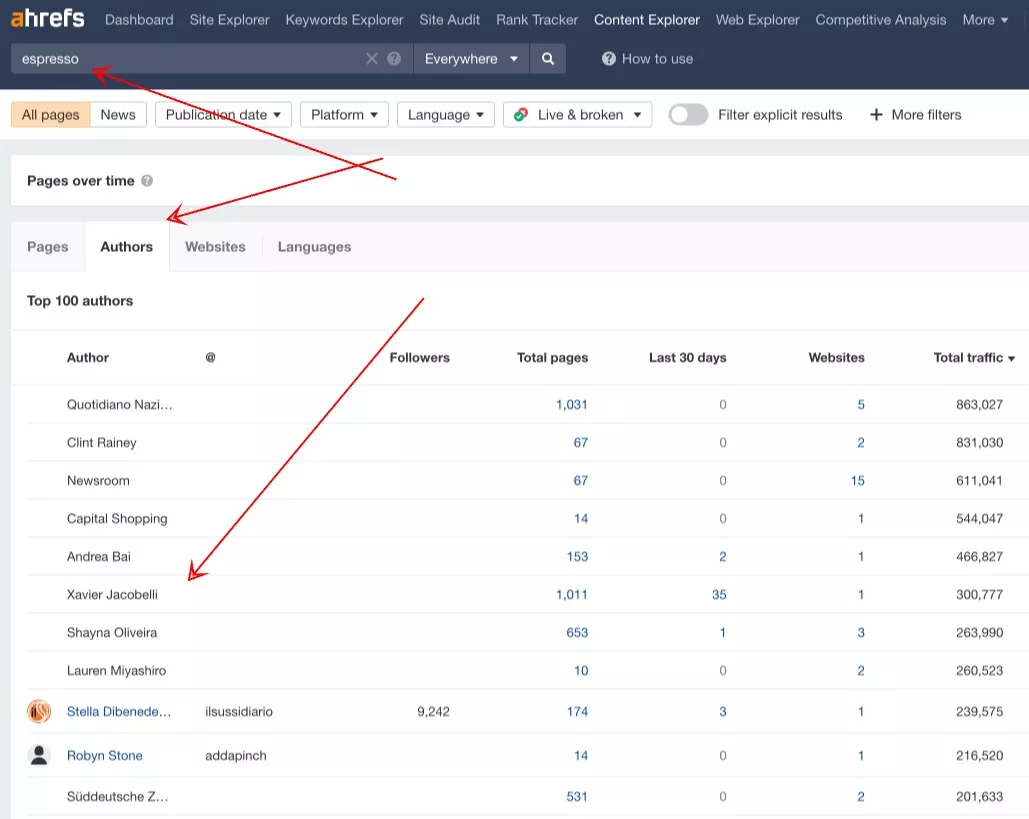
Check their website to see if they write guest posts for their clients or their own websites.
Reach out to them and offer links to your future guest posts, pointing to one of their articles. And in return, ask if they can also provide links to your site from their future guest posts.
Peer Review
I got This SEO outreach strategy from Jason Acidre’s talk on advanced link building.
This link building strategy aims to get niche experts to review your content asset, ask for feedback, and improve it based on their recommendations.
By doing so, you improve the quality of content by allowing thought leaders in your space to add more points, include some data, or have them review your content.

You can include them as peer reviewers at the bottom of your article to increase the trustworthiness of your content asset (which is a big factor in today’s Google E-E-A-T).
A peer review strategy is also a way to initiate connections with thought leaders you want to associate with your brand without being aggressive or using traditional techniques, such as interview requests.
Semi-Personalization at the Initial Outreach Stage
The SEO outreach campaign is tedious work. Most link builders give up after their first few attempts.
One of the hurdles in link acquisition is the scalability issues, as it would consume hours to send individual personalized emails to your link prospects.
In our link building agency, we send semi-personalized emails at the initial outreach stage. This saves hours from highly personalizing emails when some of which may not incur responses.
Include the name of your contact person, a quick overview of your content, or your offer. Then once there’s a positive response, you can write a lengthier email about your offer/content details.
By doing so, you scale your SEO outreach campaign by focusing on link prospects that are obtainable for link requests.
Use Creative Approaches in SEO Outreach
Test new SEO outreach strategies for fresh new links and double down on these efforts when there are tangible results.
The key is to keep traditional SEO outreach strategies from boring you. Look at other industries, see what they’re actively doing, and have gotten positive results with it. Replicate their effective strategies and make them worthwhile for your context.
SEO Outreach FAQs:
What is SEO outreach?
SEO outreach is a strategic approach to building high-quality backlinks through research, valuable content creation, and effective management. Businesses can enhance their online visibility and improve search engine rankings by identifying and placing relevant links on external websites. A well-defined process for selecting and monitoring link performance is crucial for successful SEO outreach.
What does an SEO outreach specialist do?
An SEO Outreach Specialist researches link building opportunities on quality websites manually and with SEO tools. They conduct outreach campaigns, monitor progress, and build relationships with partners, webmasters, and influencers.
What are the outreach techniques for SEO?
To enhance your SEO outreach, produce high-quality content, and generate interest. Identify key influencers in your industry and engage them. Participate in online communities and leverage social media to promote your content. Keep an eye on your competitors and use tools for link prospecting. Contact journalists and bloggers for additional exposure.
What is an SEO outreach manager?
An SEO outreach manager is responsible for identifying and securing client link-building opportunities. Their main task is to convert brand mentions into links, which helps improve the client's website visibility and search engine rankings.
How to Improve Content Writing Skills (53 Actionable Tips)
What is content writing?
Content writing is a form of online writing that aims to convey a message targeted to an online user on one buyer's stage: viral, discover, consider and customer.
What is content?
Content is anything that adds value to the reader’s life. It could be in a form of text, image, video, audio, product, ideas and messages that can build trust and authority with your readers and customers.
Content marketing is a buzzword. You probably have read hundreds of articles on how to create and write content that can engage readers and potential customers, but at the end of your reading time, you still ask yourself, "How can I apply those content writing tips and strategies I just read?".
This guide gives you 54 actionable content writing tips you can apply today.
How to Improve Content Writing Skills (53 Actionable Tips)
1. MAXIMIZE CONTENT TIME WITH EVERNOTE
Productivity is an important element in content writing.
The more you can maximize your resources wisely, the more time you can spend on actual content drafting resulting in a better quality of content.
One way to do that is to use Evernote.

It’s a great tool that you can use to create drafts for your content.
Whether commuting to places or having informal meetings with your other team members, maximizing the tool for effective brainstorming, content outline, and drafting is a better way to maximize time than doing nothing else.
2. FOCUS YOUR TIME WITH TOGGL
Ever wonder how many words you can write every hour on average?
No?
Remember, every task that is worth doing should always be tracked. The same goes for content writing. If you can track how many hours you can write every single hour, you can also easily set goals for a content writing project. This is very helpful if you are a content writer and are getting paid hourly.
One of my favorite productivity tools is Toggl.
It’s free and has a user-friendly interface. Check out the image below – this is how I tracked my hours of outlining, getting relevant references and resources on the web, and writing the actual draft.
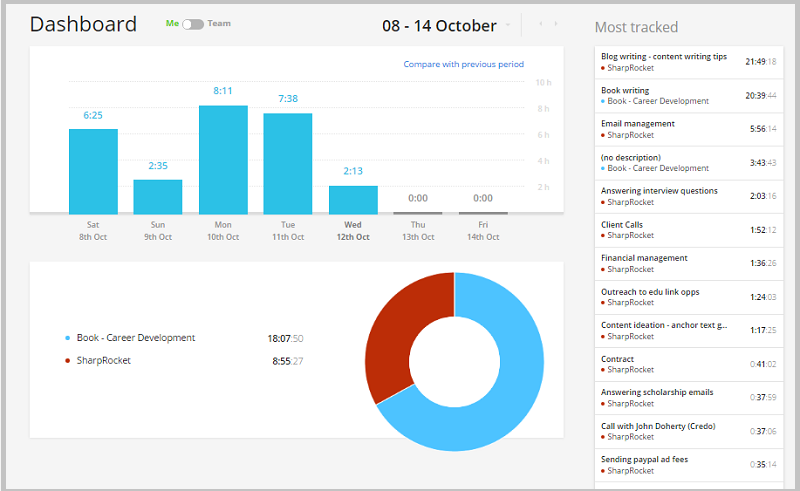
3. CAPTURE INTEREST WITH APP METHOD
Aside from writing headlines, one important skill that every marketer and blogger should be good at is engaging users in the first few sentences of the content.
The introductory part can either set the visitor's mood to continue reading it as it provides information on what the overall content will bring to the table or get him to leave the page because it doesn’t satisfy his intent.
The APP method, a copywriting method that Brian Dean popularized, makes content easily relatable.
Here’s an example of how Brian Dean implemented this method.
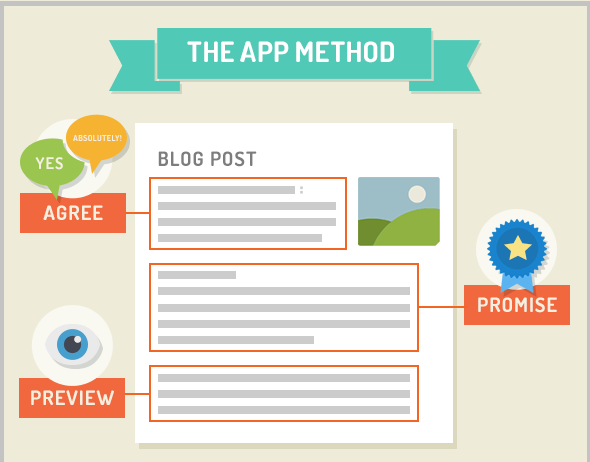
If you are struggling with writing the first paragraph of your content, try the APP method.
4. LEARN FROM COMPETITORS’ TOP PAGES
Ahrefs is web-based link research that tracks a site’s most-performing content regarding link growth and the number of social shares.
It helps you easily grasp which type of content your top competitors heavily promote and receive natural links from relevant sources. Here’s how can you do it.
STEP 1: Make a list of your competitors. If you don’t have any, ask your clients or do a Google search for your main keywords and see what brands pop up on the first page of search results.
Tip: Know if they are direct product/service-oriented or content competitors. The clue is in the keyword you choose if they are commercially based or informational.
STEP 2: Plug it into an Ahrefs tool and look at its top pages – you can click on the “best by link growth” to give you linkable assets that are continuously generating natural backlinks.
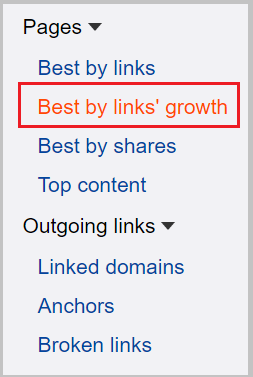
STEP 3: Generate ideas from their top pages. Note sections that can still be explained and discussed on deeper levels.
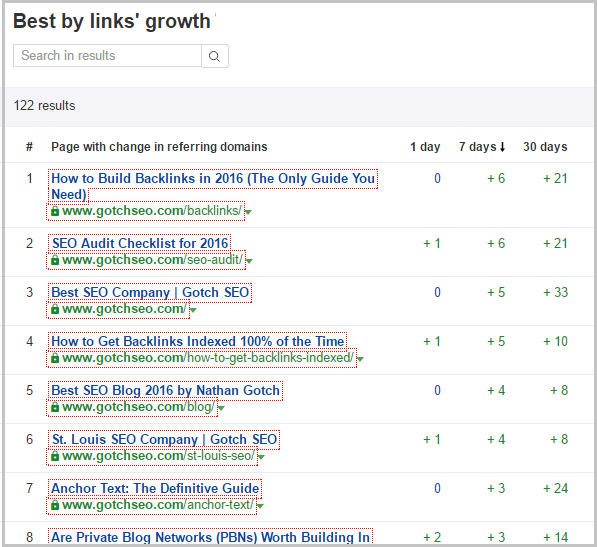
5. LEVERAGE EXPANDED GUEST POST
An expanded guest post is a coined phrase by Brian Dean that can help increase your content’s engagement and potential linking capacity by giving adapted readers a new taste of the information.
How to exactly do it?
STEP 1: Make a list of information in your industry based on the audience of your target guest blog. Provide actionable points as this type of content (how-to’s) is more repeatedly shared and linked to by other content producers.
STEP 2: Expand your points by adding more details – more so with detailed steps. This allows your target readers to apply immediately each point you have discussed.
STEP 3: Repeat this to all your distributed content – e.g. guest posts.
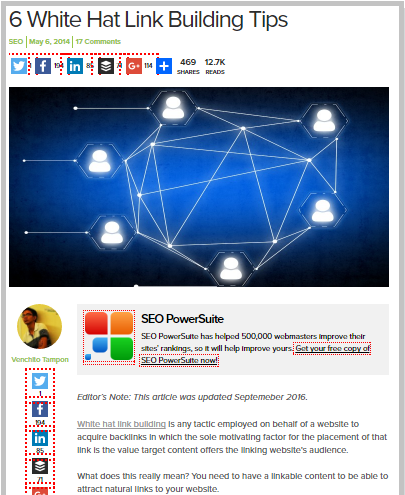
6. KNOW THE FIRST AND BEST RULE
When there are millions of content being published on the web, there is no other way to make your content stand out but to make it better than others.
The question is, how do you do it?
STEP: Type in your target keyword or your topic in Google.
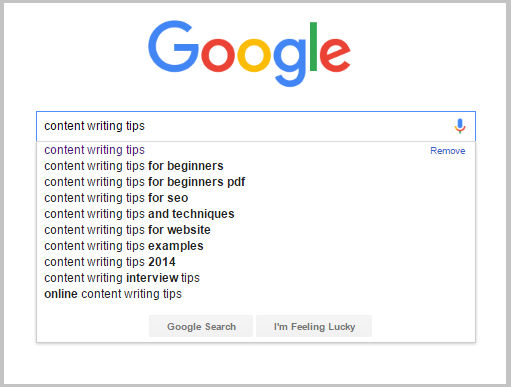
STEP 2: Read the top-ranking pages (if you don’t have much time, you can skim). Find missing points where you or your team can explain much in detail. Note these points and make a list.
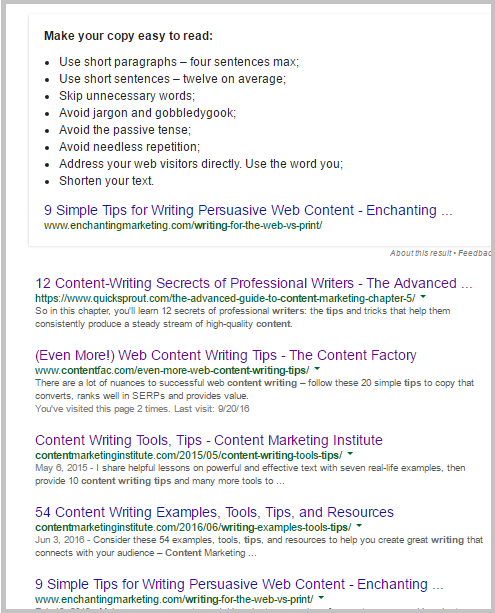
STEP 3: If other blogs don’t overly discuss your topic, i.e. there are only 2 or 3 in the ranking pages specifically covering the topic, that’s a good one you can pursue – make the content better than those 3 content assets or be the first one to comprehensively provide information on one subject if you don’t have any competing pages.
7. FOLLOW INFLUENCERS FOR CONTENT INSPIRATION
To build your content’s credibility, you must ensure your examples are real. If not based on your life stories and experiences, link to bloggers, experts, or influencers with similar references.
Start following these steps:
STEP 1: Create a public or private list of Twitter influencers/experts in your industry. Most of the time, if they are active content creators, they’d share their best secrets, experiences, and examples of their work. These are goldmines if you’re trying to look for case studies and references, EVEN IF you still don’t want to write at that moment.

STEP 2: List the latest content they’ve shared on their blog and their recent valuable Twitter posts – you might want to use them as references in future posts. You can use Notepad, or the best is Evernote, as you can easily sync it whether you’re online or offline.

STEP 3: As you write your content, return to your content references list and get what you think would be useful to add to your draft. Now, you don’t have to do Google searches to find useful resources you’ll externally link to your content.
8. GET A PROOFREADER
If you are a blogging newbie, this tip might cost you a few bucks. But if you’ve been blogging for years, one way to make sure you improve the quality of your content – is by having someone look over it (proofread and edit). Since last year, I’ve hired a freelance proofreader to check all grammatical errors in my article, whether they’ll be published on my blog or distributed to others as guest posts.
Here are a few steps to make the most of outsourcing your proofreading task.
STEP 1: Find virtual assistants who have experience with copywriting and editing. Go search in Onlinejobs.ph or Upwork for freelance copywriters, editors, or writers (some have a good background in proofreading too).
Tip: If you don’t have much time, ask your colleagues if they know someone good at editing/proofreading or go to Facebook content marketing groups.
STEP 2: Interview and hire someone you’re comfortable working with. Write an outline as to the tasks and process you wish to implement. For example, in my case, I want my editor only to add changes (still have to accept/reject) – there’s a feature in Word document for this. This can help me see my errors first before making the change so I can avoid them the next time I write the article.
STEP 3: Accept or reject changes. Put your content into your WordPress dashboard and publish it.
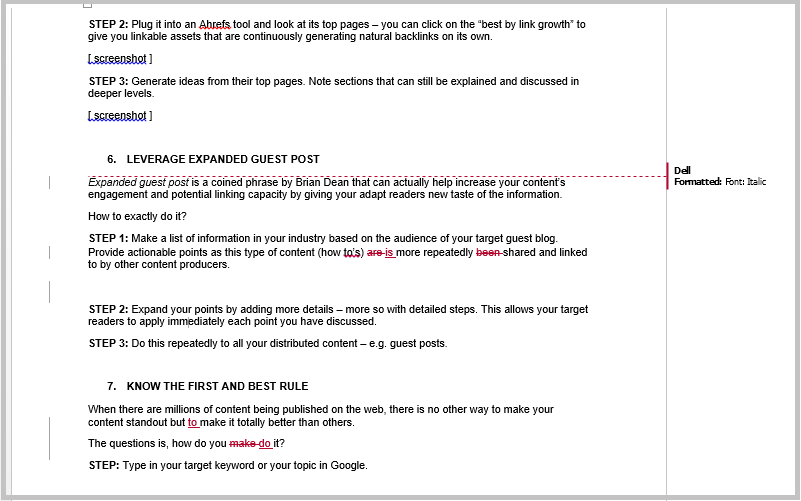
9. WRITE A SERIES TO CREATE EXCITEMENT AND ANTICIPATION
You'll probably get more new visitors when you see your Google Analytics account than returning ones. You want a higher percentage of returning visitors depending on which traffic sources you’re looking at.
What you can do to achieve that goal is to let your readers anticipate the next content you will publish on the blog. How?
STEP 1: Think of the type of content that will precede your next to-be-published content. It could be sneeze pages (learn more about it here), best of sections (e.g. Crazyegg best of content), or a series of content (one example is this content marketing tutorial of SEO Hacker).

STEP 2: Set the tone of anticipation in your next content by adding a call-to-action at the end of the post. One good example is how they let their readers know about the series and why it is something they should look forward to.
STEP 3: Promote your content series to your email subscribers and social followers.
10. USE TOOLS TO BUILD A HABIT
Distractions can get in the way easily. What we need to develop as content writers is the right focus toward the goal – finishing the writing task within the day.
If you want to be more productive daily, follow these steps:
STEP 1: Install any of these tools to break your habit of procrastination: Focus or Forest. These tools are useful to help you get into your “focus” zone.
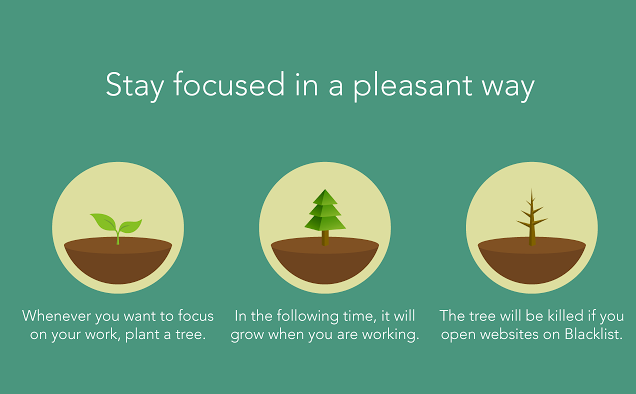
STEP 2: Be accountable for finishing your task by opening up your preferred productivity tool. The web-based product also helps you track how many hours you spend at work, on social media/leisure, etc.
STEP 3: Be determined to finish your tasks with the help of the tool.
11. CREATE CONTENT BASED ON THE BUYER’S INTENT
Success without an objective is useless. You don’t have a metric or KPI to measure your performance – making it easy to produce mediocre content.
Hundreds of businesses, whether startups or big corporations are now investing in content marketing because they’ve seen returns from their investments – particularly with brand building, brand exposure, and lead generation.
How can you create content with a business objective in mind?
STEP 1: Identify your objective as a marketer, whether you are working for an agency, client, or for your own website. Set key performance metrics (learn about this here).
STEP 2: Identify pages you have on your site and match them to the marketing funnel. Know what pages you must create to facilitate your visitors into the buyer’s journey. Sample image from Webris.
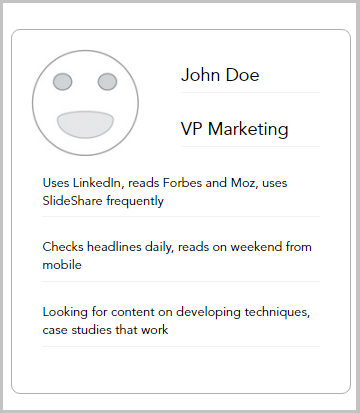
STEP 3: Create a spreadsheet that shows what buyer’s intent each target page will be targeted to. You can do your topical research first before doing this.
12. IDENTIFY YOUR AUDIENCE’S PAINS AND PROBLEMS
Informational content will best serve its audience if it solves a particular problem in the industry. If it’s something you think you haven’t implemented yet with your content marketing strategy, you can do it with these tips.
TIP 1: Find industry threads in forums and Q&A sites and look for patterns of problems and pain your content should best serve.
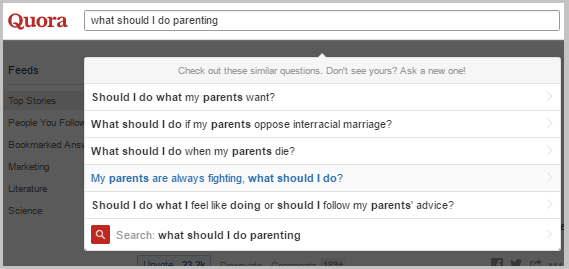
TIP 2: You can also skim through comment sections of top blogs in your niche. Some online readers happen to share their struggles by asking questions to influencers.
TIP 3: Don’t think much about keyword volume. If you target long-tail topics, you’d be surprised to get some long-tail traffic by creating content that answers a specific question.
Tip: Read this guide for reference on optimizing content for the Google answer box.
13. USE WIKIPEDIA TO FIND OLD LINKABLE CONTENT ASSET
Wikipedia pages acquire a lot of editorial links and mention from relevant blogs, making it an evergreen linkable asset when linking inbound links grow over time. Taking advantage of this by determining which Wikipedia pages relevant to your industry are evergreen linkable assets helps you brainstorm great content ideas.
Here is how you can start it out:
STEP 1: Find Wikipedia pages in your industry by using this tool or doing a Google search for site:wikipedia.org [keyword] + “dead link” (or “citation needed”)
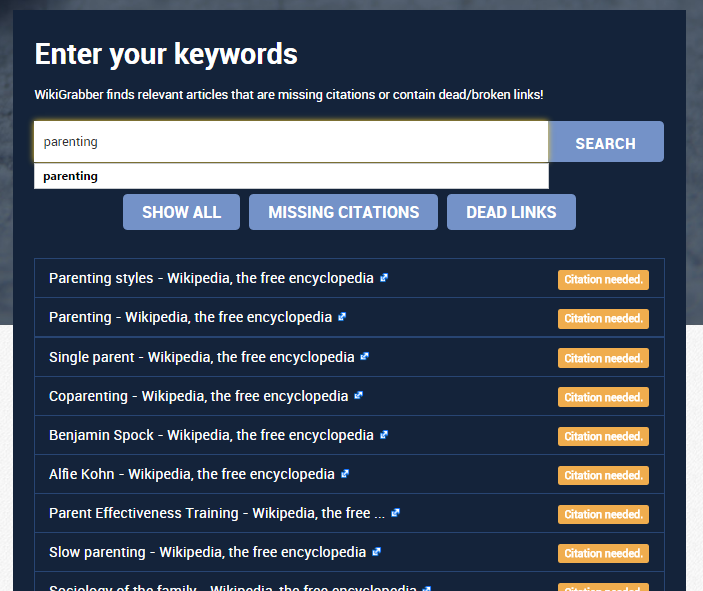
STEP 2: Determine how many referring domains are linking to each Wikipedia page to assess how linkable the topic is (~100 referring domains is a good number).
STEP 3: Create content that covers the topic of the Wikipedia page you choose. Make it as comprehensive as you can, so it’d be easy for you to nudge linking bloggers of that Wikipedia page to mention your similar content in their blog posts.
14. END YOUR CONTENT WITH AMAZING CALLS-TO-ACTION
Some content writers still haven’t utilized the power of calls to action as part of their content creation phase. It’s saddening that people aren’t signing up for an email list or even following a certain Twitter profile because there’s no call-to-action added at the end of the post.
Look at some of the best call-to-actions I’ve seen on other blogs.
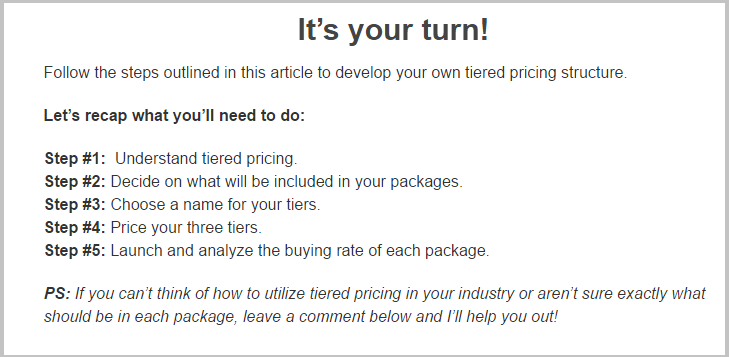
Writing a call-to-action takes only 2 to 5 minutes, so be sure to have it as you write your final draft.
15. STRUCTURE YOUR MOST IMPORTANT CONTENT WITH A YELLOW BOX
Design and user experience make a lot of difference in engaging blog readers. When they land on the page, they don’t just read your whole blog post but look at other elements that’ll make it easy for them to understand the topic. Elements like images, videos, presentations, and custom boxes give more emphasis to some of the most important parts of the content.
I’ve first seen the use of “yellow box” in Brian Dean’s post. No big thing here, but it makes it interesting that it allows specific content to be emphasized within the whole content, especially if you’re trying to write a long-form type (~2500 words).
STEP 1: You can add this code to your theme’s “functions.php” file (or “custom_functions.php”on Thesis) to create a yellow box.
function make_yellowbox($atts, $content = null) {
return '<p style="background: none repeat scroll 0 0 #ff9; clear: both; margin-bottom: 18px; overflow: hidden; border: 1px solid #e5e597; padding: 13px;">' . do_shortcode($content) . '</p>';
}
add_shortcode('yellowbox', 'make_yellowbox');
STEP 2: Once the code is added, any text wrapped inside of this shortcode below will appear in a yellow box.
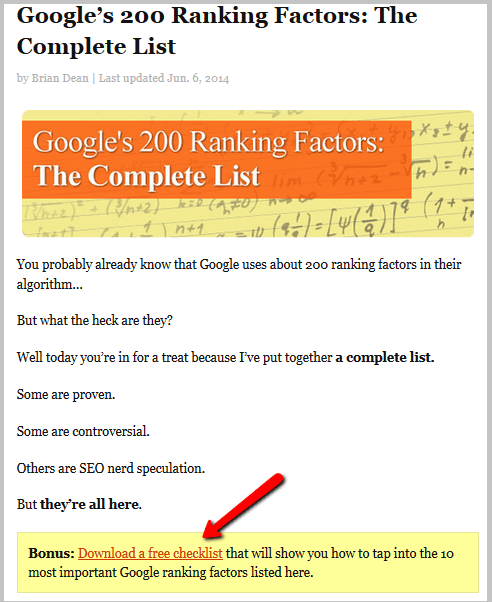
STEP 3: Emphasize your most important subtopics, quotes, features, etc.. using the yellow box feature.
16. STRATEGICALLY LINK TO YOUR INTERNAL CONTENT
As you write your initial or edit your final draft, knowing which relevant webpage you can internally link to your content is best. You can follow these simple steps if you’re a newbie blogger and want to be smart at internal linking.
STEP 1: Go to Search Console – Search Traffic – Analytics (if you haven’t connected your Google Search Console to your WordPress site yet, check out this guide).
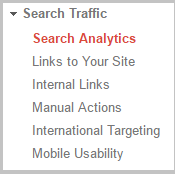
STEP 2: Find pages with high impressions and CTR but are sitting in positions 11 to 20. This is to get these pages to improve their ranking by adding new internal links.
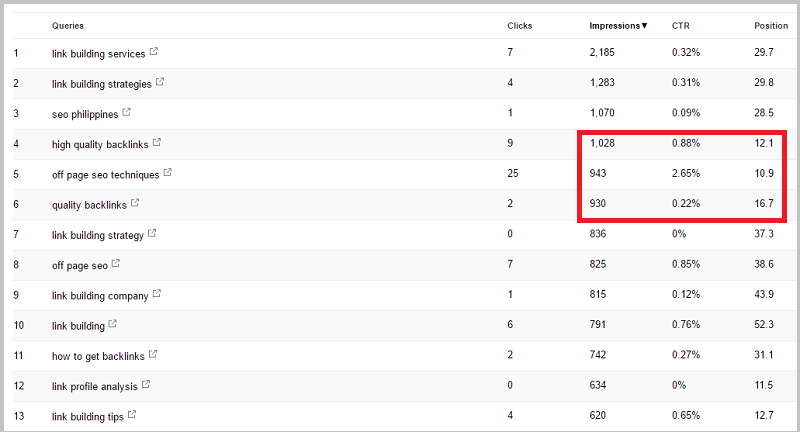
OPTIONAL: If you have thousands of pages, you can also do a Google search for site:yourdomain.com “your current topic” to find pages relevant to the content you are currently writing.
STEP 3: Link to your preferred thematically related pages from your content.
17. PUT SCHEDULES TO EACH WRITING PHASE
You’ll read most productivity articles about how to break down a huge project into small tasks. While this is very useful, something is missing here. Even if you break a huge project into smaller ones, you want to ensure you can commit to completing every small task.
The same goes for content writing. If you’ve got a huge content writing project, here’s what you can do to ensure you can publish your content on or before the deadline.
STEP 1: Break your huge content writing project into smaller tasks. For example, if you are targeting to write 5000 words in length type of content, then you can divide it into five smaller tasks (writing 1000 words at a time).
STEP 2: Set schedules to finish each small writing task. You can use free project management tools like Trello to make this possible.
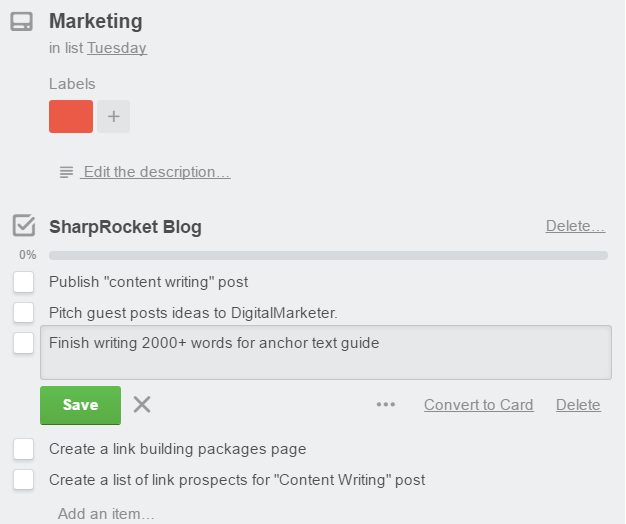
STEP 3: Don’t procrastinate. Achieve your goal daily by completing all small tasks.
18. USE MICRO SURVEY TOOLS TO GAIN VISITOR INSIGHTS
Customer insights play a vital role in content ideation. If you can identify what your customers want, it’ll be easy for you to create content that caters to their intent, specific to their levels in the buyers’ journey. One way to do that is to use a micro survey tool. Follow these steps.
STEP 1: Install Qeryz plugin in your WordPress account.
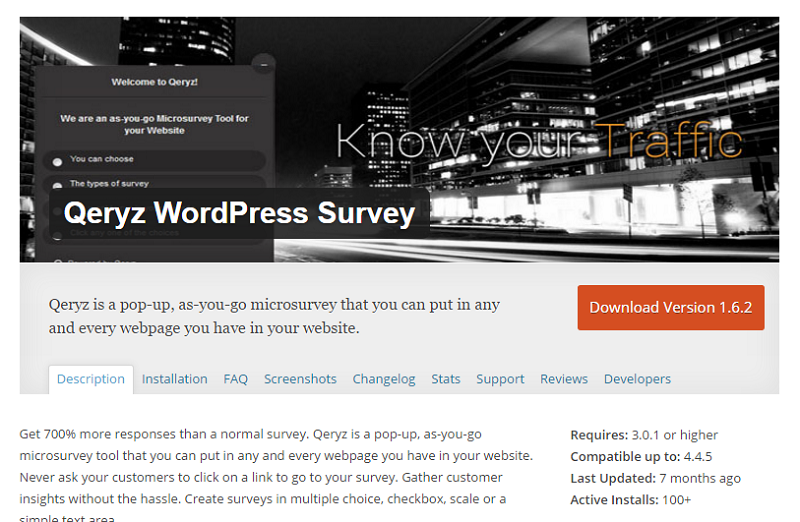
STEP 2: Gain insights using their platform. You can ask what type of SEO professional they are, then proceed to another question like what topics they’d like to read.
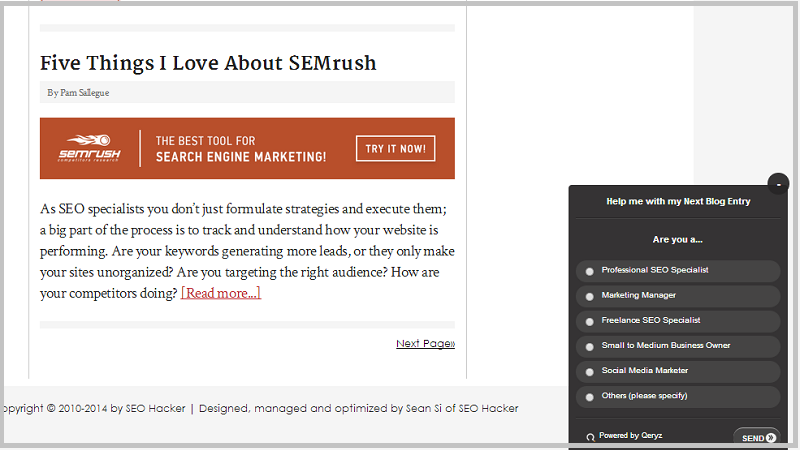
STEP 3: Create content based on your gathered insights – what content type and format they’d like to see published on your blog.
19. UNDERSTAND PROPER BLOG POST STRUCTURE
Structuring your latest article, like how you plan and build a house, is almost the same. To make a great foundation for your house, start by planning everything. Here’s how you can do it.
STEP 1: Create a list of topics, subtopics, and points you want to discuss in your article.
STEP 2: Bundle all topics together. Look at points that you can compile into one subtopic. Make sure you don’t overlap points in every subtopic you have.
STEP 3: Use this blog post structure from Zazzle Media to ensure the organization of your content.
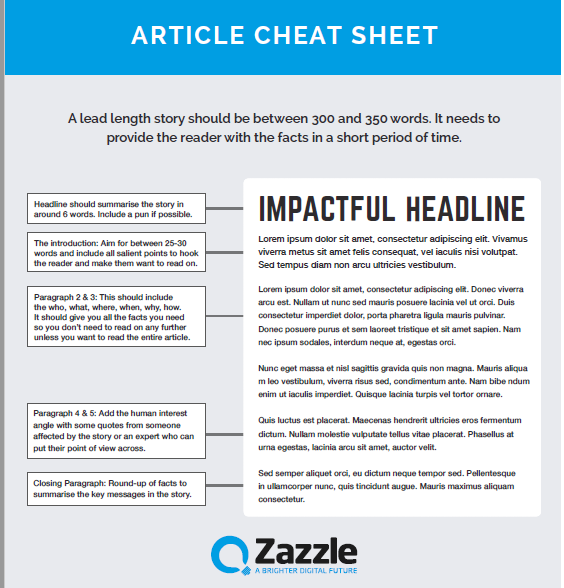
20. USE SUCCESS AND FAILURES AS YOUR CONTENT IDEA
Stories tell a lot. They’re actionable, real-life, and life-changing.
If you can share something that can teach valuable lessons from your experience within 1 year or so, use that as your next content idea.
Here is a sample from Matthew Woodward’s top blog post – How I Build a Top 100 Blog in 12 Months.
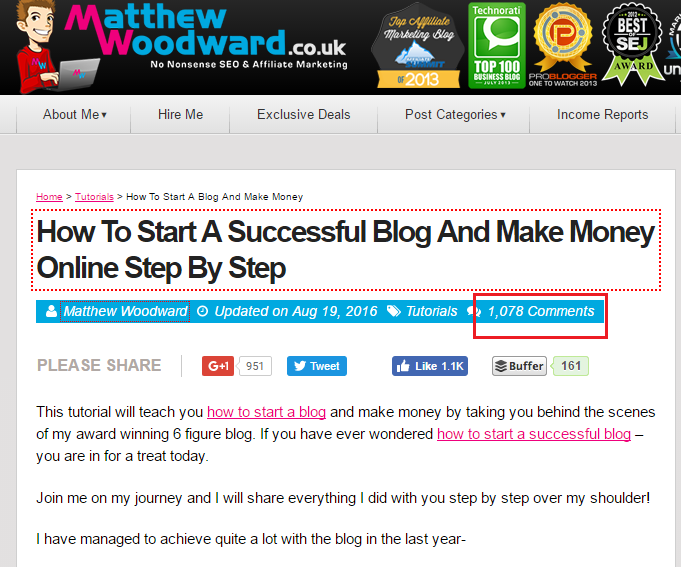
You can apply these tips to make your success and failures a great content asset.
TIP 1: If you have internal data like screenshots of month-to-month organic traffic or growth of email subscribers, include them in your content. This will increase the credibility of your page content.
TIP 2: Show results at the beginning of your post to build initial interest from your readers, especially those new to your blog.
TIP 3: Share how you accomplished your success by detailing steps to make it easy for readers to follow the process by themselves.
21. WRITE ABOUT INDUSTRY MISTAKES
In any industry, there are always mistakes to commit. For parents, it would be exchanging time at home with more work in the office. For search professionals, it would block important pages in your site’s robots.txt file. Whatever it is, there are always mistakes in your industry; you can use that as your content idea.
Start with doing a Google search for [your industry] “mistakes” or inurl:mistakes [your industry] or intitle:mistakes [your industry] to find blog pages and forums that cover that specific topic.
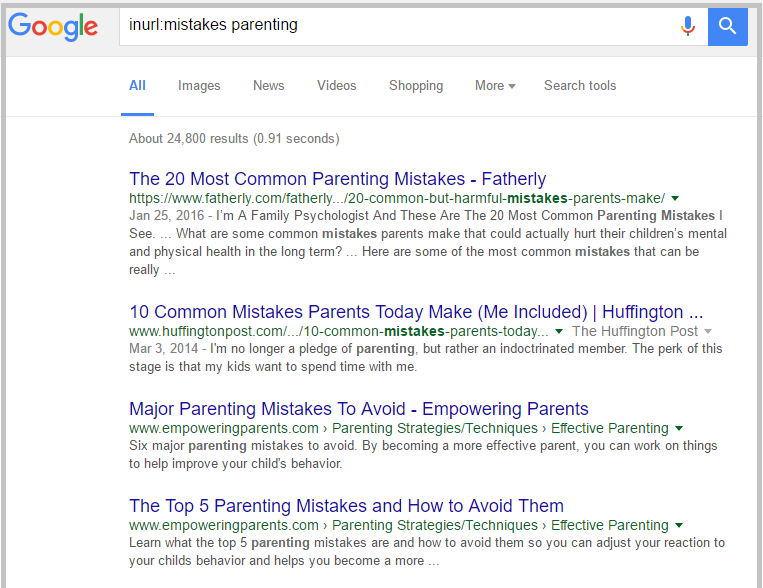
Note that in your content ideation or brainstorming tool, if it’s feasible for your writing team to discuss.
22. GET INSIGHTS FROM REDDIT AMA
Reddit is one of the top user-generated websites, where experts' insights can be best seen on its Ask Me Anything (AMA) sections. Follow these steps to generate ideas for your content.
STEP 1: Go to Reddit and search for [topic] AMA; then, you’ll see a list of AMAs recently conducted by Reddit moderators.

STEP 2: Find relevant Ask Me Anything threads and skim through each question and answer part. Consider using any insights or potential topics as your content ideas for blog posts.
23. SEE COMMENTS ON OTHER SITE’S CONTENT
I’m not talking about these examples of blog comments.
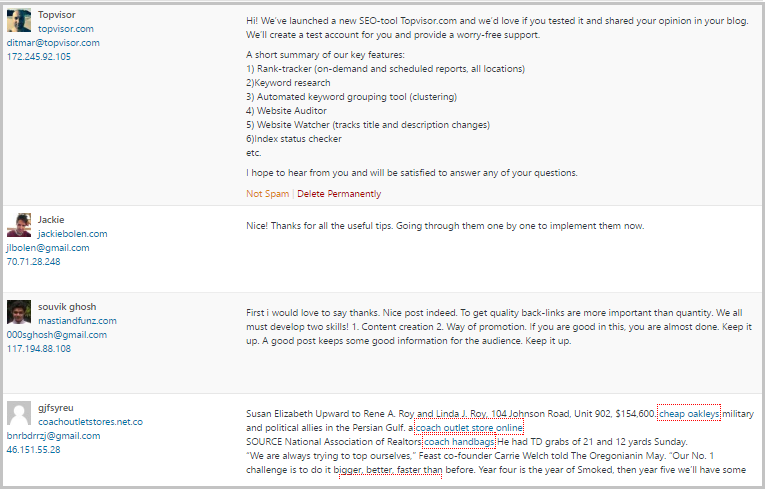
But many other valuable comments on other blogs’ content could potentially be your next content topic.
Let me give you an example. This Whiteboard Friday post by Michael King garnered a lot of comments in the SEO and link building community.

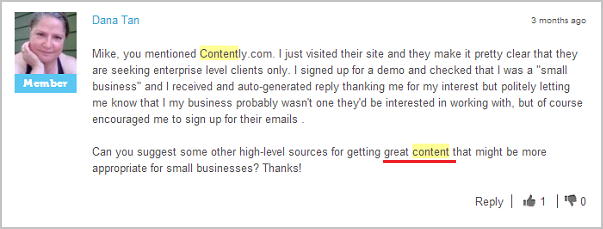
If you search for specific terms, you’ll notice some of the comments can be your potential topics for content (if you’re blogging about SEO).
Pro tip: Click the box saying, “Email me when new comments are posted,” right below the post of your target site. This will help you track if there is a new comment on the blog post. You’ll receive a WordPress email when someone comments on the post. Some blogs in your industry have this feature in their comments section, so take advantage of it.
24. SEEK INSIGHTS FROM EMAIL SUBSCRIBERS
An email newsletter is one of the most profitable sources of content ideation. Why? Given that your customers subscribe to your email list (assuming they intend to), you know they want to get more information from your brand.
Take a look at this email:
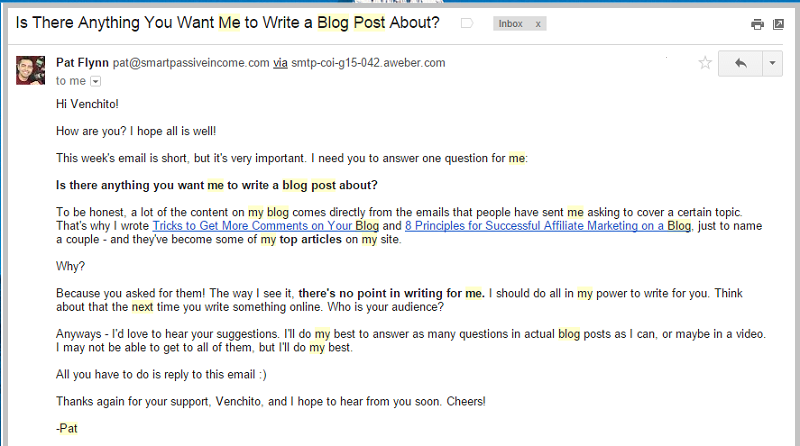
If you notice the question, it’s straightforward. “Is there anything you want me to write a blog post about?”
The next time you send emails to your subscribers, add a call-to-action at the end, asking them to give you their suggested topics to write about. If you’ve got a huge list of subs, it’s a guarantee you will get replies.
25. USE TWITTER LISTS FOR CONTENT UPDATES
One notable feature of Twitter that content marketers haven’t found worth using for their content ideation process is the Twitter list. If you can create your own Twitter list or find any public lists of influences you’ve been following for a long time, then that’s a goldmine of content topics you can take priority the most.
How to get started?
STEP 1: Check out each Twitter profile of your industry's influencer(s) or experts. They may have one or two Twitter lists that are publicly available. For example, Ross Hudgens created his own Twitter list of content inspiration. Given that we’re in the same blogging area, I can subscribe.

STEP (optional): You can create your own Twitter list featuring all influencers, preferably bloggers in your niche. Take this image below as your example. It’s my own bucket of off-page SEO, content marketing, and internet marketing bloggers. Their regular tweets inspire most of the content here at SharpRocket and Digital Philippines.
STEP 2: Check out every link they are sharing on Twitter. This can consume a lot of time, so set it aside either late in the afternoon or evening. Use Evernote to list all links to every article they’ve shared. This allows you to organize all of these resources quickly.
26. CUT OUT UNWANTED FILTERED WORDS
As a writer and blogger, one big mistake I made in the past is trying to please my readers with flattering and unnecessary words. You can relate to this, right? When starting out in blogging, you’ll find yourself adding more words that shouldn’t be added, which makes your overall content crappy as you do it all the time.
Instead of saying very, very good, you can say excellent. Instead of saying Today, I will tell you about it, say I’ll tell you about it.
Making your content as straightforward and succinct as possible is important to engage your readers better. In your next writing time, filter your words by cutting out unwanted phrases.
27. FIND FAQS IN YOUR NICHE
Google provides results for frequently asked questions with quick answers, satisfying every online user who does every search query.
In essence, if you are making a habit as a content marketer of finding FAQs and servicing each valuable question with the right answers, you are producing new types of content that can drive direct traffic by ranking 0 in Google – if you happened to be caught as a top direct answer. Check out this example. I’m getting some good traffic by ranking for this query.
How to take advantage of this?
STEP 1: Use FAQFox to find commonly asked questions in your industry. Simply do searches for any relevant keywords in the search box.
STEP 2: Pick a category to start filtering questions targeted to your industry.
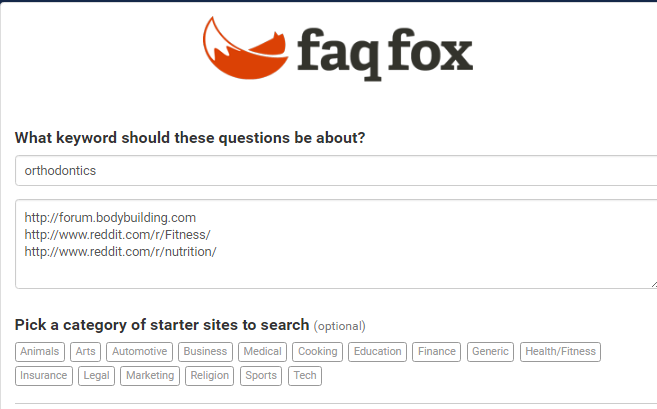
STEP 3: FAQFox will provide a list of commonly asked questions that are good considerations for your next content. Find any that will fit your blog categories and start answering them in your posts.
28. GET TRENDING TOPICS USING AHREFS
For advanced content marketers, it’s common to use Buzzsumo to find the most shared content on the web and of your competitors.
If you use Ahrefs as your primary SEO tool, maximize their content explorer features. It’s quite a recent feature that allows you to find top content with many social shares and referring linking domains.
How to maximize Ahrefs for content exploration?
STEP 1: Type in your head term or next keyword phrase in their search phrase. Choose in title in their options to only find blog posts with an exact head term in their titles.

STEP 2: Filter results based on your preferences, either all-time or a set time period, language, specific Social account share, or referring domains. Make sure to click one article per domain. Filter based on your needs.
STEP 3: Check each link in search results and identify new trending topics you can consider for content creation.

Pro tip: View each detail (click Details) for link growth (referring domains graph) and organic traffic. This allows you to see if a specific content topic is linkable in nature, as it tends to attract natural links over time.
29. FIND SIMILAR CONTENT THEMES
Analyzing your own data is helpful to get new insights as to which area of topics you should be investing your content creation in. What you can start doing now is to look at your Google Analytics account. Follow these steps to identify profitable content themes.
STEP 1: Go to Behavior – Site Content - Landing pages and set your duration period for one year or three years, depending on how long you started blogging.

STEP 2: Sort them by the number of visits and conversions to see which content asset performs well in terms of business value.
STEP 3: Find similar content themes by listing their topics in a spreadsheet and looking at patterns of content areas each is aligned to.
30. DO 6-3-5 BRAINSTORMING
If you’re having a hard time brainstorming with your team using your office’s whiteboard and pen, then you need some alternatives to use for that purpose alone.
If you’re part of an agency, each individual or content writer will have 6 rounds each to suggest any content idea for a project they’re working on (assuming it’s a collaborated content writing project).
Six people, six rounds at 5 minutes per round.
This allows each content writer to participate in the brainstorming session, not just one – the content manager who does everything.
If you’re part of a big agency or team, this tool might help you brainstorm content ideas effectively.
31. BE MORE PRODUCTIVE WITH COFFEE
Productivity matters in content writing. When you know what specific hours you can do the work more effectively, you’ll see much greater results in less time. One habit you can start now is drinking coffee if you’re allowed to do so.
Drinking coffee helps you become more productive at work, particularly in content writing, and helps you be more alert and creative by setting your mood.
In this article from Time.com, the author shared the best times to drink coffee – between 10 a.m. and noon and between 2 p.m. and 5 p.m. You can drink two or three cups of coffee within a day – it’s up to you, as long as it helps you do more content work.
32. USE HORIZONTAL THINKING FOR BRAINSTORMING
It is sad when you’re trying to come up with ideas for a client sitting in a boring or, as they say, less creative industry. Let’s say, for a plumbing niche. You can’t think of broader topics than toilets, installation, etc. You’ll move away from the general content theme even if you do.
As such, one way you can do this is to think horizontally – others say it is tangential thinking. Whatever it is, it is a process of looking at the sideways. Take a look at this example from Moz.
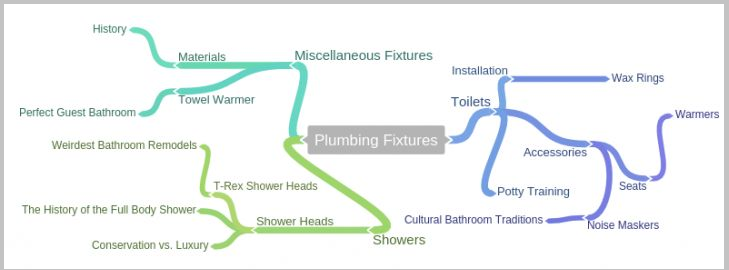
If you look at bathroom content ideas, you are only getting a small scope of audience. But if you can think laterally, consider other thematically-relevant ones like DIY and eco or environment-friendly concerns.
Did you get how this works now?
You can create a bubble chart to get started with it.
33. WRITE EXCERPTS FOR VIDEOS OR VISUAL PRESENTATIONS
Being resourceful should be every content marketer’s characteristic. Knowing what to prioritize with your list of content ideas and using what assets you already have can help you follow your content calendar – only producing high-quality content pieces.
One creative way you can do now is to collect all your existing videos, either produced internally or outside your organization. Once you have these internal content assets, choose pieces you think can be turned into blog posts. The key here is to identify if one particular video is something your existing readers/audience will care about.
Your next step is to write excerpts to be placed below the video content. You can hire someone from Upwork to do the work for you, or you can do it yourself.
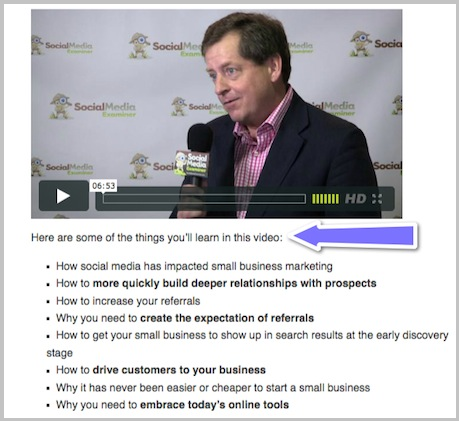
If you don’t know what content you should be producing next, start looking at your database, and see which videos you can translate into a blog post, with excerpts to preview details of the video.
34. ALIGN CONTENT TO BUSINESS GOALS
Setting business goals is essential to every business activity. You can’t put a specific KPI at your desk for your content writing or creation process without a goal first.
Now here are some quick tips to start defining business goals with your content writing process:
TIP 1: Be specific with your content creation goals. To be the best marketing agency is not a goal. It’s too broad, and there are a lot of factors before you can measure it. Below are some good examples of specific business goals.
GOAL: Rank on first pages in organic search for competitive link building terms.
SharpRocket is a newly established link building company. To be recognized as the best link building agency in the world, we need to rank highly for both commercial and informational keywords.
GOAL: Generate 200 inbound leads monthly with mid-level to large marketing budgets.
We must implement robust content creation and promotion campaigns to achieve that goal. We also want to ensure visitors from different traffic sources will convert into potential SEO clients.
These are just some of the goals that we have at SharpRocket. Knowing this will help our marketing and sales team set specific actions based on the goals set. From goal-setting, we can now set specific KPIs we need to achieve every month.
If you are an in-house content writer, it is best always to align what you write to your organization’s business goals in its digital marketing campaign. This way, you’ll be more motivated to provide the best quality content, given that you know where it’ll go.
35. CREATE YOUR AUDIENCE PROFILE OR PERSONA
When you strategize your content marketing campaign, you should never forget to create your own audience profile or persona.
It’s not rocket science. It’s very simple, and if you haven’t executed this yet for your website, you can follow these steps to get started.
STEP 1: Know your audience and be very specific with this. For example, our company targets three types of companies: SEO agencies, SEO, and digital marketing teams of big corporations and medium-sized businesses. We can create the following audience profiles using this as our starting point.

STEP 2: The next step is to know where these audiences spend most of their time online. This includes identifying what type of blog they frequently read or which forums they participate in. This isn’t just useful for content creation, but in massively promoting content to web places these audiences are familiar with.
STEP 3: The last but crucial part of creating your audience profile is to think of how you can add value to each of them. Each person has their own needs that your content should be able to address.
As you write your next content, don’t just write everything. Identify to whom your content is targeted so that you can get more results from your work based on the value provided by your content.
36. USE BLANK PAPER FLOW STATE
Writer’s block is common in content marketers, especially for newbie bloggers--though at some point, you can avoid it and make sure it’ll not happen to you all the time.
If you’re struggling with writing your introduction, take these simple steps.
STEP 1: Install Flowstate. This app allows you to write your thoughts continuously. The app deletes your work if you’ve been stuck or stopped writing for more than 5 seconds.

STEP 2: When you finish each part or section of your content, i.e. your introduction, copy and paste it into your Word document.
STEP 3: Use the app whenever you can’t write your first paragraph. This is a handy technique every content writer should consider.
37. MATCH HEADLINES WITH META TITLES
When people land on your page from Google search results, the first thing to consider is whether they’ll keep reading or not when they’ve found what they are looking for – user satisfaction.
I’ve seen this mistake most of the time. Bloggers tend to mislead their readers by mismatching headlines with meta titles. They’ll write the most clickbait meta-titles when their headlines and content don’t match their SERPs structure.
Don’t let this happen to your content writing campaign, as you’ll lose most of the new visitors you have on your website by misleading them with wrong information and not satisfying their intent, desires, and questions.
38. PREPARE EDITORIAL CALENDAR
As I always say in my blog posts, an organization is key to an effective content creation campaign. If you don’t take time to organize everything, you’ll miss out on some important details and make more mistakes at work.
Preparing an editorial calendar for your content marketing campaigns helps you to schedule and organize topics with deadlines attached to them. This helps you become more accountable for what you do.
Below is a sample of the editorial calendar template from Michele Linn, and you can download it here.
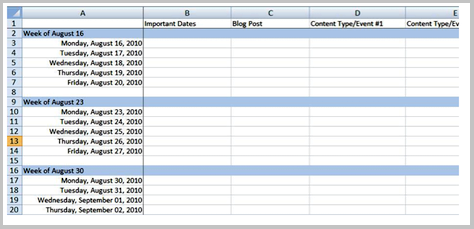
In her template, he tracks every blog post's information, such as post date, author, keywords, categories, tags, call-to-action, and status. It’s not near perfection, but the template can help you start with content execution.
39. KNOW ABOUT BLOGGING MOJO
Blogging mojo is a coined term by Darren Rowse that refers to a blogger’s motivation to produce high-quality content consistently. Consistent means, depending on the blogger's writing frequency, not just once every year but once or twice weekly.
There are many ways to get your blogging mojo back, especially if you’re being burnout by too much content work. Here are some that are most effective for us:
- Align your blogging style to your business goals. You wouldn’t worry if you’re producing quality content when you start to remind yourself about why you do it – and mostly, it boils down to providing value to your business or someone’s business – if you’re hired to write for them.
- Say the same things differently. Bloggers often stop writing because they think they always blog about the same topic. More often than not, they don’t know to find angles. You can blog about the same topic but attack its discussion differently.
- Get help from other people. If you can’t find a good blog post today, ask your email subscribers, mentors, or offline friends. You wouldn’t realize they have something to contribute to your content ideation.
40. FINISH BIG ROCKS FIRST
Top CEOs and business leaders start their day early in the morning, on average 6:30 A.M. Before distractions come, they’ll start doing the most important tasks of the day to get big wins even before the afternoon starts.
It’s interesting because content writers and bloggers might find themselves to be productive early in the morning. Depending on your work schedules, if you can try to get up early and finish the “big rocks” – your content tasks, you’ll be more efficient and effective with your content creation process.
Jeff Bullas, a popular blogger, spends his first five hours (4:30 am to 9 am) only on content writing. By finishing this big rock early in the morning, he can get most of his day growing his blog and acquiring more business value.
41. USE DOTS TO CREATE SUSPENSE
Engagement matters in content writing. If you can’t connect to your readers until the end, you’ll lose their interest at one point – leading to less time-on-page.
One technique you can employ in your regular blogging is the “dotting” technique. I always see this in Brian Dean’s Backlinko, where he uses this technique throughout his blog posts.


The dots create curiosity, keeping visitors reading until they reach the end of the content. Such a technique is much more useful for long-form content.
You can try the “dotting technique to your own blogging style and see for yourself the results of it (check your time-on-page data in Google Analytics).
42. THINK EVERGREEN
Content has lifetime value. Its lifetime value depends on how long its information provides value to its target audience.
Take a look at this, this blog post of mine in 2014 has been well-received by the content marketing and blogging community. It continuously gets new backlinks over time since more and more content marketers, especially those looking for additional references and resources, find it very useful to include in their latest blog posts.

If posts need continuous updates and changes in their context, invest in their update or revision to grow their organic traffic and build more audience around them.
43. LEVERAGE BUCKET BRIGADES
If you’ve started with SEO copywriting, I recommend you read this guide from Brian Dean. It compiles actionable copywriting techniques to help you effectively engage your readers – making them stay in your content from beginning to end.
One copywriting tactic that Brian Dean shared is the use of “bucket brigades”.
Bucket brigades or grease-slide words (its other referred phrase) are words and phrases that create a smooth flow of transitions between paragraphs and sentences. They minimize the friction of readers leaving the page and let them read the content like a greased slide.
If you’ve been an avid reader of link building blog, you’ll probably notice some of my posts have bucket brigades. Here are some examples.

You can add a few bucket brigades to your post (full list here).
The next time you write the draft of your content, try adding bucket brigades to make your readers stick to it.
44. USE PROPER FORMATTING
One overlooked factor when writing content is proper formatting. I always see this – plain content without tables, bullets, numbers, yellow boxes, etc.
There are simple and most common formatting options you can try to include in your content, such as:
- larger font sizes for quotes and headings
- underlined text for emphasis
- bullets for unordered lists
- numbers for steps to follow or lists ordered by importance
- indented paragraphs for quotes or testimonials
45. SEARCH BAR AGAIN THE SECOND TIME
Google autosuggest helps content marketers find new long-tail keywords that aren’t easily discovered using keyword research tools.
The first suggested search keywords are different from the second try.
Instead of just sticking your content ideation process with the first try suggested search phrase, try searching for Google suggested phrases the second time.
46. DON’T FORGET ABOUT GOOGLE-RELATED SEARCHES
If you are a newbie in the content marketing and SEO industry, you probably are unfamiliar with other keyword research tricks besides using the Google Keyword Planner.
Google provides suggested related searches connected to your current search query at the bottom of the search results page (SERPs).
This allows you to find other related long-tail keywords to include in your content to help Google perceive it as desirable to rank for other thematically-related phrases.
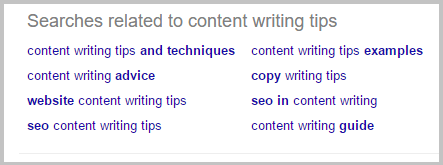
47. TRY ASTERISKS WILD CARD
If you are creating content in industries with things of different kinds and classes, like food recipes, you can take this search technique: asterisks wild card to find almost all types of things you’re trying to rank for.
Here’s one example.
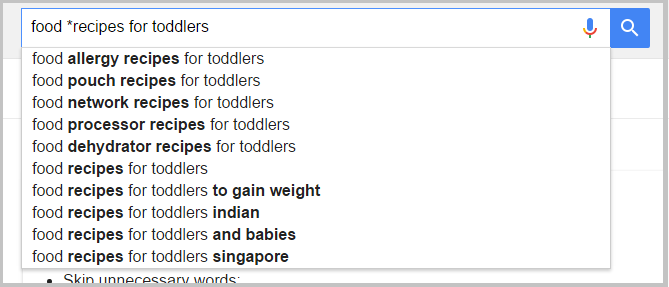
48. FIND PRODUCT ALTERNATIVES WITH VS TECHNIQUE
Decision-oriented online searchers are interested in finding products or services in an industry that will best fit their needs. Because they’re still in the decision stage, they’re looking for as many alternatives to products they’re already familiar with to assess each product or service's features and benefits. This way, they can make better buying decisions.
A Google query for product VS can reveal other brands (competitors and industry blogs) producing content on that same type – comparison type of content.
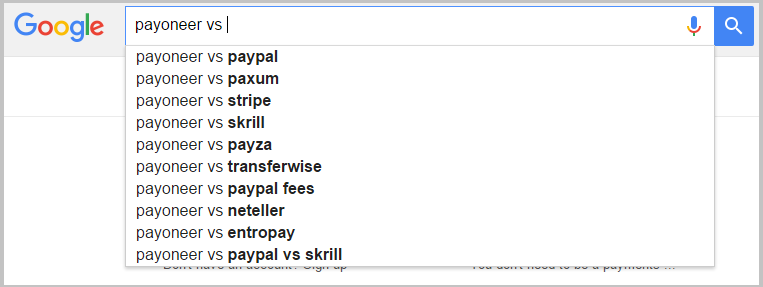
49. GET CREDIBLE SOURCES WITH FILETYPE
If you are creating robust content assets, you always have to consider the credibility of sources from which you’re getting information and data.
One way to easily find credible sources from experts, influencers, and popular brands that have secured significant case and research studies is by using the filetype:pdf research method in Google.
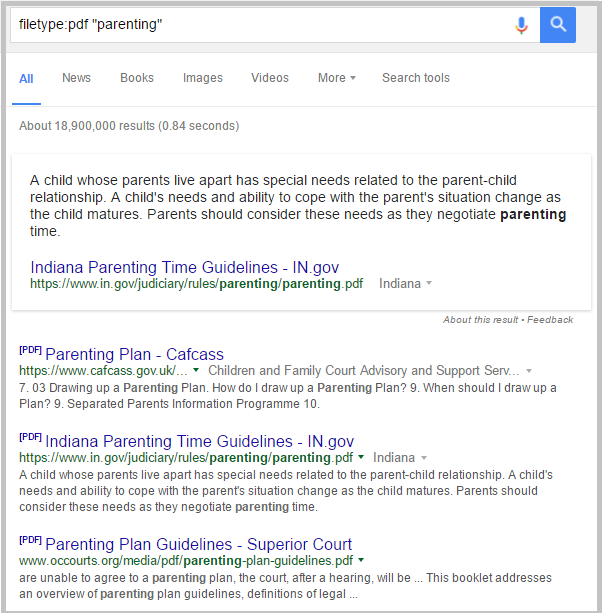
50. GAUGE TOPICS BASED ON THE COMMENTS COUNT
Typical reverse engineering has this process: find top industry blogs, plug into top link building or content tools like Buzzsumo or Ahrefs, then find which posts get tons of shares and links.
Glen Allsopp upgraded that approach by looking at the number of comments each post received as a basis for considering the topics’ high-interest rate compared to just focusing on social shares and links.
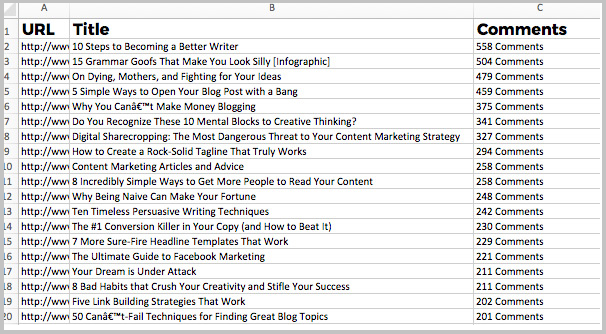
51. GET NEW INDUSTRY INSIGHTS FROM SLIDESHARE
Influencers are usually speakers in their own local communities or countries. If they have their own blogs, you’ll find them uploading their slide presentations to Slideshare and re-publishing them on their websites.
Slide presentations of influencers are top content ideation inspirations; you can take advantage by monitoring their latest speaking updates using Twitter lists or even finding the latest events in your industry. Do a Google search for [industry] seminar/conference/event [current year] so it can provide you with upcoming events as well as recaps of bloggers on a recent niche event.
52. USE CONTENT GAP ANALYSIS
I’ve been testing a scalable content ideation strategy that will get results for our clients, and this makes my top list – content gap analysis. Here’s how to start implementing this in your content marketing campaign.
STEP 1: Identify your content competitors – ones you are trying to compete for informational keywords.
STEP 2: Plug the URLs of their domains into Ahrefs together with the URL of your website.
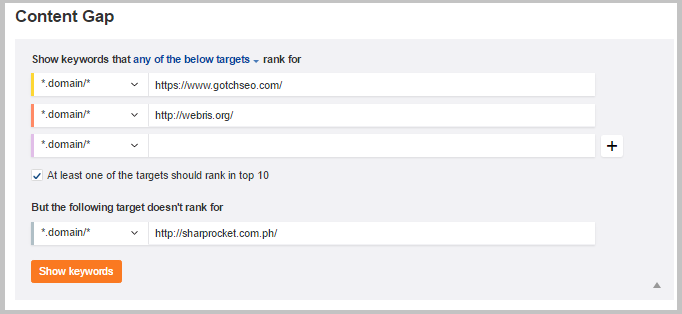
STEP 3: Export results to a CSV file, spreadsheet, or Google Docs sheet. The end result should be like this (image below). Check which keyword you can create content about with high potential to outrank your competitors.
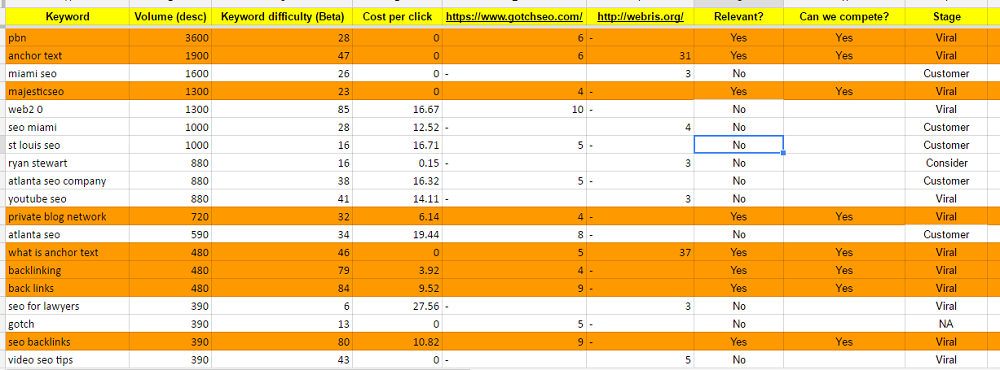
53. RESEARCH NICHE TWITTER CHATS
You will find different industry trends on Twitter alone if you are a social media enthusiast. There are hashtags plus keywords picked up by top news sites and blogs that always update their posts.
Niche Twitter chats are a content ideation source you should consider today if you’re a content writer or marketer.
These trending hashtags don’t just show up without any reason. So if you’re having a content brainstorming block in your head, try searching for industry on Twitter.
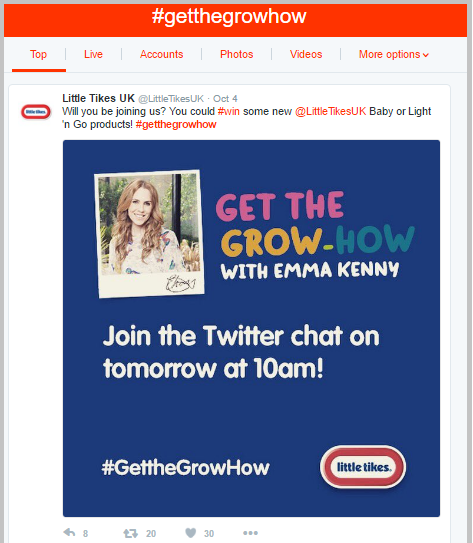
54. FIND TOP QUESTIONS ON QUORA
I’ve received many leads from Quora (see sample client inquiries below).

But aside from lead generation purposes, this top community website is also useful in generating topic ideas for well-perceived ideas.
What you can do is search for topical trends in Quora and list them down in a spreadsheet. Here is a screenshot of what I do. Though this is for content promotion, it’s one great start for content ideation. If you're doing content promotion, ensure you know how to find email addresses of your outreach targets.
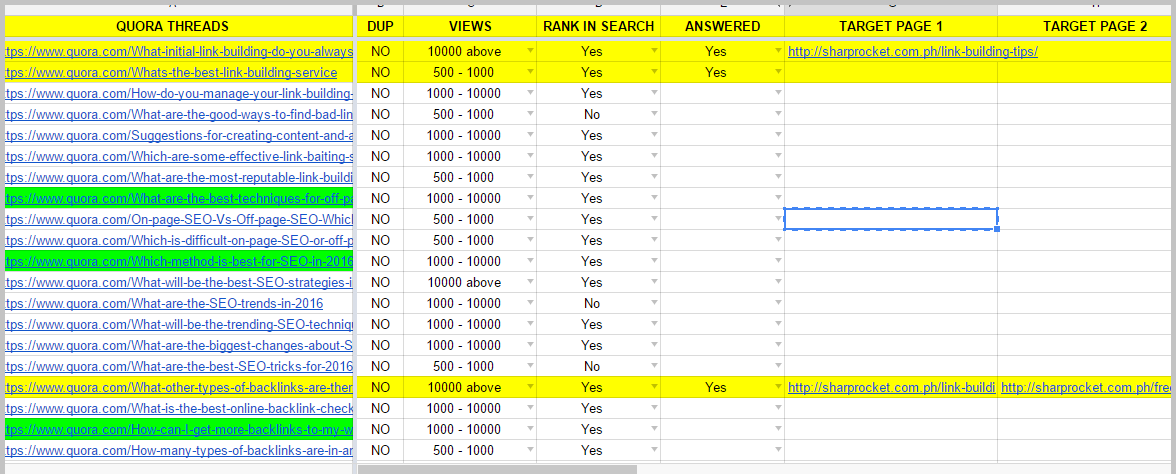
You can base your picking of topics on two things: first, rank in search – search the exact question on Google and see if they rank on the first page. The best should be on top spots 1 to 5. Second, if they are in a range of 10,000+ views or 1,000 to 10,000 views – this means that these threads are visited most of the time by community members and get pageviews from organic sources (from search).
Now It’s Your Turn…
What other content writing tips can you share?
Or maybe you have a question about implementing any of the strategies and techniques in our above list?
Either way, leave a comment quickly below.
I'll be more than happy to reply to comments and answer questions.
So if you have a question, insight, or new tactic, leave a comment right now.
How to Improve Content Writing Skills FAQs
How can I improve as a content writer?
To improve as a content writer, you can follow these 7 easy tips:
- Research your topic thoroughly.
- Use a clear and concise writing style.
- Create engaging and relevant content.
- Proofread and edit your work carefully.
- Incorporate keywords naturally.
- Use headings and subheadings to organize your content.
- Write regularly to practice and refine your skills.
Implementing these tips can enhance your content writing abilities and produce high-quality work.
How can I practice content writing?
To practice content writing, try these 6 top exercises, which are guaranteed to improve your skills:
- Embrace writing prompts
- Create a blog,
- Analyze and learn from successful content
- Experiment with different styles
- Collaborate with others
- Practice regularly.
These exercises will help you develop your writing abilities and become a better content writer.
What is content writing basics?
Content writing basics encompass creating, editing, and publishing digital content, such as blog posts, videos, ebooks, and social media copy. Professionals can effectively engage and educate their target audience by understanding the fundamental principles and techniques of content writing.
How do I train myself as a content writer?
To improve as a content writer, it's crucial to train yourself. Develop your skills by reading widely, studying grammar rules, and practicing writing regularly. Take courses or join writing communities for support and feedback. Additionally, stay updated on industry trends and learn from successful writers. Investing time and effort into honing your craft will help you become a better content writer.
How do I start freelance content writing?
To start freelance content writing, first, build a portfolio showcasing your writing skills and expertise. Next, create profiles on freelancing platforms and start bidding on relevant projects. Additionally, network with other freelancers and industry professionals to find potential clients. Finally, continuously enhance your skills and stay updated with industry trends for better opportunities.
Is content writing a tough job?
Content writing can be challenging, especially when searching for fresh topics that engage niche audiences or cover advanced subjects. As a content writer, you may face difficulty generating interesting ideas or deciding on new angles. However, organizing research and brainstorming sessions can help overcome these challenges and create compelling content.
Scholarship Links: How to Do It Right
Getting scholarship links to your website has been a practice in the link building industry for many years. It has been used by hundreds, if not thousands, of SEOs worldwide.
While most have successfully gained their desired number of resource links from scholarship pages, some people still can't find true value in adopting the strategy for their link building campaign.
This may not mean scholarship links have no value but show that these are less valuable than any other links in the website's backlink profile. There are also ways in which a scholarship link building campaign does not fit a business.
3 Ways People Incorrectly Use Scholarship Link Building
1. NICHE AUDIENCE
If your brand targets a specific audience (customer service representatives or neurologists), you may not find enough niche scholarship pages about customer service or neurology.
There is, of course,, another way to use scholarship link building to your advantage: to go abroad with your targeting — create a scholarship page for business students or medical students, for example.
If you do that, your scholarship links may be less valuable for your business. Relevance is extremely important, so I recommend you use highly relevant links for your scholarship program.
2. WEEDING OUT HIGH SCHOOL PAGES
Your scholarship program has its own requirements for students - i.e. the company that offers the scholarship will only accept applications from college students.
When starting a scholarship program for link building, I found SEOs not catering to college and high school students, which is fine if it's a personal reason. However, if you can target both, you'll increase your chances of collecting more scholarship links pages than usual.
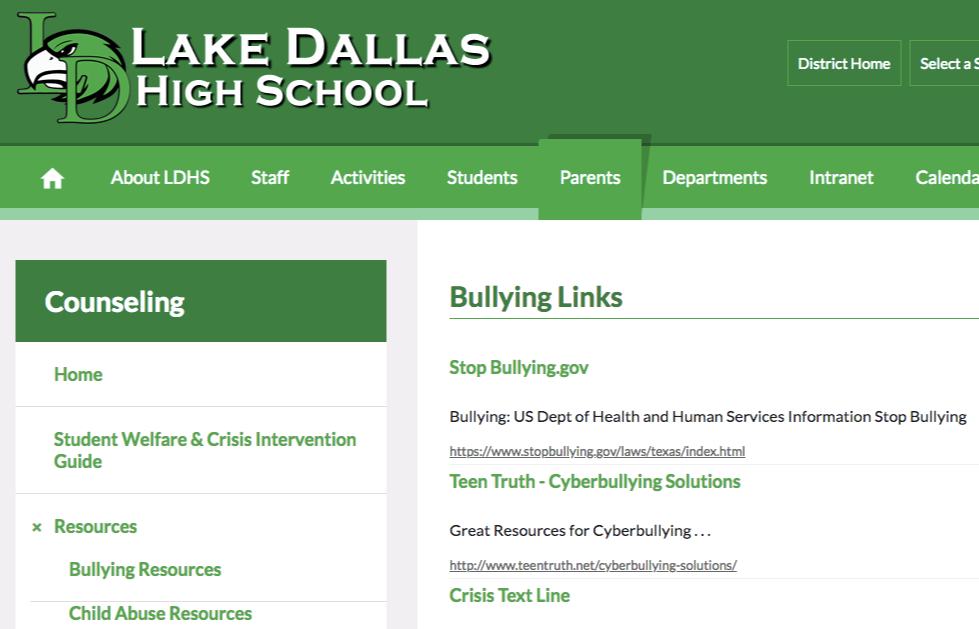
If you already have a scholarship program that targets high school students, you may add to your link prospecting list new high school scholarship pages by searching for them using the following search queries:
- site:.us ~resources "high school" scholarship
- site:.org ~resources "high school" scholarship
- site:.net ~resources "high school" scholarship
- site:k12.ny.us ~resources "scholarship"
3. NO FILTERING
It's easy to get lazy and collect any scholarship pages you may find.
That's not how you increase your response and conversion rates. Spend a few seconds checking the scholarship page if it's worth reaching out based on obtainability.
Assess if the page links out to other scholarship programs by commercial websites. Whose audience does the scholarship resource page cater to? If it caters to law students and your target is just medical students, acquiring a link from the page is impossible.
Alternatives to Scholarship Links
Not all businesses can utilize scholarship link building as part of their link acquisition arsenal, so there are alternatives to going for the same kind of audience - students and teachers. They are usually the people you'll be conversing with to get links from .edu and high school pages, and they should own the email address you're contacting for a link request.
Here are some alternatives to scholarship links that can improve the quality and quantity of your backlink profile.
1. EDUCATIONAL RESOURCE PAGES
I've covered this in my post about do follow backlinks, and this has been a valuable strategy for tapping a resource type of page that is not mostly getting pitched by SEOs and webmasters.
Building backlinks from primary schools is simple. It only requires an educational content piece that addresses a need of a student in terms of a subject topic and behavioral concerns.
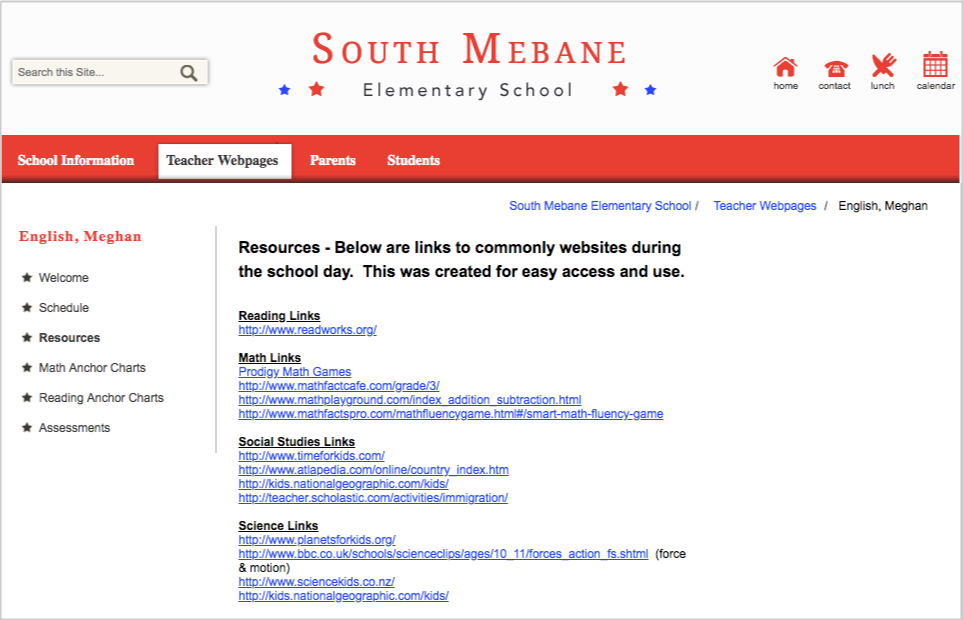
You can also serve teachers with your teaching content (e.g. ESL content piece) that can lead you to earn links from teaching and curriculum pages.
2. LOCAL HOUSING RESOURCES PAGES
One local link building tactic that is worth investing your time and effort in is acquiring links from local housing resource pages.
Whether it is a summer housing or off-campus housing page, it is highly valued to get a link that can generate exposure to brands these pages linked out to. It's a semi-automated lead generation since these pages directly recommend rental offerings available within an area.
If you're in the real estate industry, i.e., a local apartment brand, or a housing or rental service company, you can take advantage of such a strategy by targeting these local housing pages.

These terms can help you start with your link prospecting process:
- “Off-campus” housing [city] “resources”
- “Student housing” [city] “resources”
- “Internship housing” [city] “resources”
3. COLLEGE TOWN BLOGS
Students have their own network of blogs (not the student blogs of .edu websites), by which they get some help from their school advisers.
I've found that college town blogs are looking for unique external contributions. These blogs are co-owned by students from different universities.
It's not like run-of-the-mill guest blogging, where you can pitch any generic content you can think of. You have to glance and read at least a few recent articles published on the college town blog to get some knowledge about what topic works best and can resonate with their target readers.
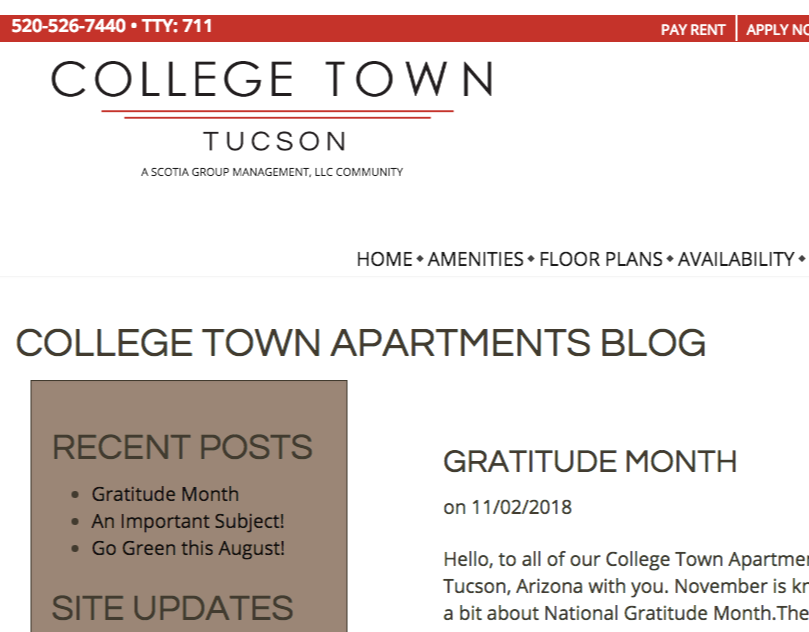
Aside from editorial links from relevant blogs that accepted your guest contributions, you can also easily submit your content works to the college town blog to get another link and diversify your backlink profile.
If It Doesn't Work, Try Another One
The good thing in the SEO industry is that we can all experiment on what type of links we will acquire for a particular website — allowing us to reflect and assess results from our past and current link building campaign.
While doing so, we can take another approach and see if another link building strategy that hasn't been abused much can work for us. Through testing, hard work, and proper strategy, one can discover a tactic that can work effectively year after year for a link building campaign.
Scholarship Links Frequently Asked Questions
How do I find hidden scholarships?
To find hidden scholarships, start by utilizing online search engines and scholarship databases such as Fastweb, Scholarships.com, and Chegg. Additionally, contact your school's financial aid office, local community organizations, and professional associations for potential scholarship opportunities. By casting a wide net and staying proactive, you can increase your chances of uncovering hidden scholarships.
Is Fastweb scholarship legit?
Yes, Fastweb scholarship is legit. You can trust that all the scholarships you find on Fastweb are 100% legitimate and reliable options for funding your education.
What is the largest scholarship database?
The Fast Web Scholarship Search offers the largest scholarship database with over 30 million registered users. As the most accurate and popular free scholarship search site, it provides students extensive opportunities to find financial aid for their education.
Is scholarship com a legit site?
Yes, Scholarships.com is a legitimate organization that offers scholarships and financial aid resources to students. Their website is trusted and widely recognized in the education community, making it a reliable source for finding scholarships.
SEO For Personal Trainers
Personal training is a growing industry, with a 24% increase in personal training and fitness instruction jobs between 2010 and 2020.
It's no wonder why it's becoming an in-demand and popular industry. It's also becoming more competitive as personal trainers market themselves online.
Search engine optimization for personal trainers is vital in the process. Content creation and link building require effective tools and techniques to maneuver rankings for personal training-related keywords.
This post focuses on effective content creation techniques for the personal training industry.
Create "Anything That Counts" Content
If you are handling a personal training client, you'll find all sorts of articles about fitness. One theme of topics that gains traction in terms of links is how to count/calculate topics specific to personal training.
People want to know their current physical standing - in one part or part of their body. If you can provide rough estimate counts, your content would help suffice their needs.
Here are some examples of count-related keywords in the personal training space:
How to count macros
How to calculate lean gains macros


Make it comprehensive, but more so, add meaningful content formats such as charts, infographics, and even a simple calculator. It would require investment, but it's worth it if you can dominate the search result for a target keyword with substantial search volume.
The next question is, where can you find these "how to count" or "how to calculate keywords"?
There are two approaches that you can choose from.
The first method is checking personal training competitors for keywords they rank. It will quickly reveal keyphrases where published content assets served those queries.
Plug in one of your competitors' domains. Go to Ahrefs' Organic Keywords data. Filter the results by including keywords like "how to count" or "how to calculate", so you would only have keyphrases with those exact words.
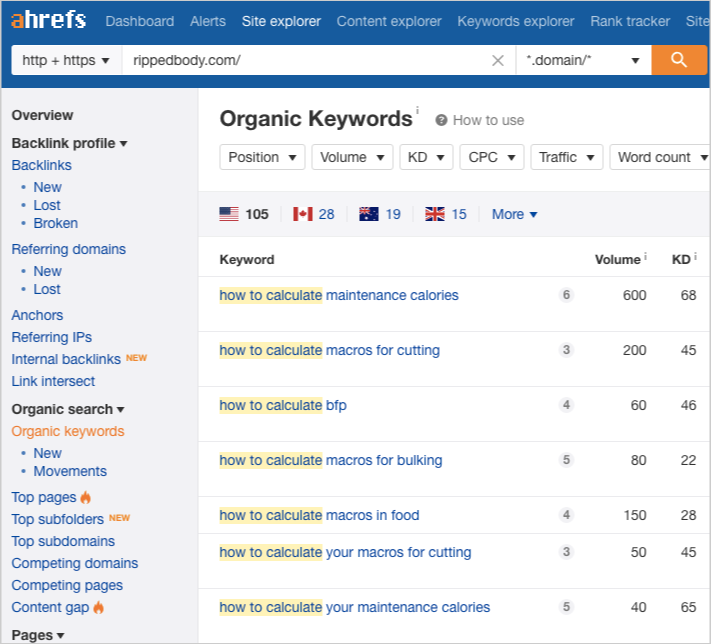
Sift through the list and get industry terms to create content confidently.
The second approach to getting counting ideas is to discover gold mine topics on Reddit. The way to do this is either directly searching it on Google (see the first image below) or plugging Fitness sub-reddit in your link building tools (for this example, I use Ahrefs).
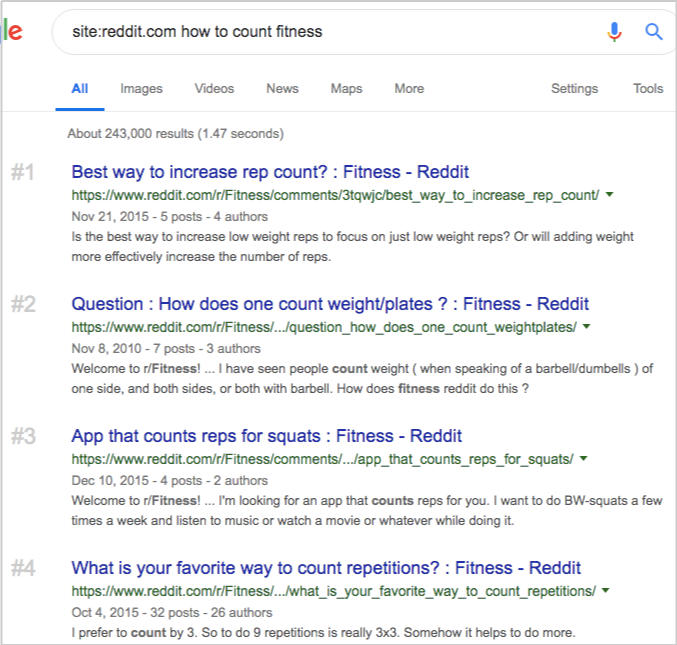
Pop in the same words (how to count or how to calculate) in the inclusion filter of Ahrefs.
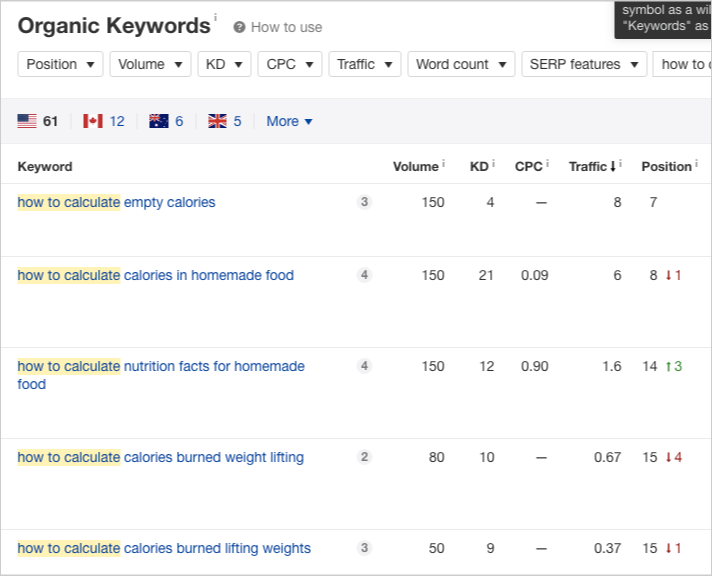
From here, you discover content ideas that the Fitness subreddit ranks for.
Publish Guides for Unfamiliar Terms
Jargon and industry technical terms may not be familiar to your target audience. So, publishing content assets on your blog dedicated to elaborating on those terms and giving more specific information about them is a big plus to your content marketing campaign.
Some examples of guides define and discuss some personal training niche terms.
Intermittent Fasting
Leangains 
Show off your expertise by publishing technical guides. By being at the forefront of content creators who craft expertly-written online assets on subjects only specialists can best write, you'll have a better advantage in ranking for some of the most competitive keywords.
Here is a recent useful slide deck by Lily Ray of Path Interactive on leveraging E-E-A-T for SEO success. The "E" in E-E-A-T stands for Expertise.
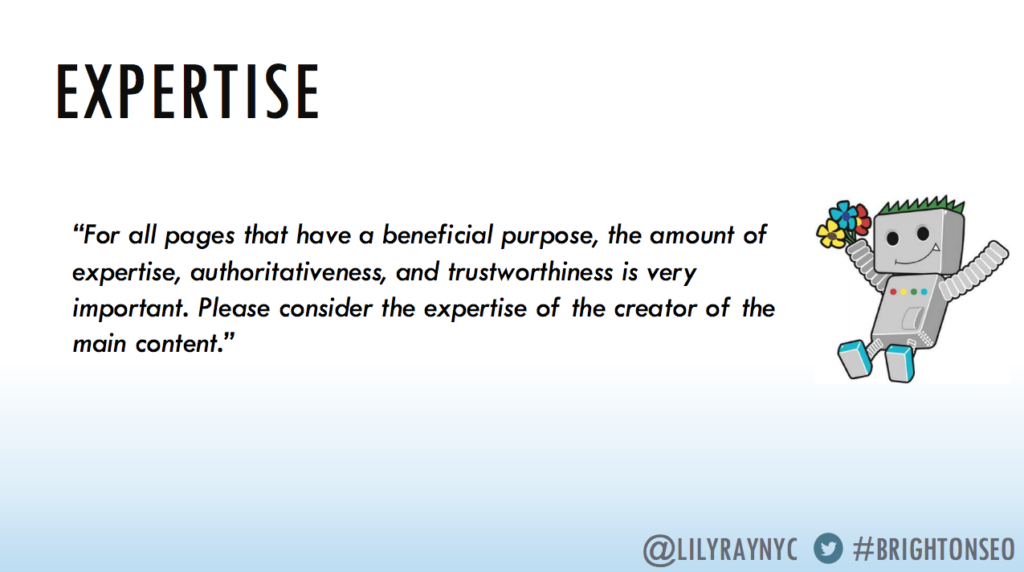
Content Republishing
Content republishing works perfectly for personal training websites. The idea is to find content assets published years ago. Still, it has been recently re-published given the topic relevance to its current date - its potential traction to gain new traffic and links and mentions from new people who might need the topic information.
The process of content republishing goes like this:
- Start by identifying topics being republished using Ahrefs Content Explorer's new features (publishing and republishing dates).
- You can add more filters to the search results to only discover linkable topics - i.e. add a referring domains filter with 100<.
- Go through each topic and find the ones you or your team can produce.
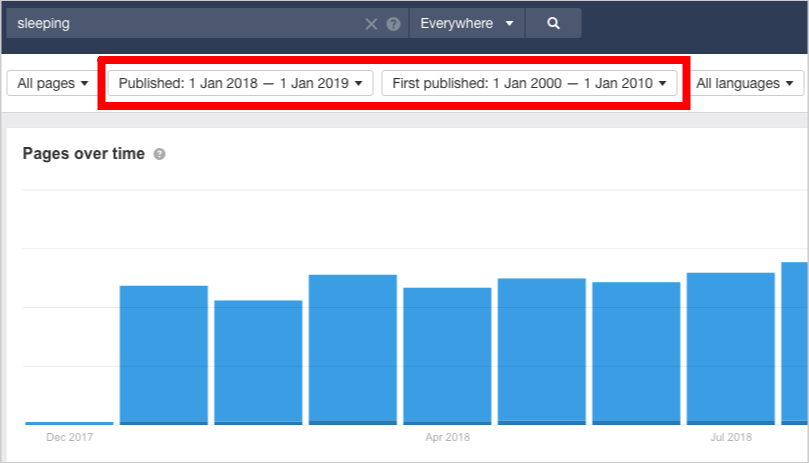
Find ways to leverage content formats for your chosen topic to make it more comprehensive than what's already been published. For example, you can integrate data charts to appeal to visual consumers.
There are two subreddits that you would find very helpful in getting inspiration for data visualization:
Determine Historical Hot Topics
Aside from digging into evergreen topics that often get republished using Ahrefs' Content Explorer, you also want to look out for historical hot topics. These are topics that seem to come back year after year.
In almost every industry, you'll find these topics that don't change over time but are updated only with new tools, strategies, and techniques. Historically hot topics may be issues, pain points, and problems that are often experienced in daily human lives.
For personal trainers, one evergreen topic is procrastination. Whether in 1962 or 2025, this topic keeps coming back every year for sure. The only thing that varies is the verbs accompanying the topic, so phrases like the following are getting searched at the highest level:
- how to overcome procrastination
- how to avoid procrastination
- how to beat procrastination
- how to fix procrastination
- how to get rid procrastination
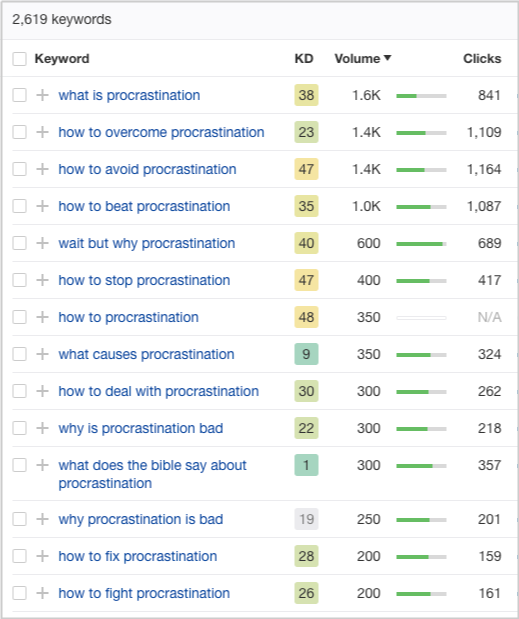
Join subreddits, slack groups, and niche forums to understand what your community often discusses. You can identify historical hot topics if you are heavily involved in community engagement.
Content Generation Matters in Personal Training
Among verticals, the personal training industry is heavily producing content and introducing new content types and formats. A niche, you'd get inspiration for content ideas if you look at them regularly.
SEO for Personal Trainers Frequently Asked Questions
What is SEO in fitness?
SEO, or Search Engine Optimization, is important in the fitness industry to ensure that your gym's website appears in search engine results when potential customers search for keywords like "gyms near me" or "fitness center". By optimizing your website with relevant keywords and content, you can increase visibility and attract more potential customers to your fitness business.
How do I promote my PT business?
One effective way to promote your personal training business is to leverage social media platforms. Create engaging content, share client success stories, and offer helpful fitness tips to attract potential clients. Additionally, collaborate with local businesses to cross-promote services and consider offering special promotions or discounts to drive more traffic to your business.
How do I market myself as a personal trainer?
One effective way to market yourself as a personal trainer is by utilizing social media platforms like Instagram or Facebook. Create engaging content that showcases your expertise, provides valuable fitness tips, and posts success stories from your clients. Additionally, consider offering a free consultation or hosting workshops to attract potential clients. Use appropriate hashtags and engage with your audience to build a strong online presence.
How do personal trainers get leads?
Personal trainers can get leads by leveraging bring-a-friend sessions, as this tactic relies on existing clients to spread the word and generate new leads. This highly effective approach allows trainers to expand their client base without relying solely on traditional marketing methods.
How to Use HARO For Backlinks
What is HARO?
Help a Reporter Out (known as HARO) is a free service that connects journalists and publishers to content contributors with the aim of securing valuable media coverage for brands and individuals.
If you are a brand looking for publicity, don't look further than HARO. It has a lot of benefits that you could never imagine only spending 30 minutes to 1 hour a day.
Benefits of Using HARO
1. Free service
HARO is a must-try for you if you're looking for ways to promote your brand without spending much on high-priced tools.
Its premium features allow more filtering and offer more opportunities to maximize your strategy of using it, but HARO's free service is a good start for new and established brands.
2. Easy to respond
Many available platforms connect you to publishers and journalists, but most will require you to participate inside the platform.
There's nothing wrong with it, especially if you're trying to put all campaigns in one place. However, if you're only working on one site, you want the flexibility of communicating with the publishers at your own pace.
HARO can easily send story requests straight to your emails. You can reply to them either you're on desktop or mobile.
3. Personal branding and thought leadership
Personal brand, as originally coined by Tom Peters in a Fast Company article, "The Brand Called You", are figuring out how to transcend the narrow boundaries of their categories and become a brand surrounded by buzz. He forecasted that human beings would think of themselves as a unique product.
If you can personally put your brand ahead by showcasing your expertise on a subject matter, HARO gives you a way to do that.
Knowing the subject matter and being known for it are two different things. Through journalists' requests for questions to be answered, you are hitting two birds with one stone: getting more exposure and targeting an audience your brand can offer (servicing their needs).
4. Social proof
Getting featured in top publications in your vertical can be used as social proof on your website. Whether it's a logo you can include on the most visible sections of your homepage or use it as additional credibility to your guest posting portfolio, both give leverage to push your brand further out there.
How Does HARO Work?
Sign up as a source.

After you sign up, you'll get three emails a day — scheduled at 5:35 a.m., 12:35 p.m., and 5:35 p.m., ET from Monday to Friday.
Those emails come from journalists requesting additional content contributions, interviews, and even quotes for stories they are working on.
You, as a source, respond to their requests, and these journalists will respond to you if they find your response fits their needs.
Finally, you get featured in their publications.
How to Use HARO For Backlinks?
Many people overcomplicate the process to use, but the reality is that it’s not that hard.
Here’s how to use HARO in four simple steps:
- Choose relevant topics.
- Set up emails through filters.
- Set up IFTTT for important requests.
- Choose relevant HARO inquiries.
Choose relevant topics
To maximize the use of HARO, choose topics only relevant to your brand. Don't waste time trying to pursue topics you don't have expertise in.
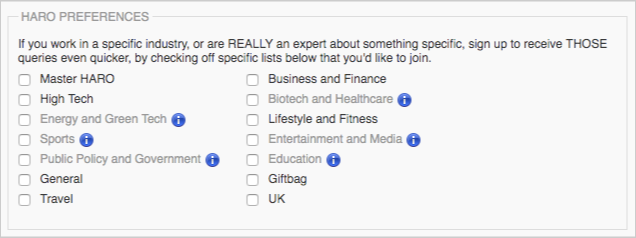
Checkboxes of industries where you can highly participate in content contribution. You may be tempted to check all, but it will only add clutter to your HARO emails.
I highly recommend only choosing one or two that best fit your site. If you're an agency, it's no doubt you choose all for your clients — and only filter the emails based on categories and expertise once they arrive.
Setup emails through filters
Once you properly set up your emails, you'll receive emails listing journalist HARO queries connected to your topics.
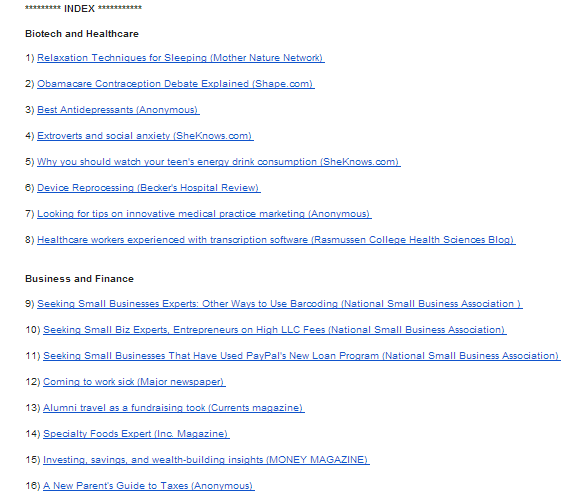
Furthermore, create filters for all emails ‘from:haro@helpareporter.com’ inside your inbox. Here are the filter options you can use:
- Apply the label — label a category to HARO emails as soon as they arrive, so you can quickly prioritize them at times (particularly if you're getting hundreds or thousands of emails).
- Never send it to spam - it prevents any HARO email from getting caught in your spam filter.
- Categorize as Primary — to quickly transfer those HARO emails to your inbox's Primary Tab.
Setup IFTTT for important requests
To ensure you can respond to important requests, you can set up IFTTT (If This Then That) to update you quickly whenever there are new HARO requests.
The advantage of doing so is that you can respond immediately to email requests while on mobile. It works best for people outside the US/UK timezone, as you can do the HARO strategy even while away from the office.
If you want to use more of the technique, here are some IFTTT tricks to help you with semi-automation activities.
- Create an Applet to get an SMS sent to your cell phone whenever you receive an email from a HARO inquiry focused on a specific topic.
- Craft a draft email response in your notes so that when you receive an SMS alert of a new HARO inquiry, you can simply replace a few fields in your response template and send it to the journalist as quickly as possible.
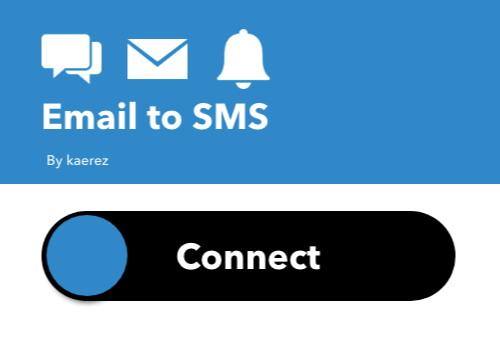
Those IFTTT initiatives can help you to stay on top of PR requests.
Choose relevant HARO inquiries
Scan your HARO emails quickly. Choose inquiries that are most relevant to your small businesses. Look at categories such as Business and Finance.
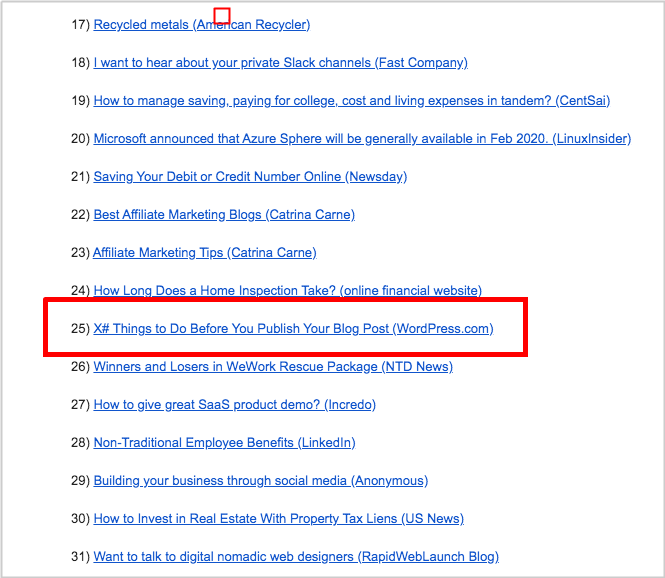
That's why it's important to identify your (or your brand's) expertise, given that it'll be easy to make choices when reading HARO emails.
Next, the most difficult part of this HARO strategy is writing pitches that work.
How to Write a HARO Pitch That Works
Needless to say, journalists receive several responses for HARO pitches.
Like you, brands, agencies, and individuals are ready to send their replies as soon as they can.
But you can't simply send quick emails without thinking about your content properly. You may end up pitching tens of emails daily without getting much return from the strategy (i.e. contextual links).
You can't shortcut our response to an inquiry.
Here are some tips for writing a HARO pitch that works effectively:
- Get in early.
- Read the instructions carefully.
- Make subject lines relevant and clear.
- Write a concise email.
- Send appropriate attachments, quick bio, and headshot
- Build a mutually-beneficial relationship
- Seek out freelance journalists
1. Get in early
This tip should be first in line.
You can craft a highly effective HARO pitch, but if it's done 24 hours after you receive the HARO email pitch, you won't get much success with it.
Timing is important. Respond as quickly as possible to HARO emails. Your response time should be as 30 minutes as possible.
However, make sure you deliver a good-quality response. It won't cut if it's just an early response yet a crappy contribution.
2. Read the instructions carefully
In most cases, journalists or publishers, whether from big publications like Mashable, Wall Street, or New York Times or from a niche authority publisher, provide explicit instructions to follow. These include what type of content they need you to submit, what they're actually looking for in a contributor, and even what not to do.
It's important to read those instructions before jumping to write your email.
3. Make subject lines relevant and clear
For example, if a HARO lead is a journalist writing a blog post about "personal kanban productivity", your email subject should be as straightforward as this one: HARO: Personal Kanban Productivity.
You want to make sure your email subject line is 100% relevant. This will cut through the noise of other responses to that same HARO inquiry. The same principle applies to every other outreach campaign, like blogger outreach.
4. Write a concise email
The last thing you want to do is to craft an email that's worth 10 minutes of time to read.
The key to writing a HARO pitch that works is to keep it short.
First, do not promote yourself in the email - you can add it later. But don't start your email with a full background of yourself and what you do.
And don't ask for links very quickly. I'll discuss later how you'd ensure links from your quoted contribution. But for now, focus on the value of your contribution.
The simplest way to concise your email is to write 2 to 3 bullet points with data that would help the journalist on the article he/she is writing.
Focus on the goal of being quoted as a source in the article. Publishers and journalists don't come into HARO and ask for an entire article — remember. They're looking for a tip, data, or a short-form text for the content piece they're creating.
Here is an email template from ____ that you can play around with—split test repeatedly depending on your needs.
Hi [Journalist's Name],
My name is [Your Name], [short bio]. Here is _____________________:
1-2 sentences.
1-2 sentences.
1-2 sentences.
I'd love to talk more and help you with your article. Just drop me a line at [your email] or [mobile number].
- [Your Name]
Keys to success:
- No overpromotion in the first contact. By offering much help in the first place, you can instantly build a rapport and get returns in the long run (more on this later in the relationship-building part).
- A quick introduction is important, like any kind of email.
- Send a succinct content contribution to a HARO inquiry. Write exactly how you want it to appear in the article.
- A contact end line at the end of the email address helps the publisher to contact you immediately if there's any revision he/she needs in your quote and wants more of you to discuss what you contributed.
5. Send appropriate attachments, a quick bio, and a headshot
This is the moment you can't be aggressive with follow-ups.
Remember, HARO journalists get a gazillion requests for including short content all the time. It may take a while before they respond to your HARO pitch.
But once you receive a response from them, they may ask you for any appropriate attachment, a quick bio of yours/your brand, a headshot, and additional contact information to the content you've contributed.
A good recommendation is to upload your headshot to your website or Imgur and simply send them a link in your HARO response instead of attaching it to the email.
6. Build a mutually-beneficial relationship
Achieving success with your HARO pitches can be repeated as long as you can deliver good content to the same journalist.
Build relationships with publishers. Ask them gently to get back to you if there's another opportunity to work together.
Tell them you are open to working with them and providing all the details they need.
Don't just contact them when you want something — find something useful first relevant to what they want to write about and send it to them.
Build trust more than just getting a link.
You can check out this guide on the best email outreach tips to further enhance your relationships with publishers.
7. Seek out freelance journalists
You would find journalists doing freelance work — these are the ones who write for several different publications simultaneously. They have ongoing relationships with different publishing sites and have a huge network of content creators they partner with.
If you can connect to these people, you'll have a chance to acquire more inbound links from their connected sites.
One good way to leverage this strategy is to set up alerts for any new articles written by freelance journalists you've engaged with.
Start sharing their latest articles on social media and comment on their content as soon as it is published. This initiative would help you put it on their radar and increase the chances of getting more HARO opportunities.
You may sometimes share new content ideas with them via email or add additional input. This is a perfect way to follow up with them and potentially acquire editorial link or a social share.
What do you do next when you don't get a response from your HARO lead?
Monitor your HARO placement.
How to Monitor Your HARO Placement
You won't always get a response from your HARO journalist — so the best way to stay on top and identify if you get a mention or your quote gets cited in an article is to monitor your link placements.
You can use Google Alerts or Ahrefs alerts to keep track of the quoted person/brand you've included in your HARO pitch. It's important to remember what you've included in your contribution as a contributor — that will be the element you'll be monitoring.
HARO Link Building In Action
This guide will not end without a short case study of how I do it as part of our digital PR services.
The process I've shared is exactly the same workflow I followed to get a contextual link from Inc. Asia:
So here's how it started.
I signed up for HARO, chose preferred topics that I'd like to contribute to HARO requests, and scanned daily emails.
Then I stumbled upon this HARO inquiry. It perfectly fits my background - an ASEAN entrepreneur and someone who loves productivity at best.
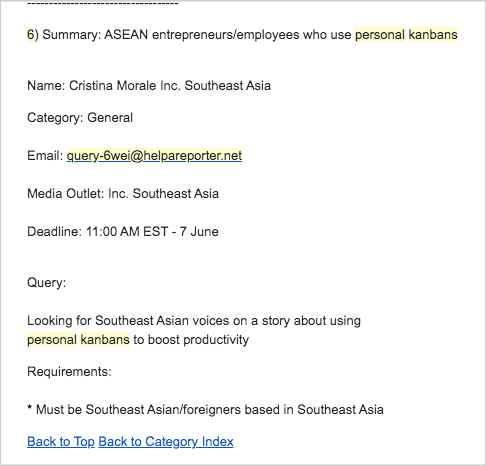
I respond quickly with a short and concise response. As you can see below, there aren't any bullet points yet, as there is no instruction or direct questions from the inquiry. So this is an exemption to the rule of adding bullet points. Always check the instructions if these are included in the HARO inquiry.

Then I received a response from the journalist - asking me questions.
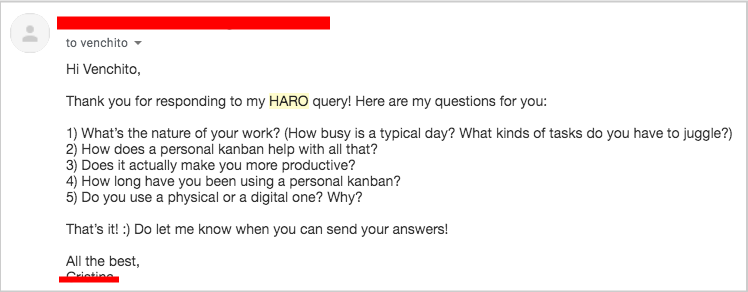
Without a doubt, I submitted my response - quite lengthy as it answers 5 questions.
Here's where I'll stop for a moment.
I got the link already, but there's another opportunity for another backlink. You may also want to set up a Google alert to monitor your mentions.

To make the long story short, I submitted another response to her next questions and got another link.
Keys to success:
- Respond quickly as as you can.
- Be straightforward to send your response.
- Build relationships with the journalist/s - you might get another feature in his/her story.
Advanced HARO Tips
We've covered how to write a HARO pitch that works. You'll have to start from there and test it by changing elements to keep it short yet adding more value to the journalist you're pitching to.
There are techniques you can test out yourself that will add incremental success to your HARO strategy.
Here are some advanced HARO tips you can apply directly to your campaign.
Request for homepage links
If you get a link in your mention for your contribution, you are extremely happy with it, especially if it's from a high publication site.
You get a contextual link, but having a link to your homepage isn't amazing.
There is one way to do that: request a homepage link.
It may be easy as it sounds, but you have to look at what types of content you have suggested to be included in your HARO pitch. You need to have a good reason for a link to a homepage.
If contextual fits, such as group interviews, quotable mentions, and the like, getting a link to a homepage link isn't much to ask. Looking at it from a reader or user perspective is more natural. If they want to know more about the brand or who quotes the tip, then they would simply click on the homepage link and see more details.
Respond via Twitter
There are times when there is an instruction in a HARO inquiry to connect via Twitter.
If you choose to respond via Twitter, email them so they can contact you directly, or you can offer to DM their details.
This kind of initiative speeds up the back-and-forth process of communication.
Send content that requires less editing
When responding to HARO inquiries, always be mindful of your journalist.
You want him/her to spend less time editing your content. Do the content legwork for him or her. He or she should easily plug what you've contributed to their articles.
Given that, if your short-form content piece isn't quite fit, it could be a lost opportunity.
Use a compelling angle in the introduction
Many HARO pitches will have a templated introduction of what they do or what their company does.
While that may work if it's the right fit for what the journalist is looking for, I suggest you find a compelling angle relatable to their current inquiry.
This way, you're telling the journalist you deserve the quote, as you know about it. Don't mention links at all
Most journalists are irritated with people asking for links when they haven't contributed much value to their HARO pitches.
Don't worry. You can ask for a link after your short-form content has been approved.
But during the engagement, stay focused on the value of your HARO pitch.
What You Get With HARO Paid Accounts
The first advantage of subscribing to a paid account in HARO is that you can set up your own profile or bio — which can be included in your pitches.
Though you can do it quickly with your free account, your bio that includes your website URL and your social media profiles, when easily plugged in straight to your pitch, can lessen the time adding it to your email every time you respond to inquiries. This saves you enough time for crafting emails.
Another good thing with HARO paid account is that you can add details related to the specific areas of your expertise and any previous publications in which your brand has been featured.
Moreover, with a paid subscription, you can set up alerts for HARO requests that match the specific keywords you prefer. You may even get SMS alerts if you're in the US.
Many extra features with paid HARO accounts can help you secure more media mentions for your brand.
Passive Way of Acquiring Links
Using HARO may not always give you what you want, such as links from mentions, but if you're doing link building, the strategy is worth the investment of your time.
All it takes is for you to respond to 4 to 5 targeted leads a day to get press. You spend only 15 to 30 minutes crafting a relevant and value-adding message for each HARO inquiry.
Have you succeeded in using HARO as one of your techniques to secure media outlet mentions? Share some tips that work for you in the comment section below.
How to Use HARO For Backlinks FAQs
Is HARO good for link building?
Yes, HARO is a powerful link building tool, especially for beginners. Despite lower conversion rates, the provided backlinks offer significant traffic and link equity benefits, fueling long-term business growth.
What is a HARO backlink?
A HARO backlink refers to a backlink obtained through the platform Help a Reporter Out (HARO). It is a valuable source for connecting with authoritative websites, gaining quality links, and organic referral traffic. HARO offers a safe, trustworthy, and cost-effective (free) method for building natural backlinks.
How do you use HARO as a source?
To use HARO as a source, sign up for the service and regularly browse the queries from journalists. Respond to relevant queries with thoughtful and concise pitches, showcasing your expertise and providing valuable insights. If your response is chosen, you'll receive media coverage and potential backlinks to your website. Stay active, consistent, and focused in your responses to increase your chances of success with HARO.
What is HARO technique for SEO?
The HARO technique for SEO, also known as Help A Reporter Out, is a service that connects journalists and bloggers with subject matter experts. Journalists and bloggers submit queries, and subject matter experts provide input. This technique helps increase visibility and credibility by being featured in media outlets and gaining backlinks. It improves SEO by enhancing website authority and driving organic traffic.
How to work with HARO?
To work with HARO for PR link building in SEO, start by signing up for a free account on their website. Once registered, regularly check your email for HARO's daily queries from journalists and bloggers relevant to your expertise. Respond to these queries with valuable insights and include links to your website or blog for backlink opportunities. Consistency and relevancy are key to successful HARO link building.
How to be successful with HARO?
To be successful with HARO, follow these 10 tips:
- Research the reporter's previous work.
- Craft a concise and compelling pitch.
- Personalize your message.
- Provide valuable insights or data.
- Respond promptly.
- Be concise and clear.
- Include your credentials or expertise.
- Use bullet points or numbered lists.
- Follow up politely.
- Build relationships with reporters.
By implementing these strategies, you can increase your chances of success with HARO.
What is the purpose of HARO?
The purpose of HARO, or Help A Reporter Out, is to connect journalists and publishers with story sources. It is a platform where journalists can request subjects for their articles if they struggle to find suitable sources. HARO helps facilitate this connection, making it easier for journalists to find the information and subjects they need for their stories.
How do you respond to HARO?
When responding to HARO (Help a Reporter Out), make sure to personalize your pitch, be concise, and provide valuable insights. Highlight your expertise and provide specific examples to stand out. Furthermore, craft a catchy subject line and adhere to the journalist's deadline for a higher chance of getting featured in their article. Following these tips can increase your chances of success with HARO responses.
Skyscraper Technique Link Building For SEO
The "skyscraper technique" by Brian Dean of Backlinko has reached its peak popularity because of its easy-to-follow process. Yet, it has produced effective results for most people who executed the methodology.
Of course, not all have reaped the fruits of their labor. Some have missed the objective of building and earning organic links through their skyscraper content (as well as ranking for keywords/search terms that might impact their overall campaign).
Here are reasons listed by Ross Hudgens why the Skyscraper technique may not be working (or can fail):
- Assuming skyscraper content (10x content) is an output of volume, not quality.
- Assuming content's ranking performance on search is solely based on its own quality, not who it comes from.
- Quality of content is realized by the volume of effort put into the creation, not by the value it provides to its users (e.g. definition of terms queries requires mediocre yet succinct content, not bigger content piece, to satisfy its users).
The aforementioned reasons do not disprove the effectiveness of the "skyscraper technique".
With proper strategy and thorough execution of each process phase, I guarantee you can hit your business objectives with the skyscraper strategy.
In this post, I'll share samples of my workflow and thought process - from content writing and production to the extensive content promotion of skyscraper content.
How to Use Skyscraper Technique?
Here are four simple steps to use the skyscraper technique by Brian Dean to get more backlinks to your website:
- Start by identifying frequently-searched topics.
- Ensure that there are many pages to link to ranking pages.
- Strategize how to outcompete link-worthy content
- Pitch linkers and influencers
1. Start by identifying frequently-searched topics.
Use keyword research tools (like Ahrefs' keyword explorer) to find topic phrases that have substantial search volume. The data should answer the question, "Are there enough people looking for the topic?".
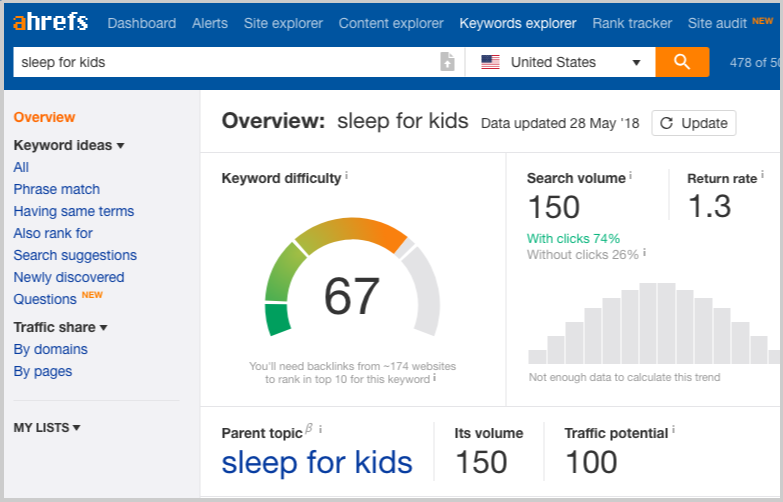
Continue doing your research by looking for keyword variations. These keyword variations can help expand your content's reach when included in your content piece (as they can help your page rank for secondary keywords and other long-phrase keyword variations).
AutoSuggest and Related Search Phrases (located below every search engine results page - SERPs) are handy features of Google that can help you find keyword variations of search terms.
Tip: You can use Ahrefs' Questions feature to discover related questions (which you can later select and include those you can answer in your content asset).
2. Ensure that there are a substantial amount of pages to link to ranking pages.
Get an idea of the linkability of the topic by looking at the first few pages of search results. See how many linking opportunities each page obtains (with Moz, you can glance at it quickly).
3. Strategize how to outcompete link-worthy content
During this point of the process, you can choose to proceed in either of these two directions:
- Create the content on the linkable topic and make it better than the first ranking pages for the target keyword/phrase.
- Choose one among the ranking pages, check if you can feasibly do better than it, and produce a more comprehensive content piece.
Whether you choose option 1 or 2, the mindset should be by the original Skyscraper process: find link-worthy content, make something even better, and reach out to the right people.
For this case study, I choose option 2.
I've found one niche website that ranked for the key phrase, "sleep for kids," - which is a microsite of an industry organization, the National Sleep Foundation.
When we reviewed the website, it only had 50~ indexed pages. Not all of these pages have valuable information about the main subject area (a content gap we can fill in the industry).
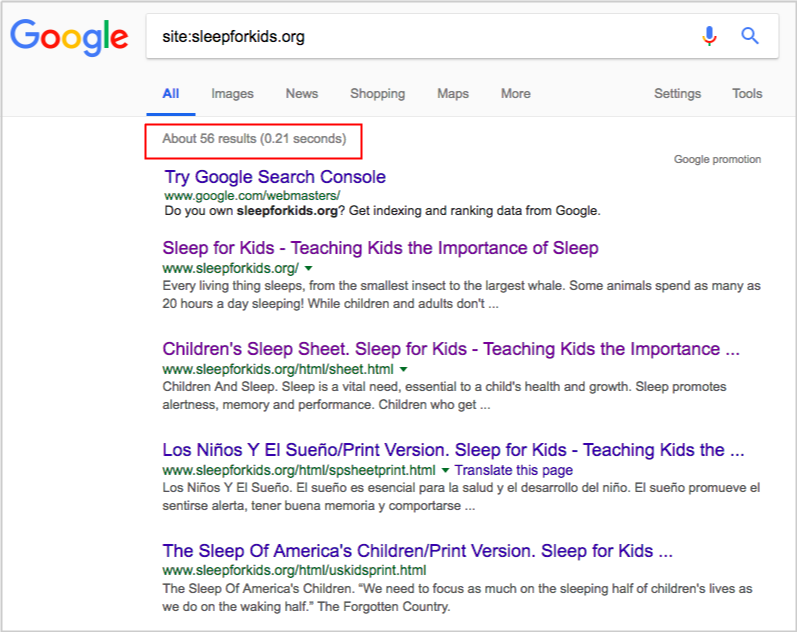
This leads us to choose this website as our starting point for creating the 10x content.
This opportunity of discovering a topic-focused site rarely happens - but if you've found one, it is best to consider the following things:
- How long does the site hasn't been updated?
- How many pages does the entire website have? Are they all under the same subject area?
- Are there any important topics not yet included that you can cover on your own content asset?
Strategize how to outdo the link-worthy content by creating an outline to visualize the outcome of your own content piece.
Ensure you look for important points not mentioned in their content. You can use Quora and Reddit to spot frequently-asked questions and cross-check them with their content (to see if those topics have been integrated).
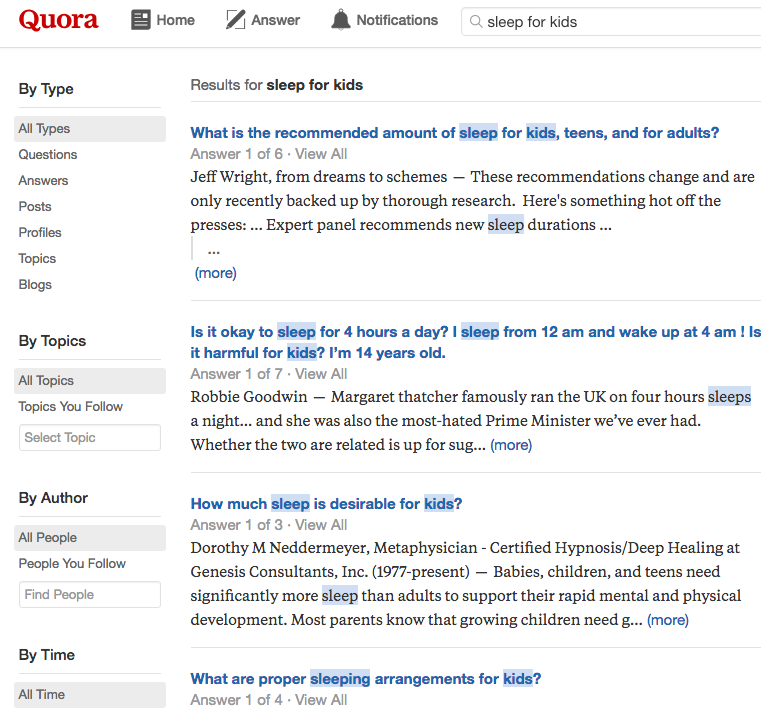
Increase chances of ranking your content piece in search by optimizing it for other secondary keywords that your competitors have included in their content.
You can use Cognitive Content Assistant tool to identify the exact keywords your content is missing and keywords you should use more often or less (in the case of keyword stuffing). Their Content Performance metric shows how likely your content is to be ranked higher.
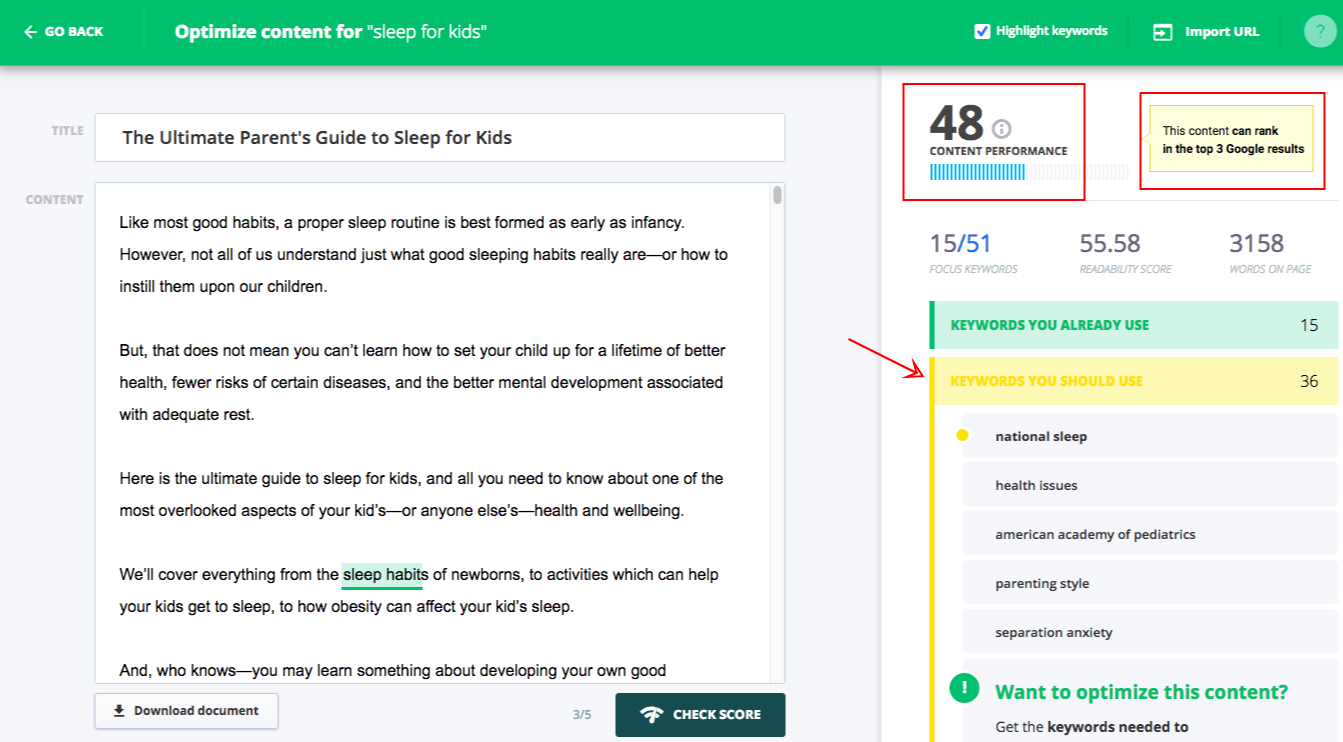
Moreover, incorporate any of the following content formats better to enhance the utility of your own content piece:
- Visual asset (turn interesting data points into a remarkable image)
- Case studies of your own (or of other entities/personalities you've asked permission to share on your own website)
- Audio or videos that better explain important points of your subject
- Interactive tools or elements to improve content consumption
For example, we heavily invest in infographics for our client's content assets only if data points are more valuable to present visually.
For example, the question found on Ahrefs' Questions feature (how much sleep for kids) can be best answered by gathering data points and turning them into infographics.
You can easily these other content formats to other sites or leverage them as guest blogging content (see guestographics).
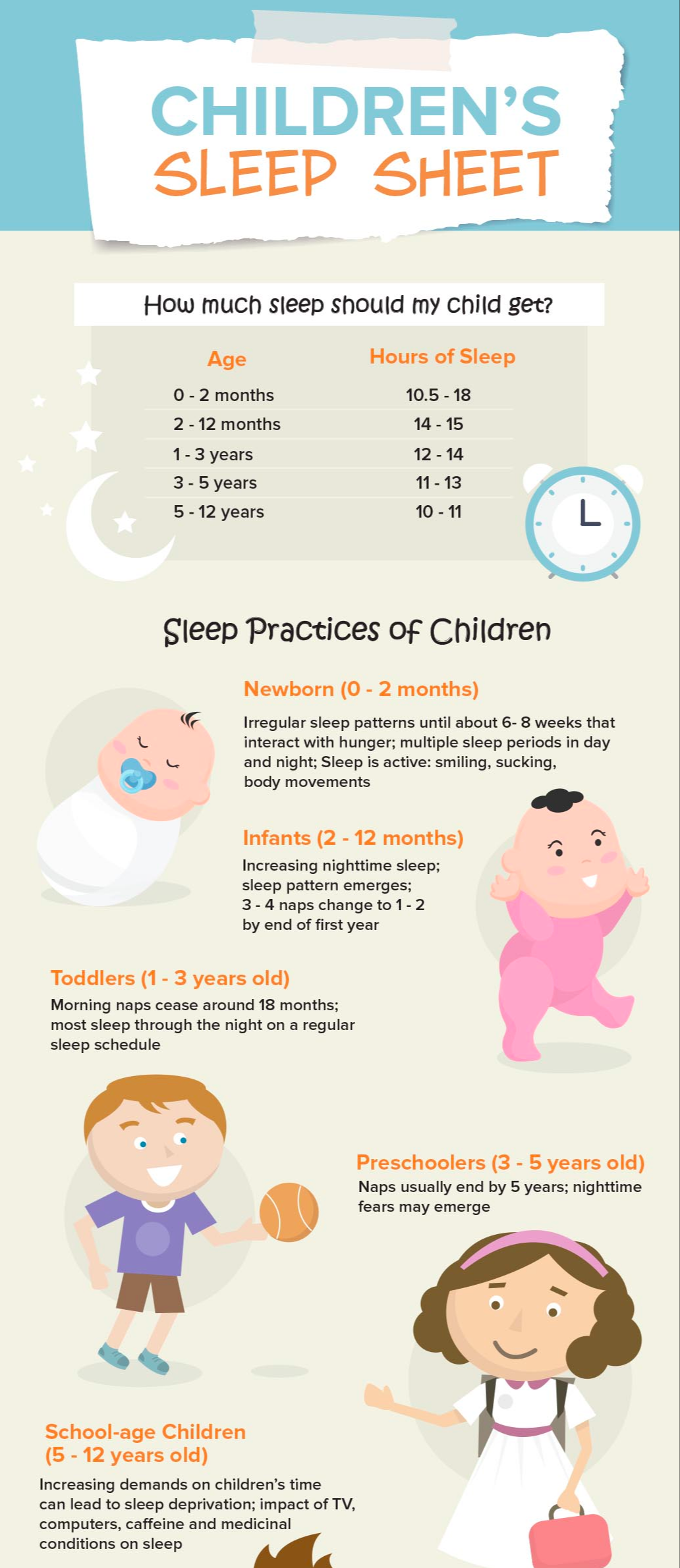
Overall, invest in making your content asset more valuable than your target link-worthy content (and other competitors' content).
4. Pitch linkers and influencers
Start reaching out to people who've linked to your competitors' content.
Invest time in crafting catchy and effective email subject lines to increase your outreach campaigns' open rate (as well as response rate). Here are some useful tips by Giselle Navaro (from her latest outreach article on SearchEngineLand).
1. Be specific about the format of your content

2. Mention the site when it matters

3. Convey the email's purpose.
4. Pitch your content to journalists in their language
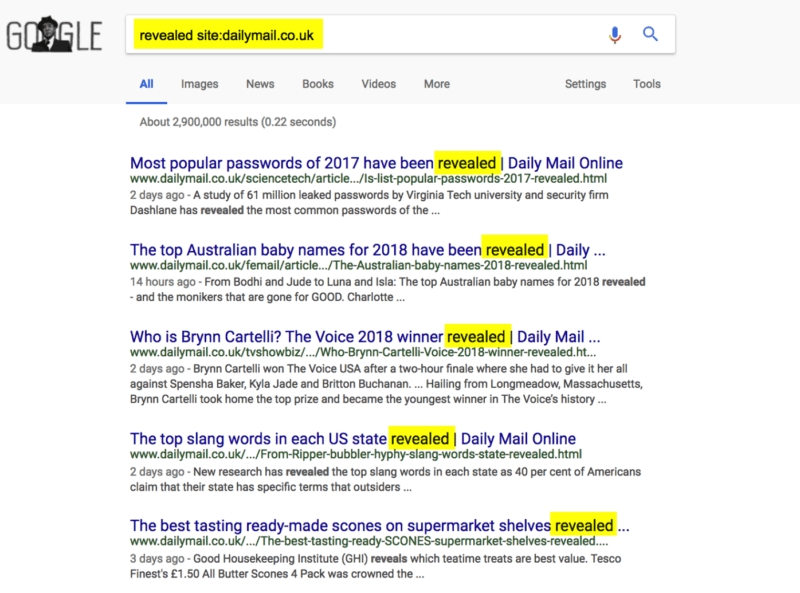
5. Choose a journalist’s headline as your subject line when following up
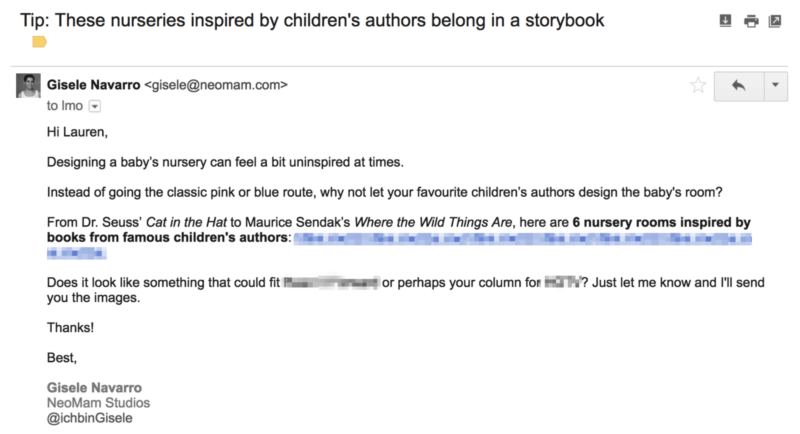
If it's a resource page you're trying to get links from. You can approach outreach by suggesting your content to reference their links page.
Another value proposition to make is to tell them about any broken links on their resource page (if you've found any) and propose your content piece alongside non-competitor content as replacements for their defunct links.
This outreach activity is included in another link acquisition process. Read our broken link building guide here with easy steps to follow.
Outreach Process in Action
Going back to our case study - sleep for kids guide, we've reached out to .edu librarians, other link curators, and webmasters who have linked to the competitor's content.


We further looked for other industry bloggers interested in including our visual asset to compliment their existing articles' content.
Then, acquire high-quality links:
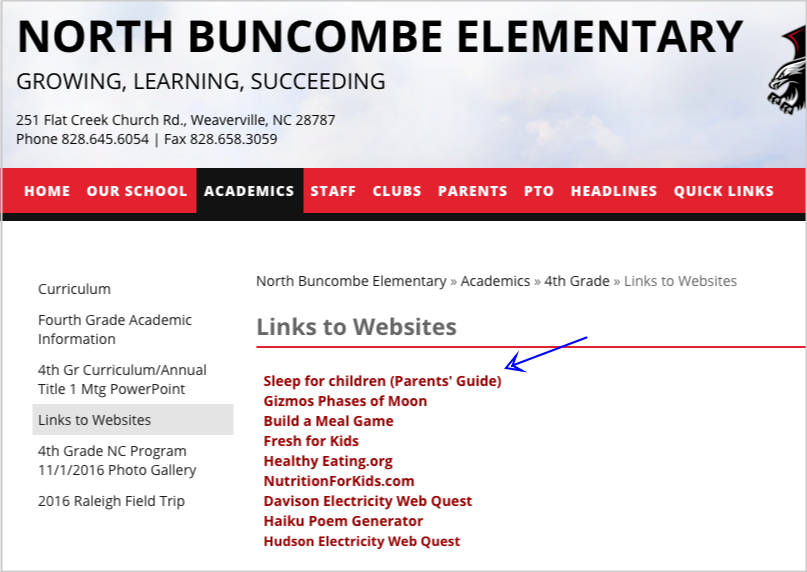
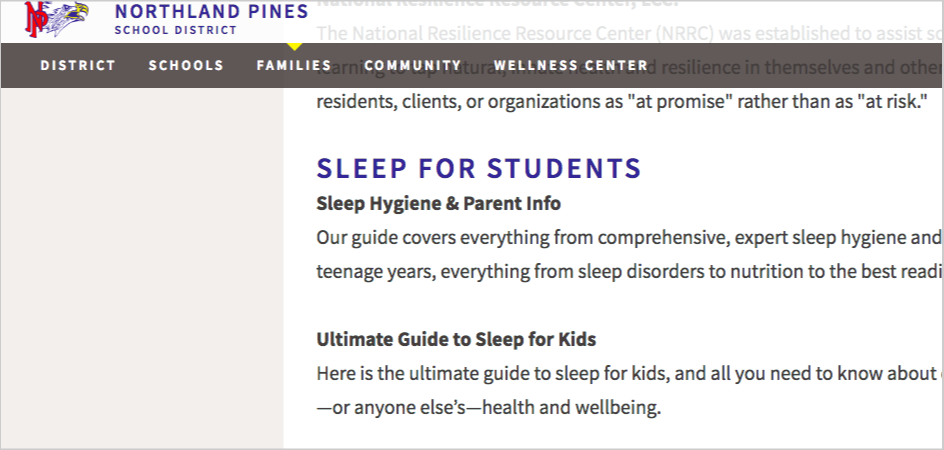
Securing links from these sites is only the first step. The relationships built with these webmasters can later translate to add relevant links to your other future content assets.
Need help with your skyscraper campaigns? Check out our link building services
Skyscraper Technique Link Building For SEO
What is the skyscraper technique in SEO?
The Skyscraper Technique is a renowned SEO strategy that enhances high-performing content and replicates its backlinks. Brian Dean coined the term because he believed people are naturally drawn to superior quality. This technique aims to drive more organic traffic and improve search engine rankings.
Does the skyscraper technique still work?
Yes, the skyscraper technique still works well in digital marketing. However, achieving success requires more than just a simple answer. To generate results in 2023, follow the tips I shared above to explore how to implement the technique effectively and provide valuable insights into its workings.
What is the skyscraper growing method?
The Skyscraper Technique is a popular link building strategy where you improve existing high-performing content and acquire similar backlinks to boost website traffic. It involves creating exceptional content, conducting competitor analysis, and contacting relevant websites for link building opportunities. Implementing this technique can enhance your SEO efforts and attract more organic traffic to your website.
What is the skyscraper technique in content writing?
The skyscraper technique is a content writing strategy with SEO in mind that involves creating high-quality, valuable content and reaching out to websites linked to similar but less comprehensive content. Offering a better version of the content increases the likelihood of them linking to your page instead. This technique is effective for link building and boosting your website's search engine rankings.
